2017年3月10日(金)16:10-17:00
シンポジウム「錯視のシステム視覚科学」
立命館大学システム視覚科学研究センター主催
立命館大学大阪いばらきキャンパス(OIC)
錯視をシステム視覚科学にする試み
立命館大学総合心理学部 北岡 明佳 email
色の恒常性錯視
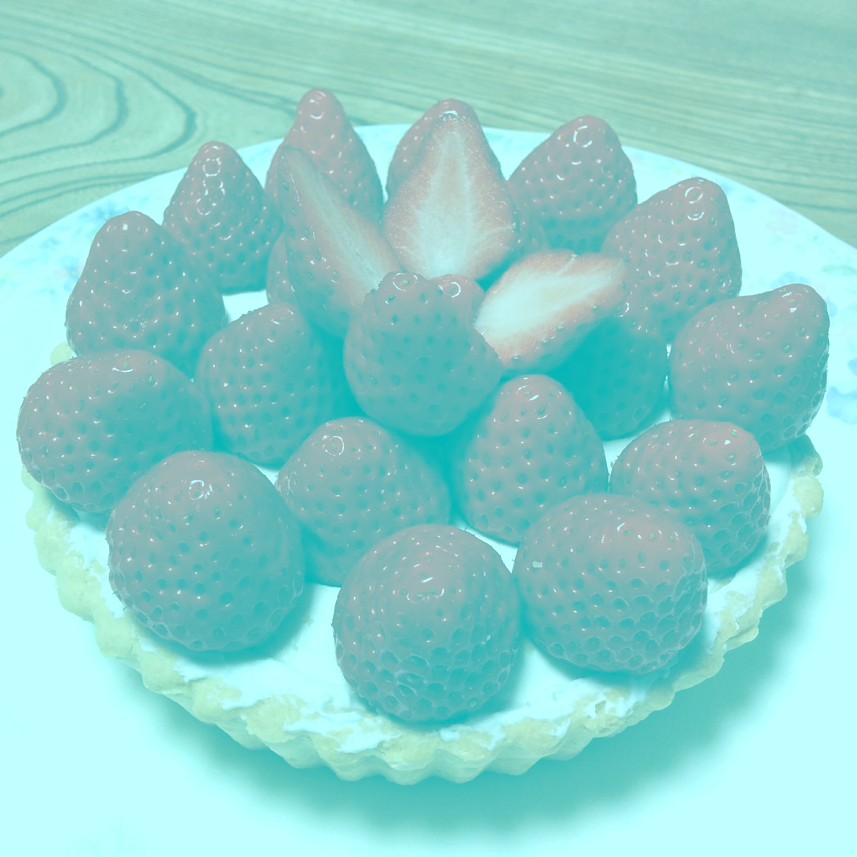
「赤く見えるいちご」
すべてのピクセルはシアン色近辺の色相であるが、イチゴは赤く見える。加法色はシアンで透明度は53%の加法的色変換。
Copyright Akiyoshi Kitaoka 2017 (February 28)
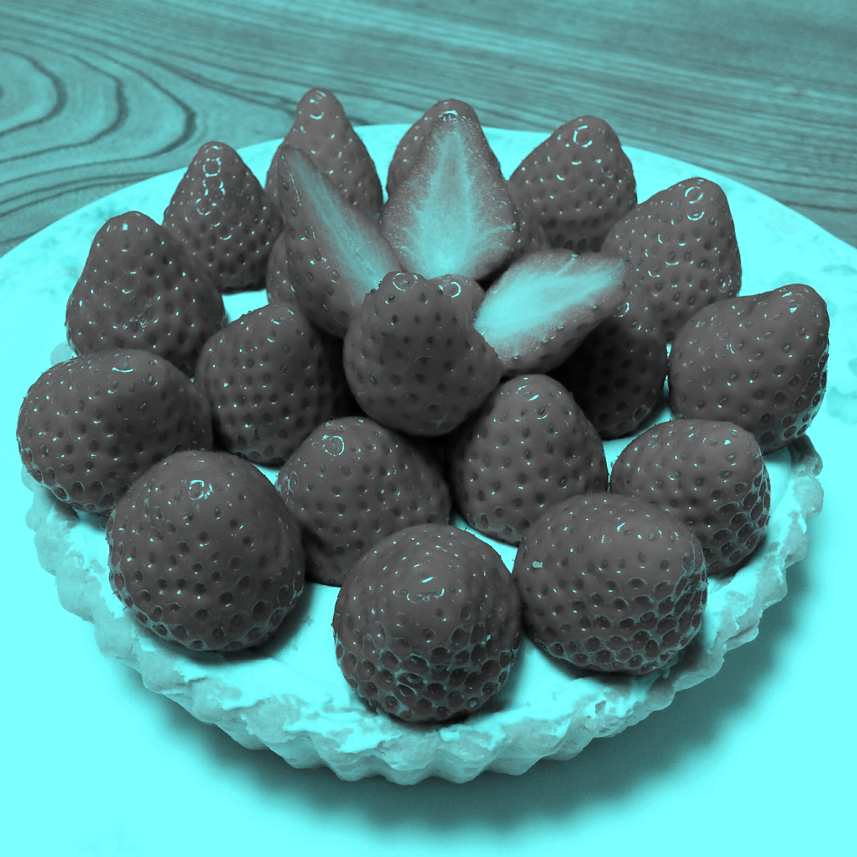
「赤く見えるいちご 2」
すべてのピクセルはシアン色の色相であるが、イチゴは赤く見える。変換色はシアン色で、透明度は20%の二色法変換。
Copyright Akiyoshi Kitaoka 2017 (February 28)
オリジナルの写真
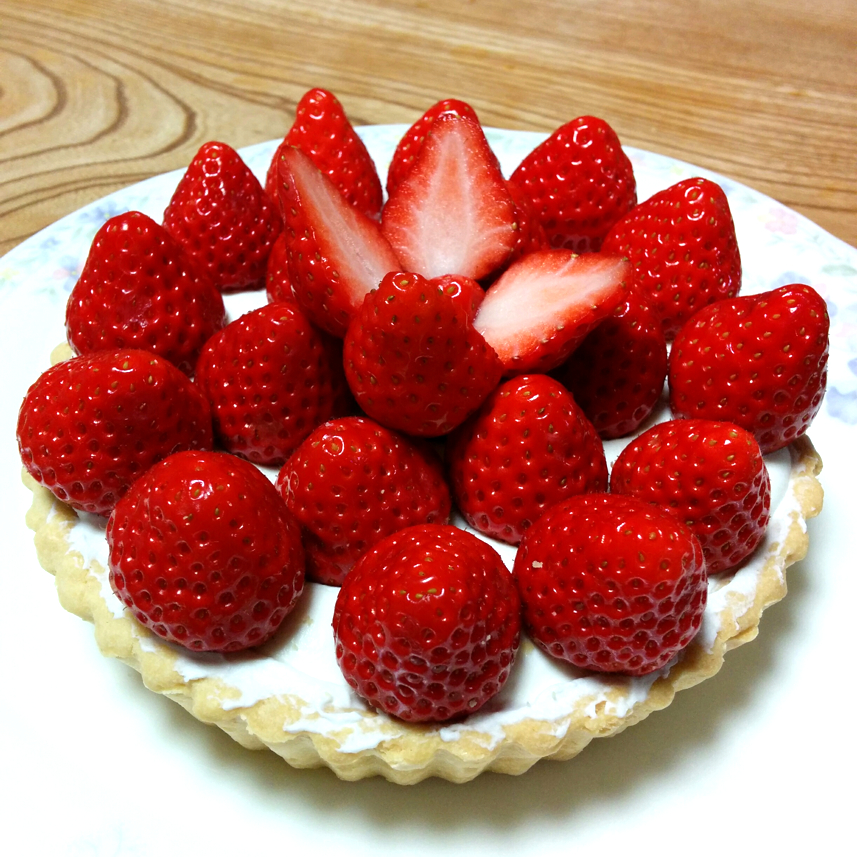
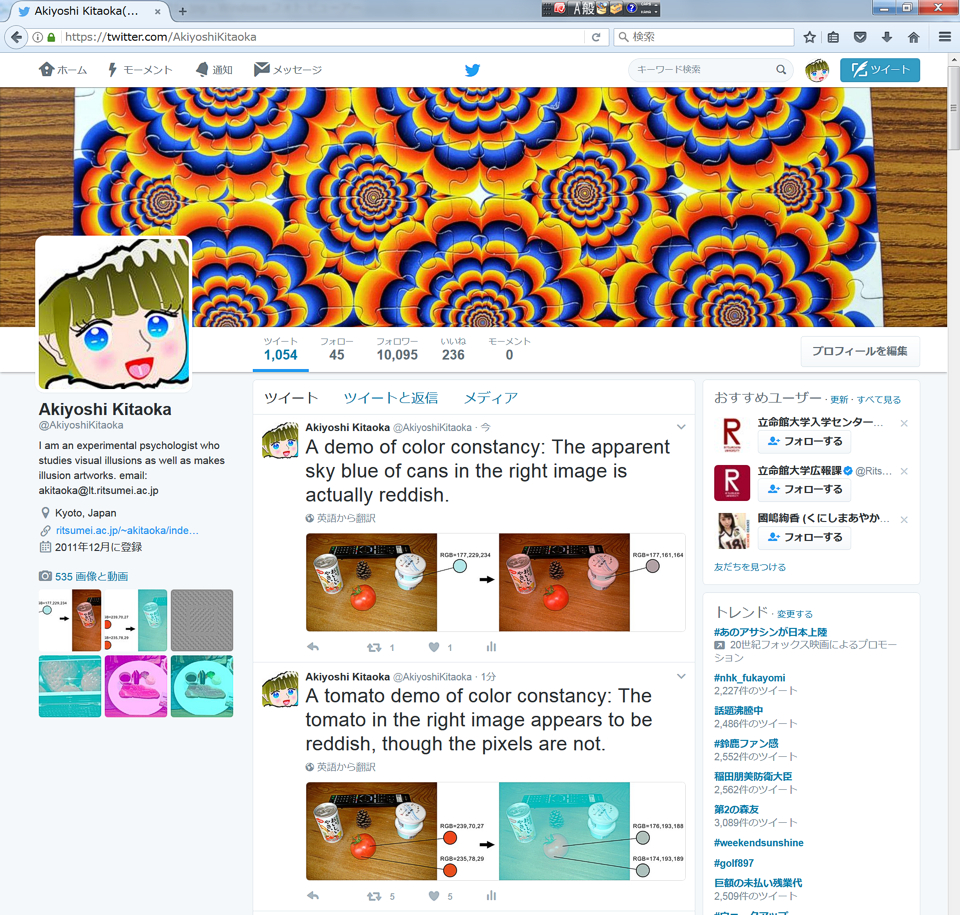
加法的色変換法(アルファブレンディング法)画像いろいろ
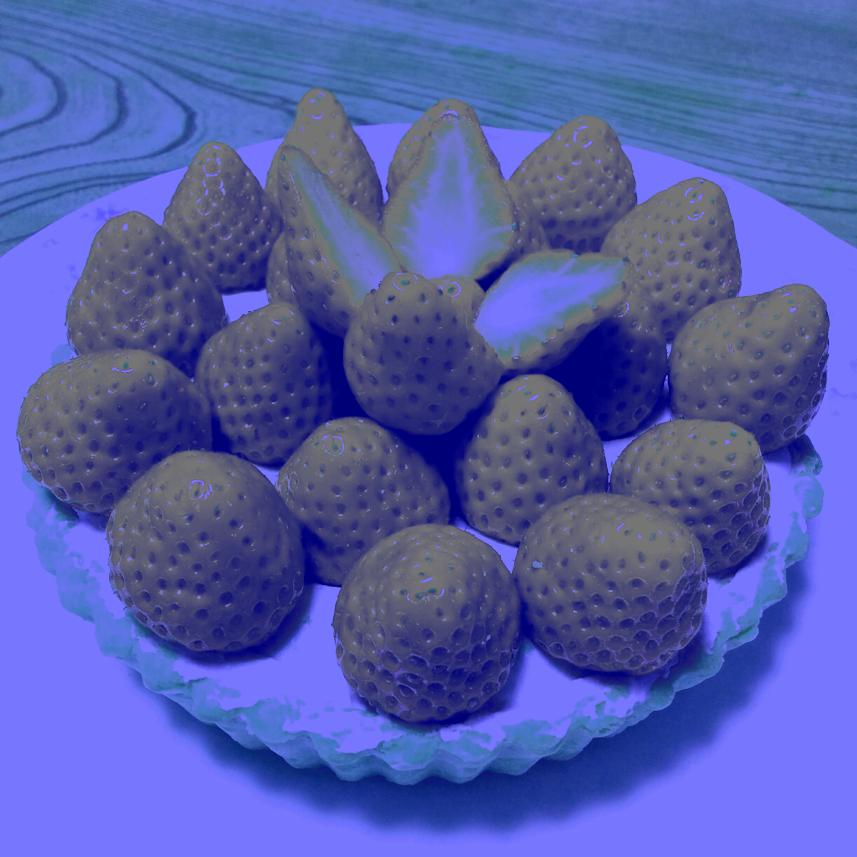
「黄色く見えるいちご」
すべてのピクセルは青色近辺の色相(一部灰色)であるが、イチゴは黄色く見える。
Copyright Akiyoshi Kitaoka 2017 (March 7)
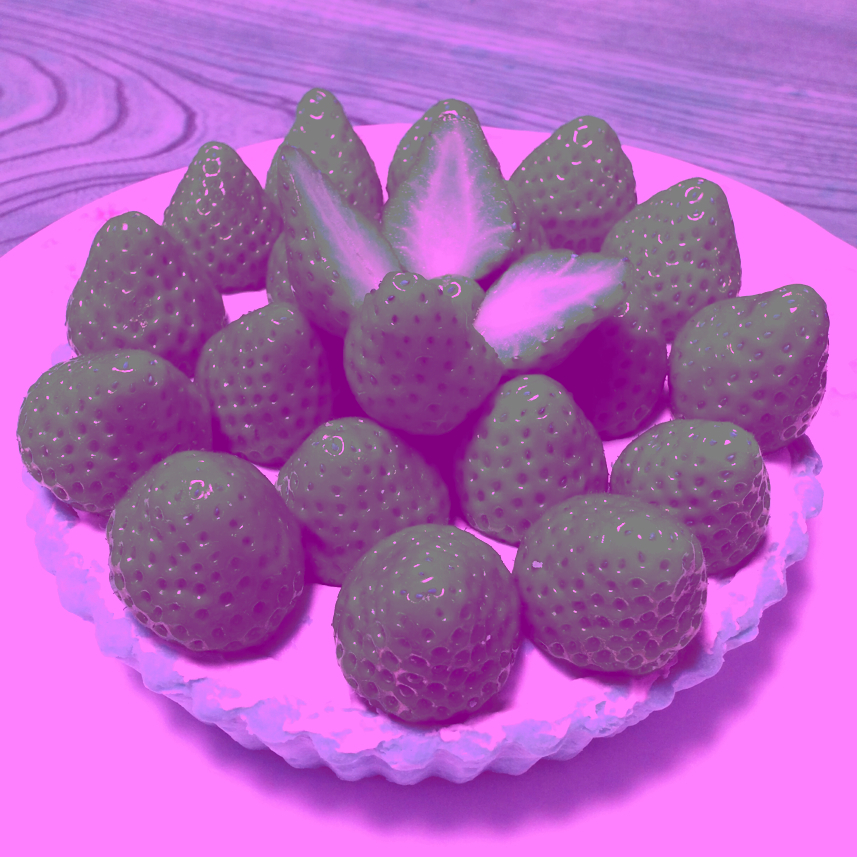
「緑色に見えるいちご」
すべてのピクセルはマゼンタ近辺の色相(一部灰色)であるが、イチゴは緑色に見える。
Copyright Akiyoshi Kitaoka 2017 (March 7)
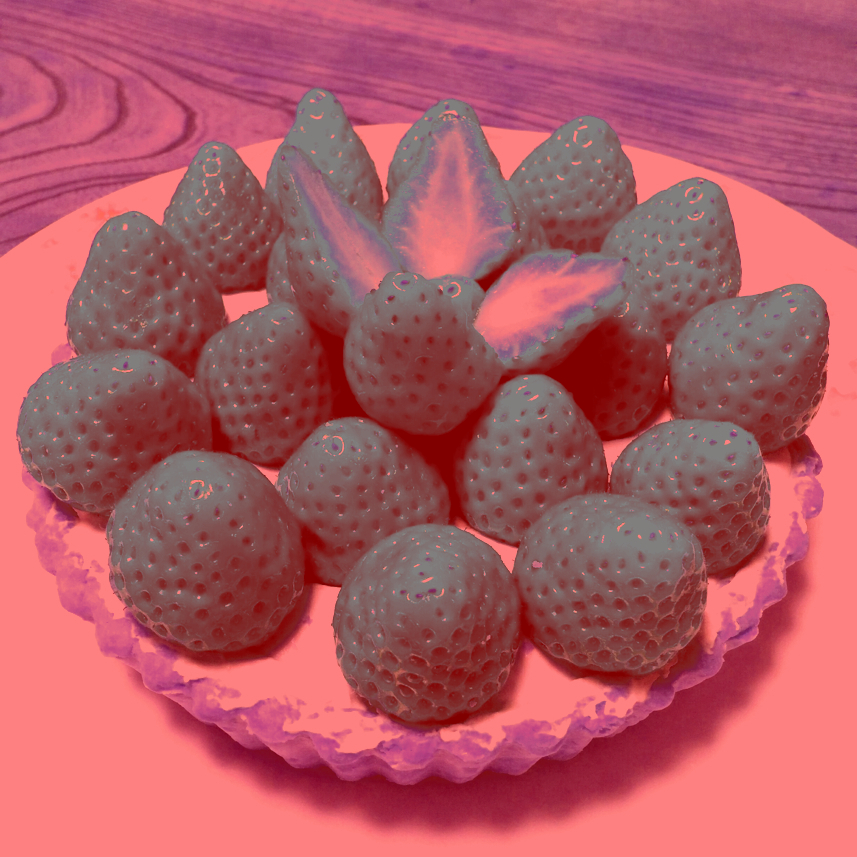
「水色に見えるいちご」
すべてのピクセルは赤色近辺の色相(一部灰色)であるが、イチゴは水色(シアン色)に見える。
Copyright Akiyoshi Kitaoka 2017 (March 7)
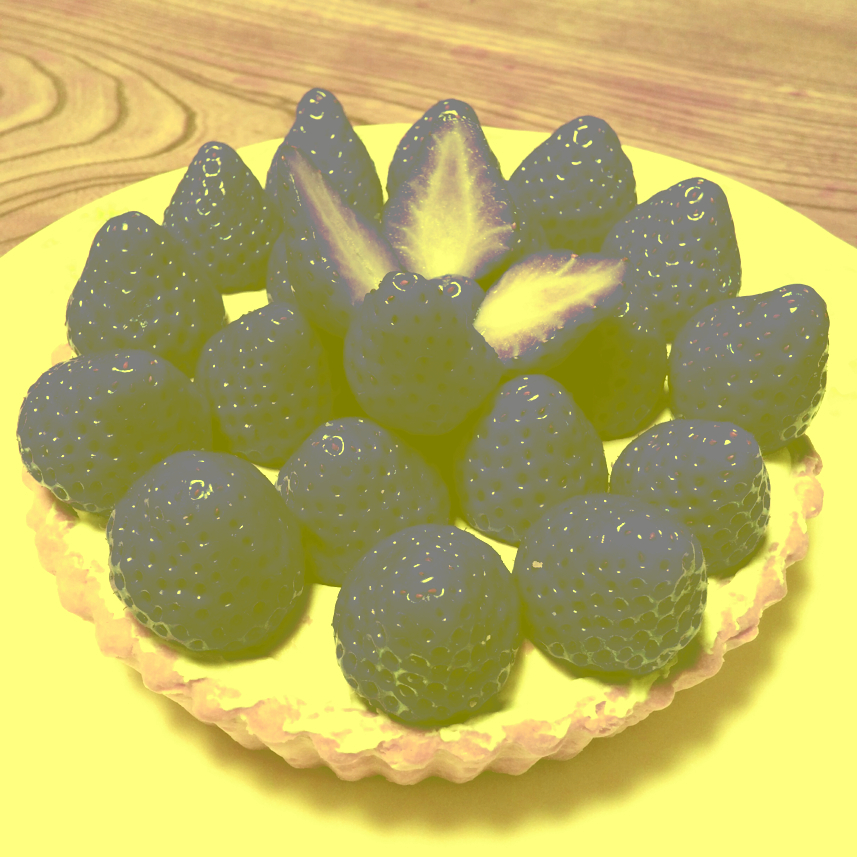
「青く見えるいちご」
すべてのピクセルは黄色近辺の色相(一部灰色)であるが、イチゴは青く見える。
Copyright Akiyoshi Kitaoka 2017 (March 7)
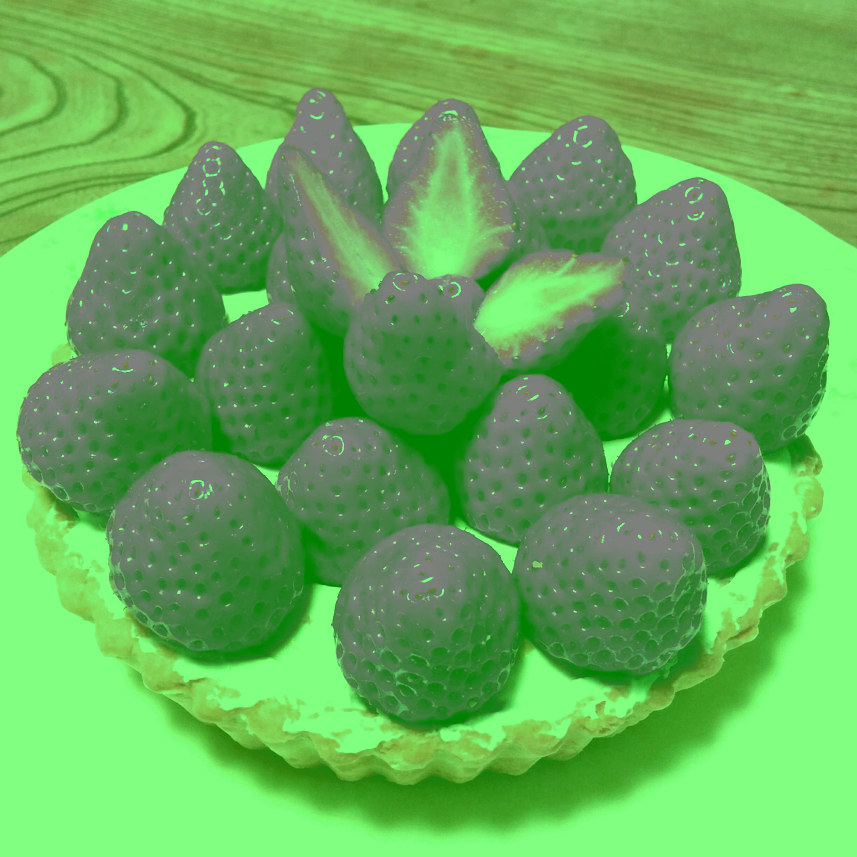
「赤紫色に見えるいちご」
すべてのピクセルは緑色近辺の色相(一部灰色)であるが、イチゴは赤紫色に見える。
Copyright Akiyoshi Kitaoka 2017 (March 7)
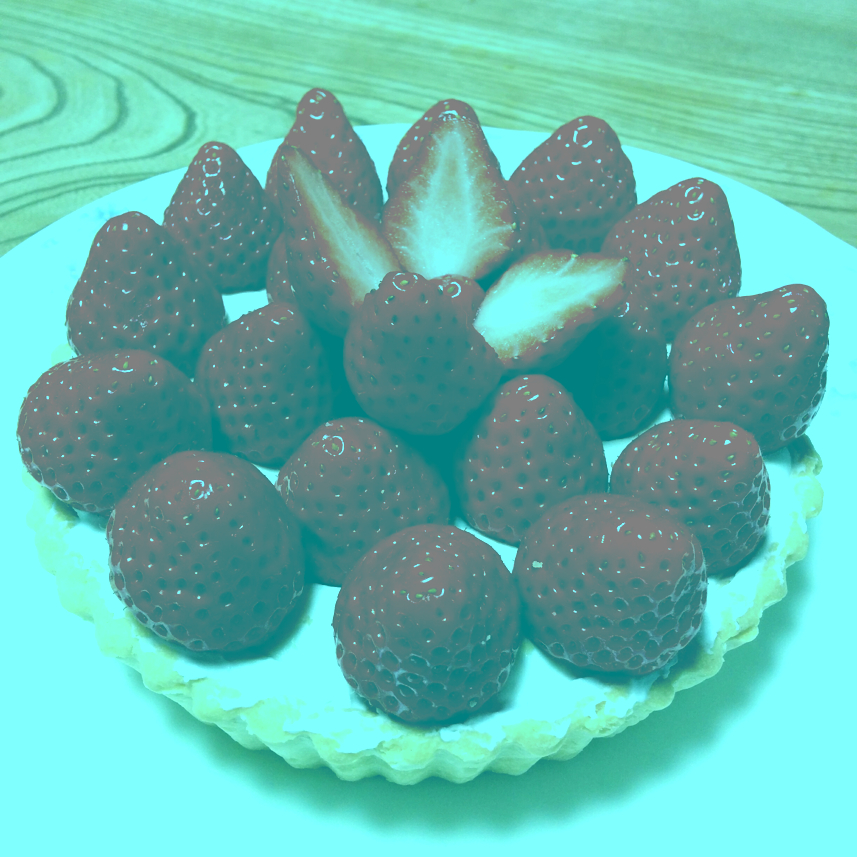
「赤く見えるいちご」
すべてのピクセルはシアン色近辺の色相(一部灰色)であるが、イチゴは赤く見える。
Copyright Akiyoshi Kitaoka 2017 (March 7)
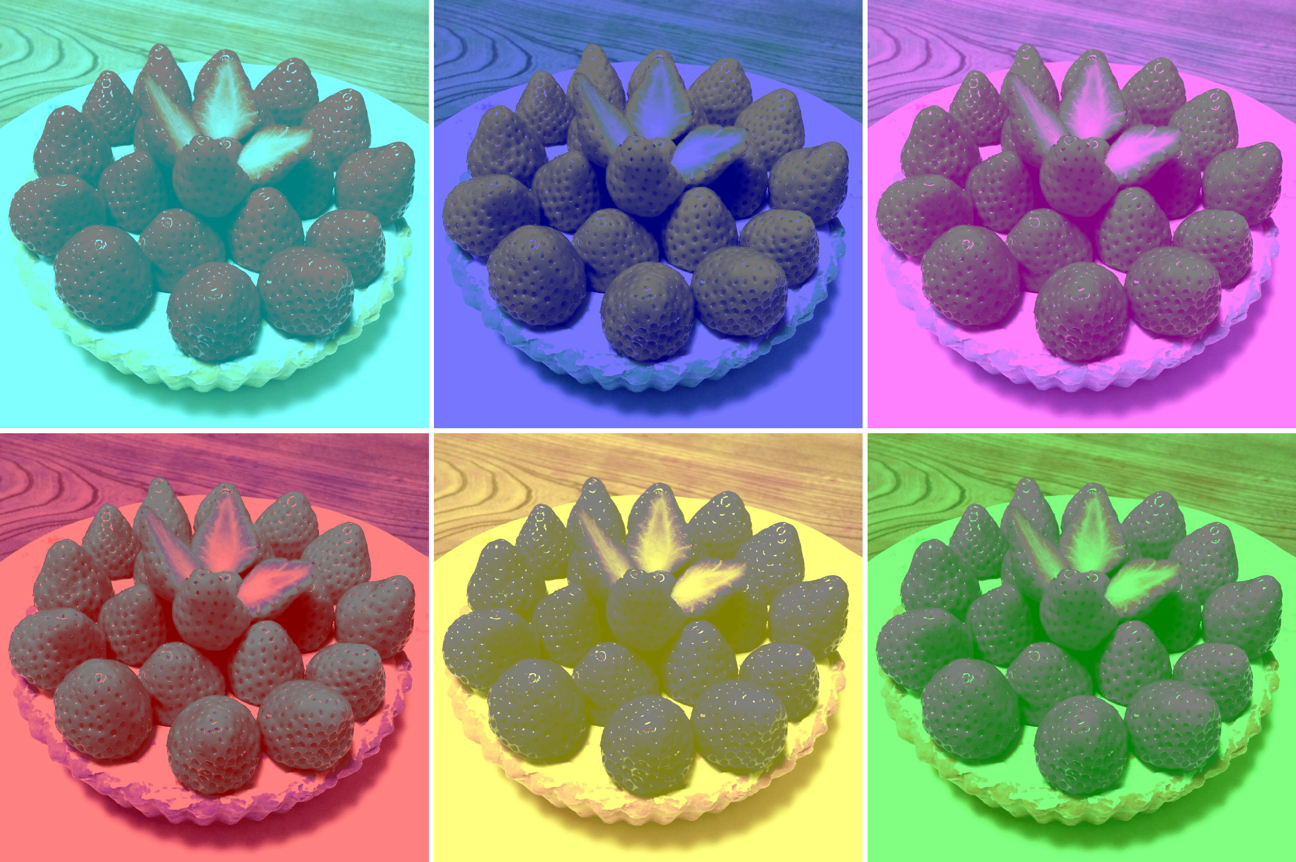
「錯視的六色盛り合わせ」
左上から右に、イチゴは赤、黄、緑に見え、左下から右に、イチゴは水色、青、赤紫に見えるが、それぞれの画素はそうではない。
Copyright Akiyoshi Kitaoka 2017 (March 7)
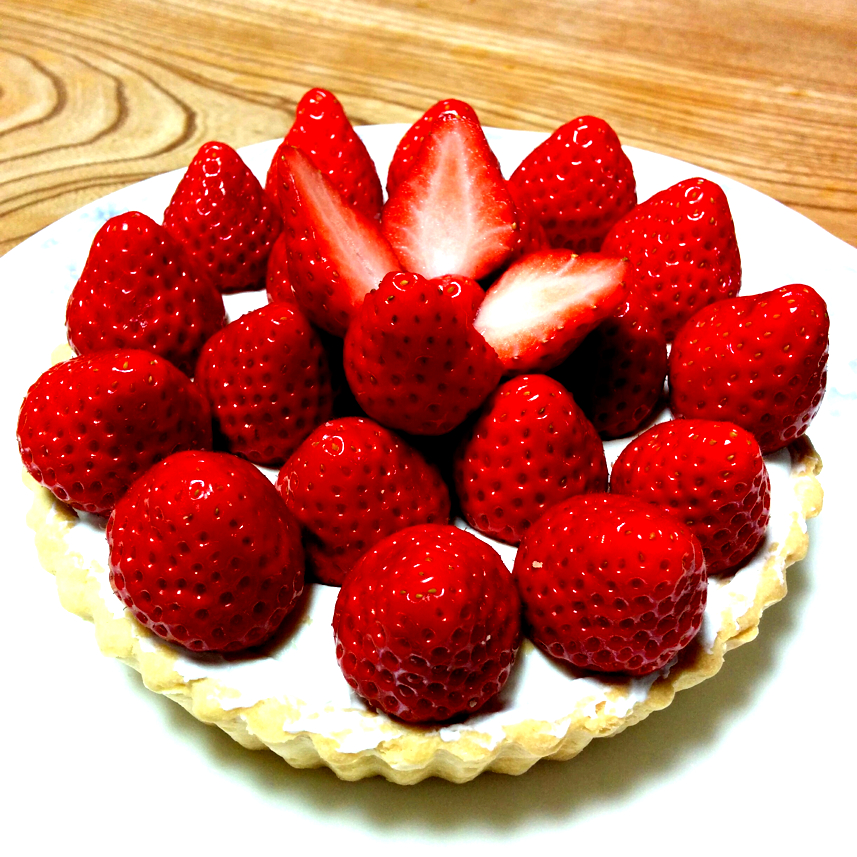
参考:上記錯視画像の元となった高彩度に調整された画像
Copyright Akiyoshi Kitaoka 2017 (March 7)
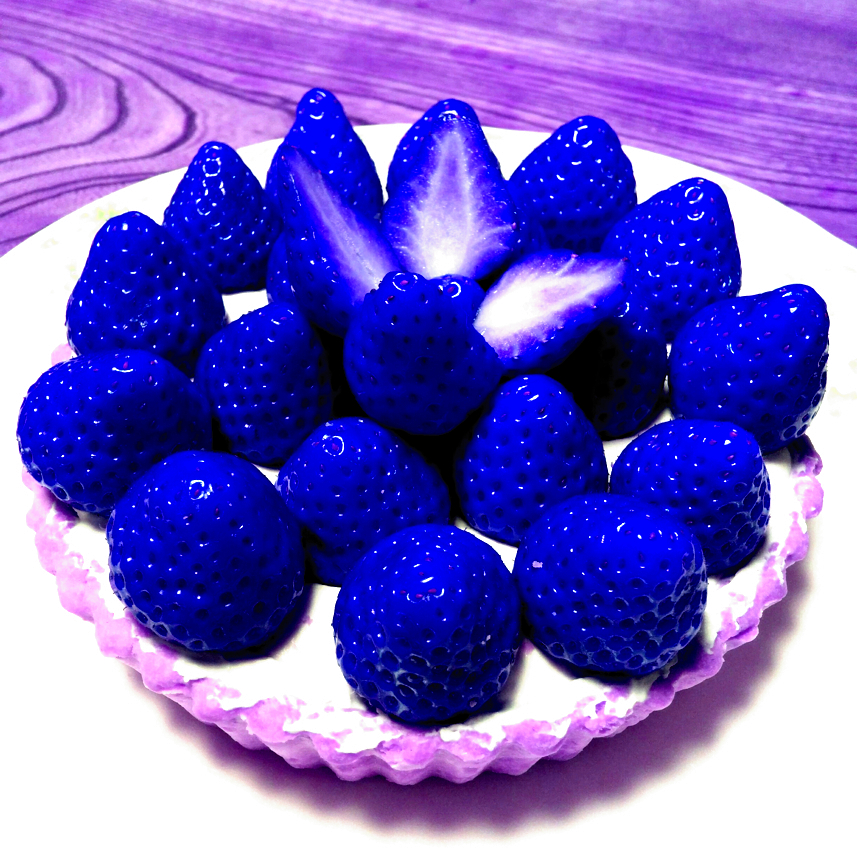
参考:赤を青に変換した画像
Copyright Akiyoshi Kitaoka 2017 (March 7)
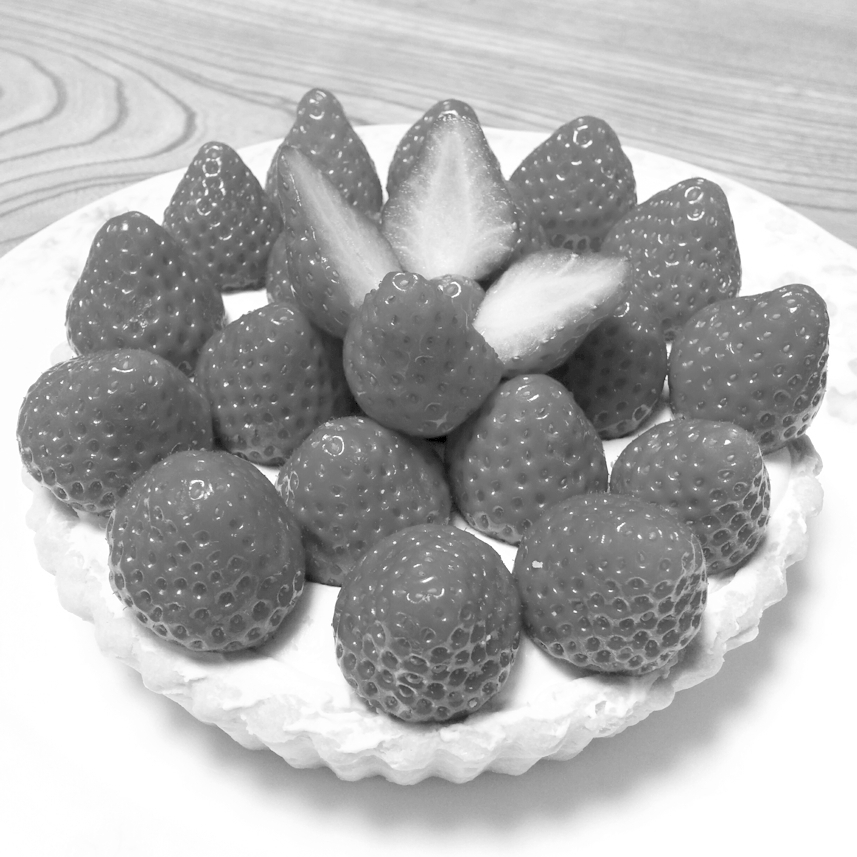
参考:グレースケール画像
Copyright Akiyoshi Kitaoka 2017 (March 7)
二色法画像いろいろ
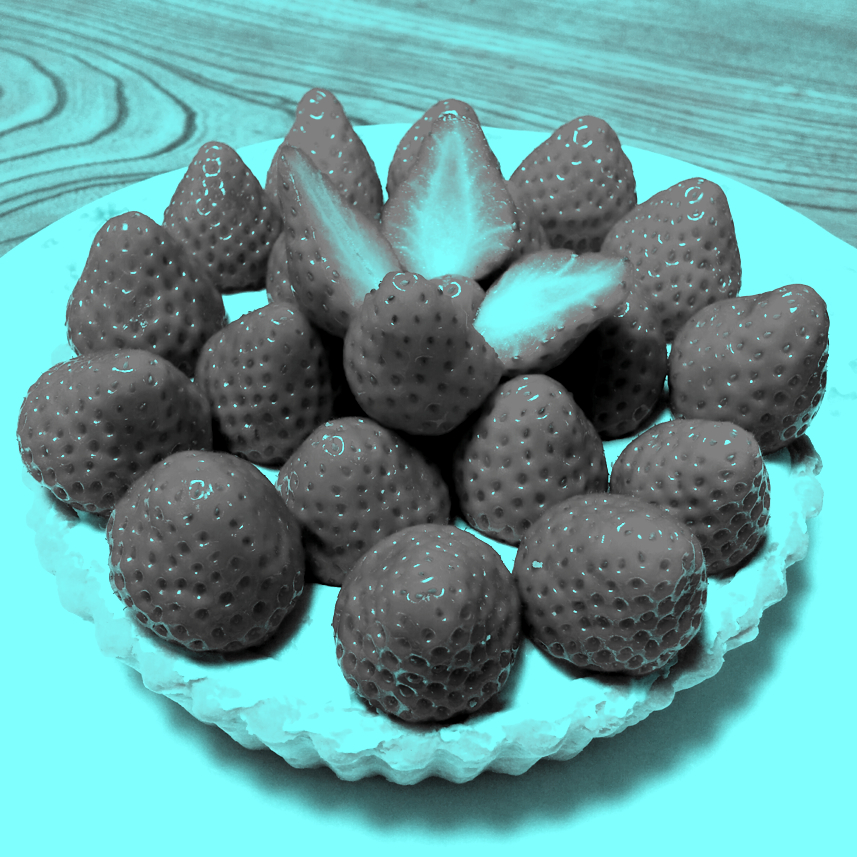
「赤く見えるいちご」
すべてのピクセルはシアン色の色相(一部灰色)であるが、イチゴは赤く見える。
Copyright Akiyoshi Kitaoka 2017 (March 9)
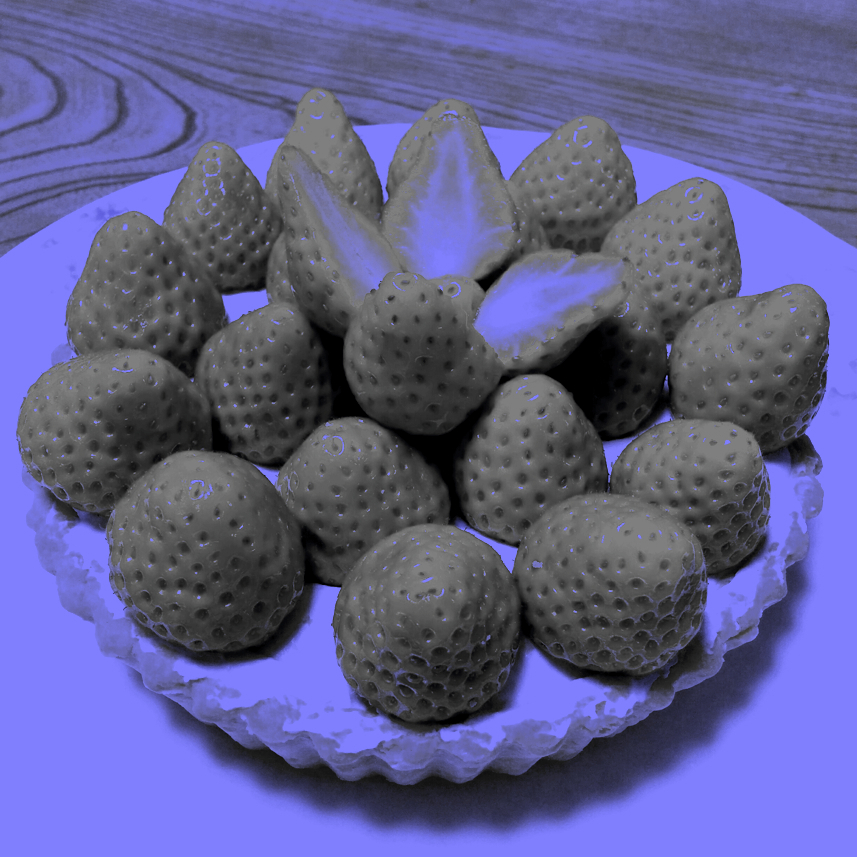
「黄色く見えるいちご」
すべてのピクセルは青色の色相(一部灰色)であるが、イチゴは黄色く見える。
Copyright Akiyoshi Kitaoka 2017 (March 9)
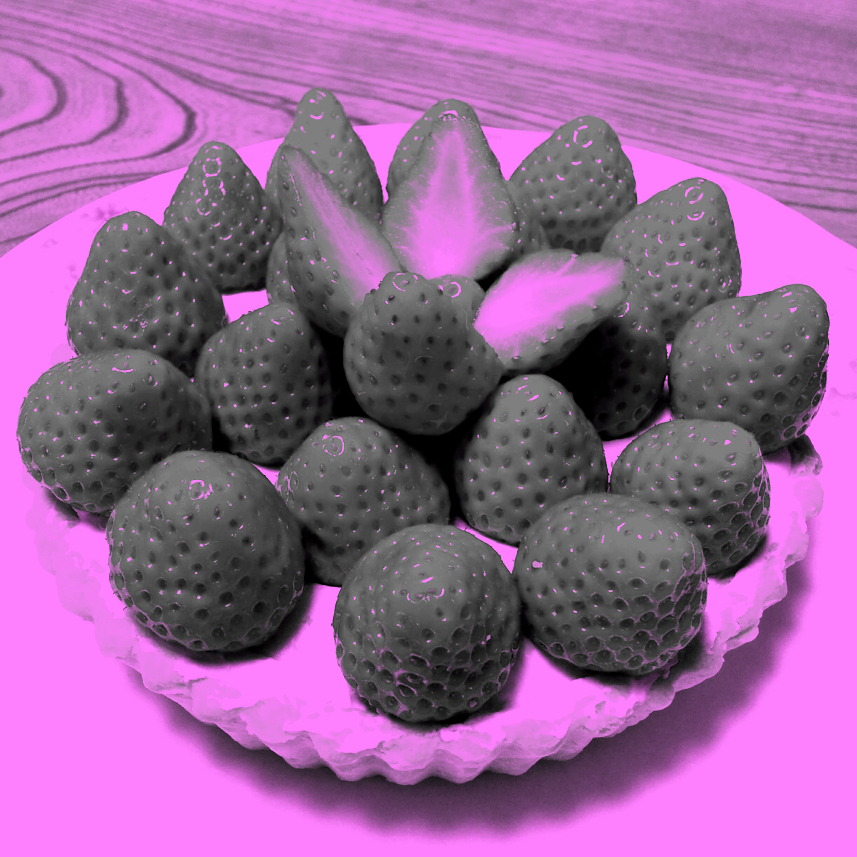
「緑色に見えるいちご」
すべてのピクセルはマゼンタ色の色相(一部灰色)であるが、イチゴは緑色に見える。
Copyright Akiyoshi Kitaoka 2017 (March 9)
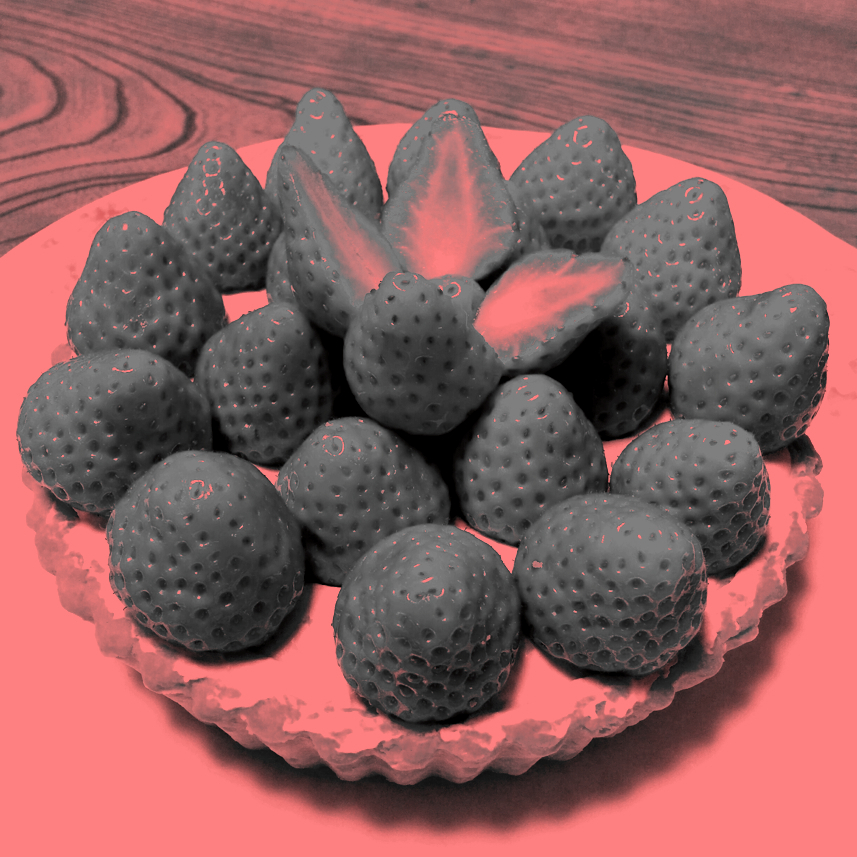
「水色に見えるいちご」
すべてのピクセルは赤色の色相(一部灰色)であるが、イチゴは水色(シアン色)に見える。
Copyright Akiyoshi Kitaoka 2017 (March 9)
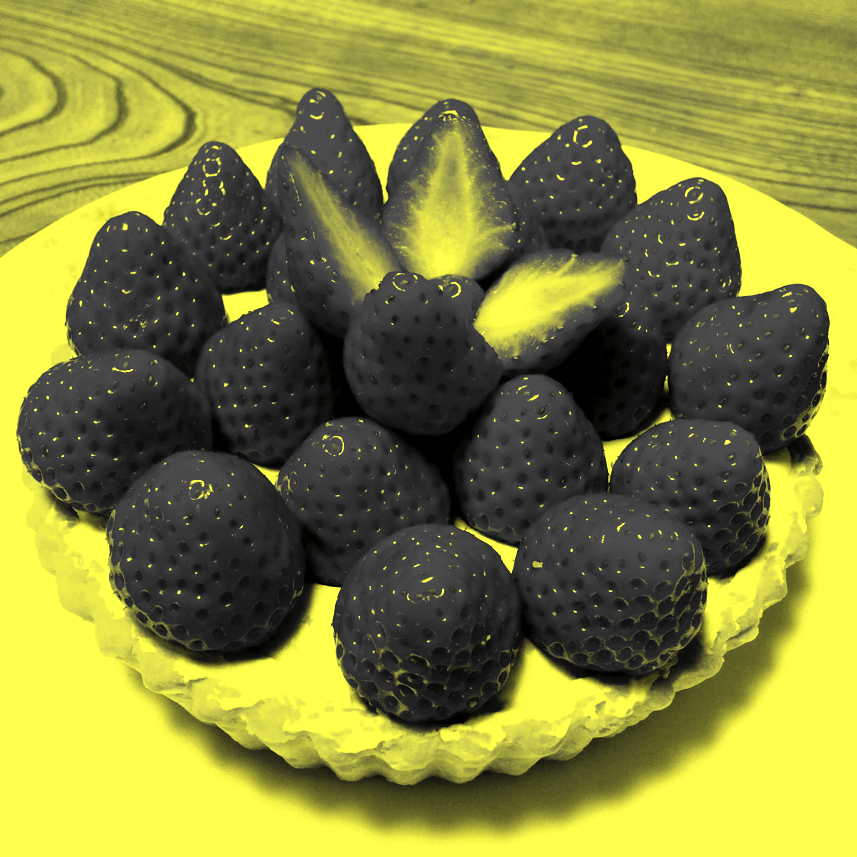
「青色に見える(?)いちご」
すべてのピクセルは黄色の色相(一部灰色)であるが、イチゴは青色に見える(?)。
Copyright Akiyoshi Kitaoka 2017 (March 9)
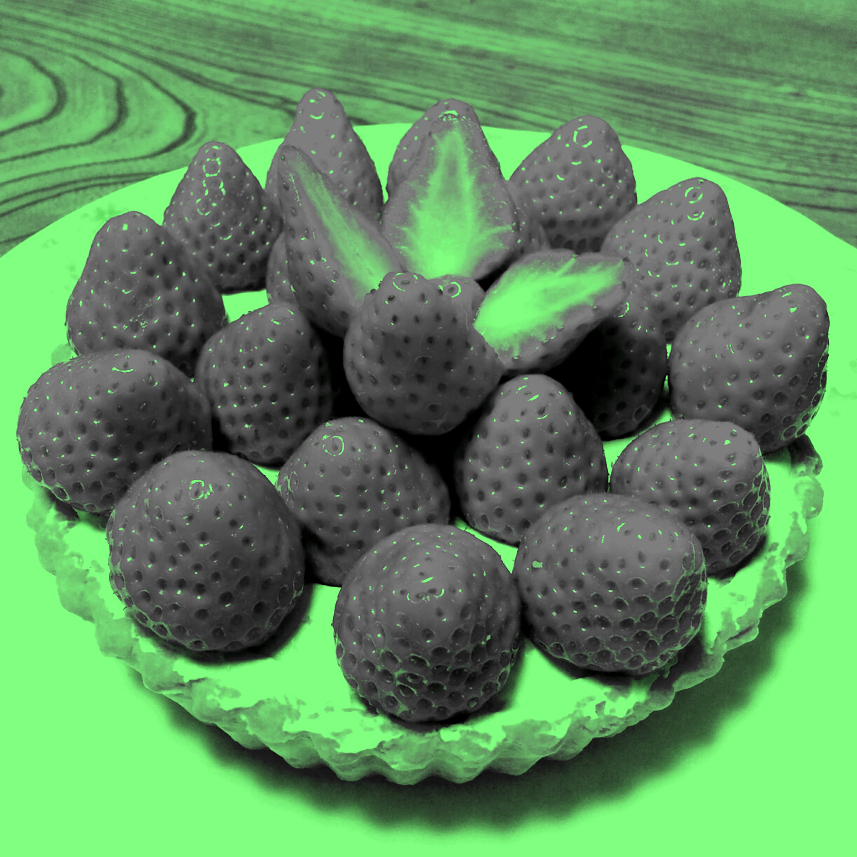
「赤紫色に見えるいちご」
すべてのピクセルは緑色の色相(一部灰色)であるが、イチゴは赤紫色に見える。
Copyright Akiyoshi Kitaoka 2017 (March 9)
乗法的色変換と加法的色変換
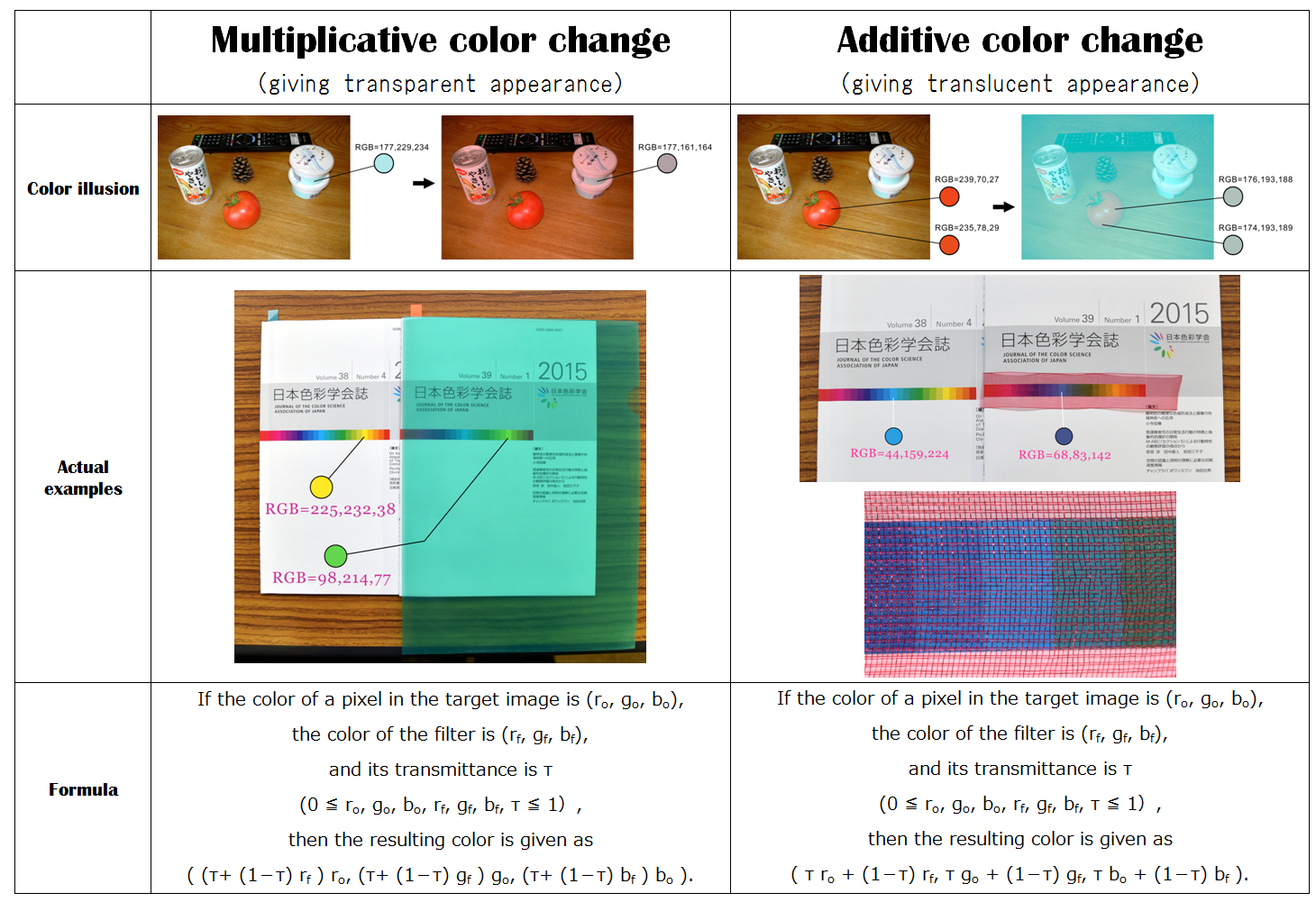
参考
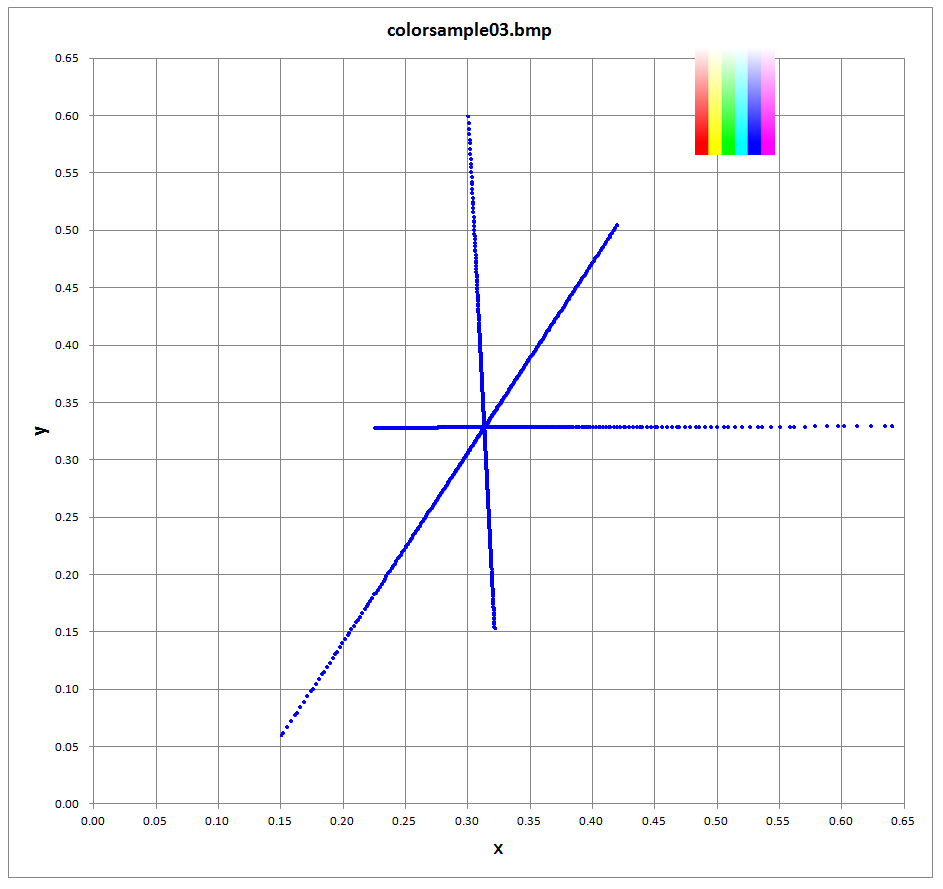
sRGB 白色点 D65: x = 0.3127, y= 0.3290
R: x = 0.6400, y = 0.3300
G: x = 0.3000, y = 0.6000
B: x = 0.1500, y = 0.0600
<according to IEC 61966-2-1>
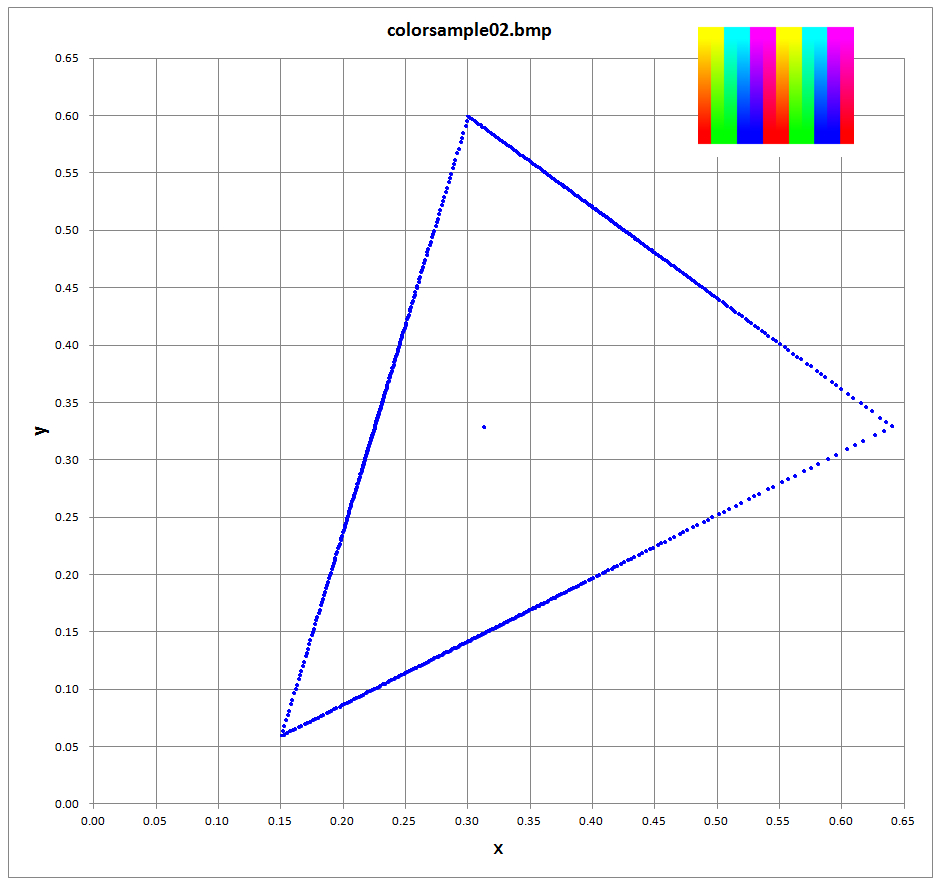
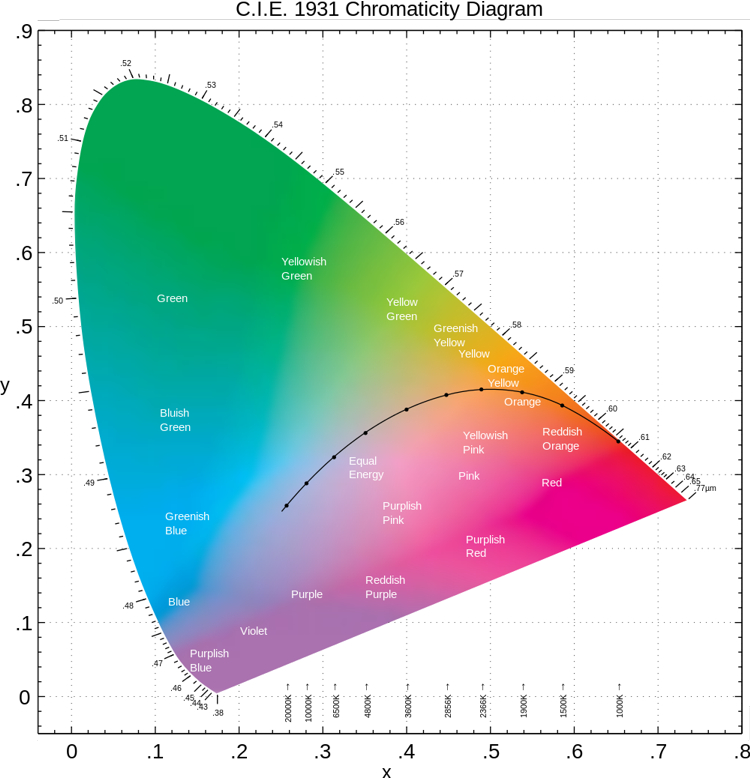
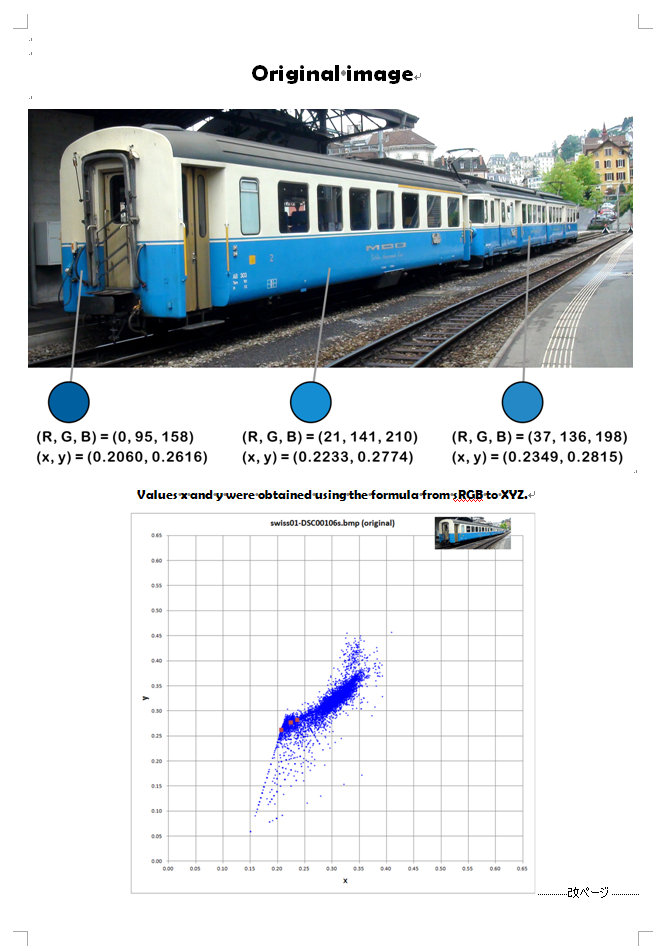
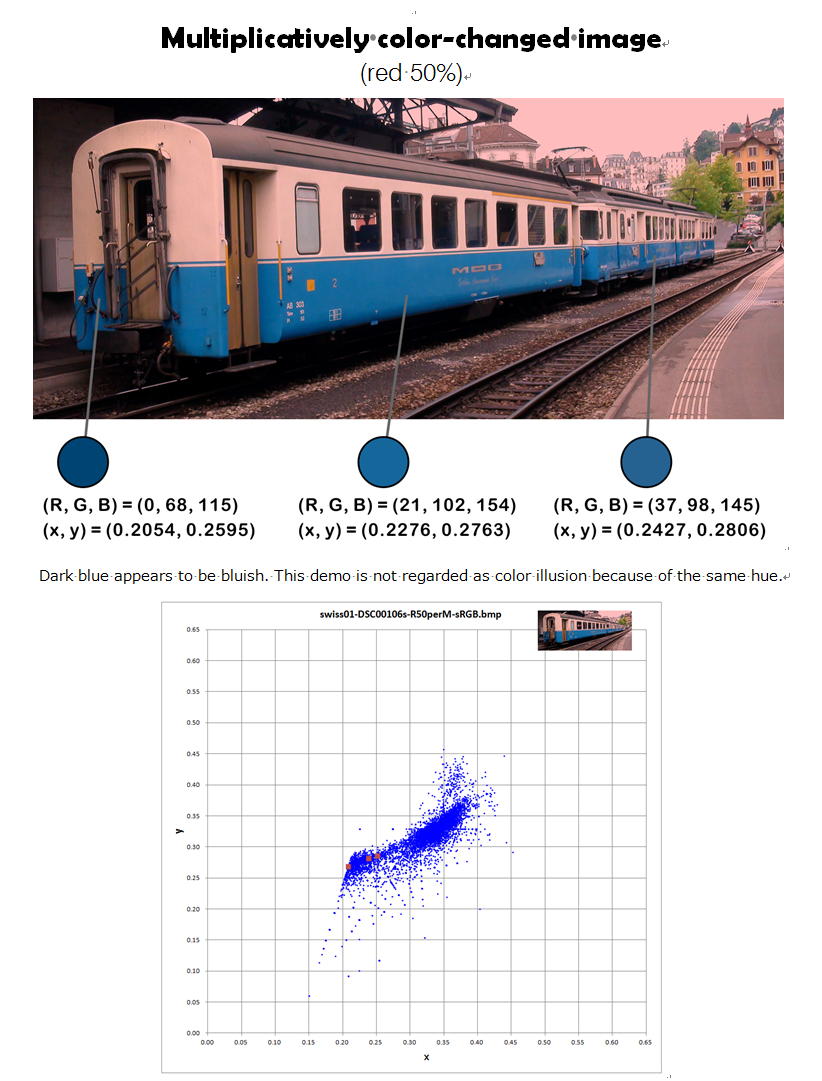
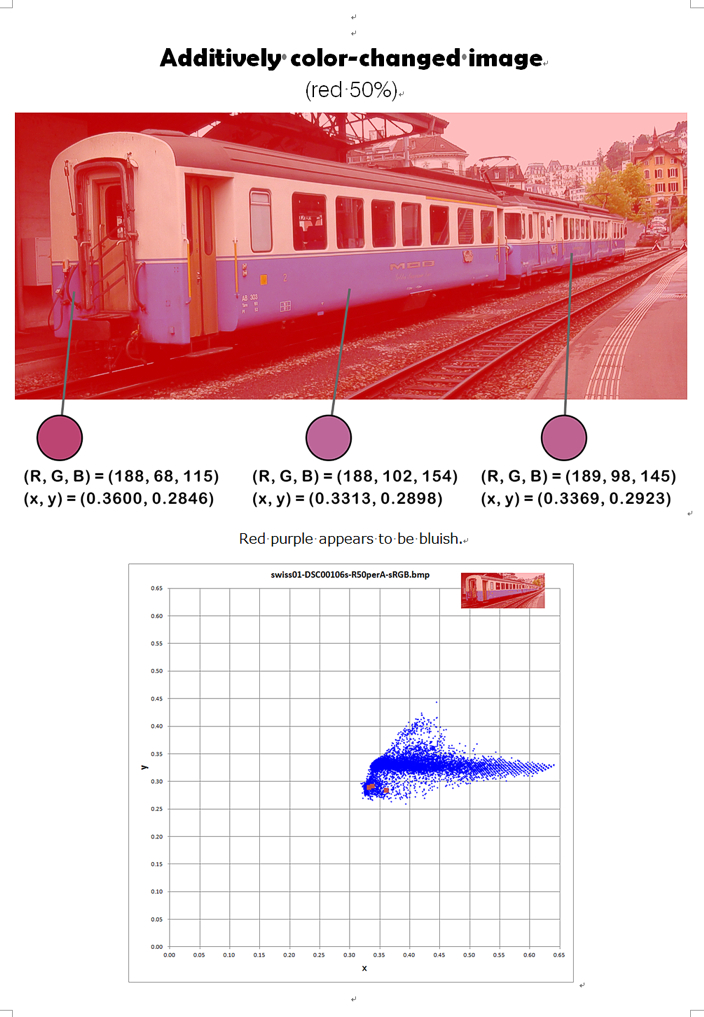
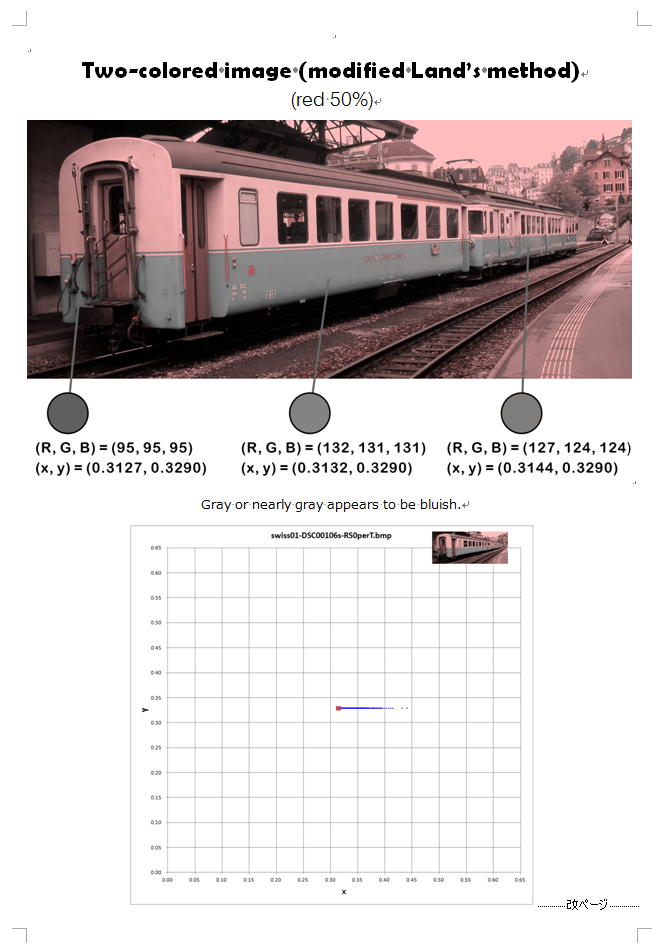
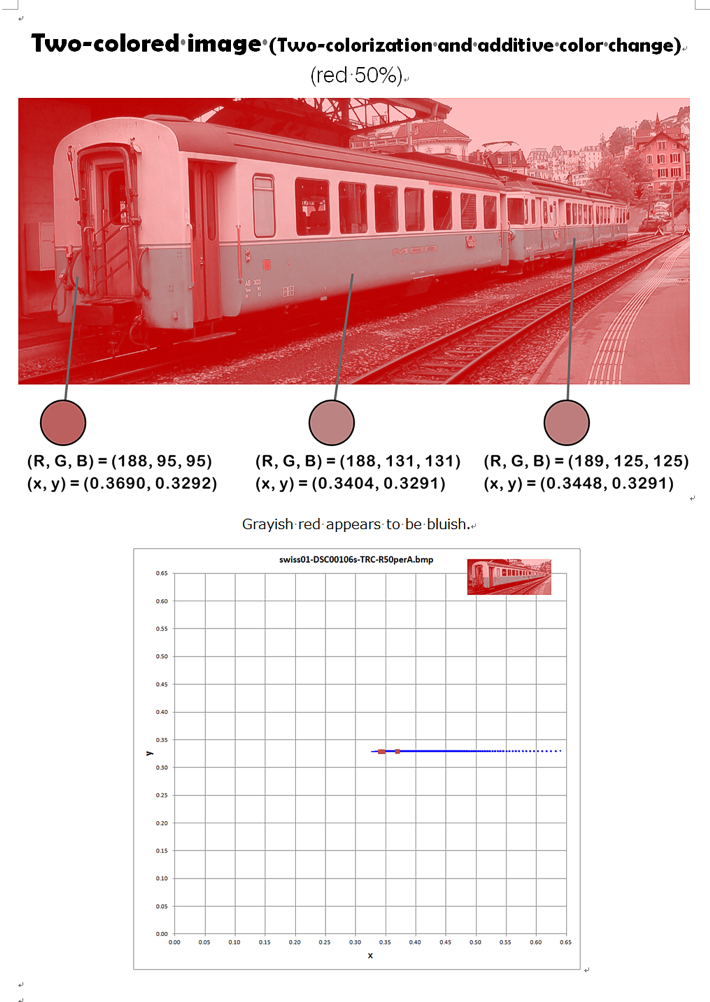
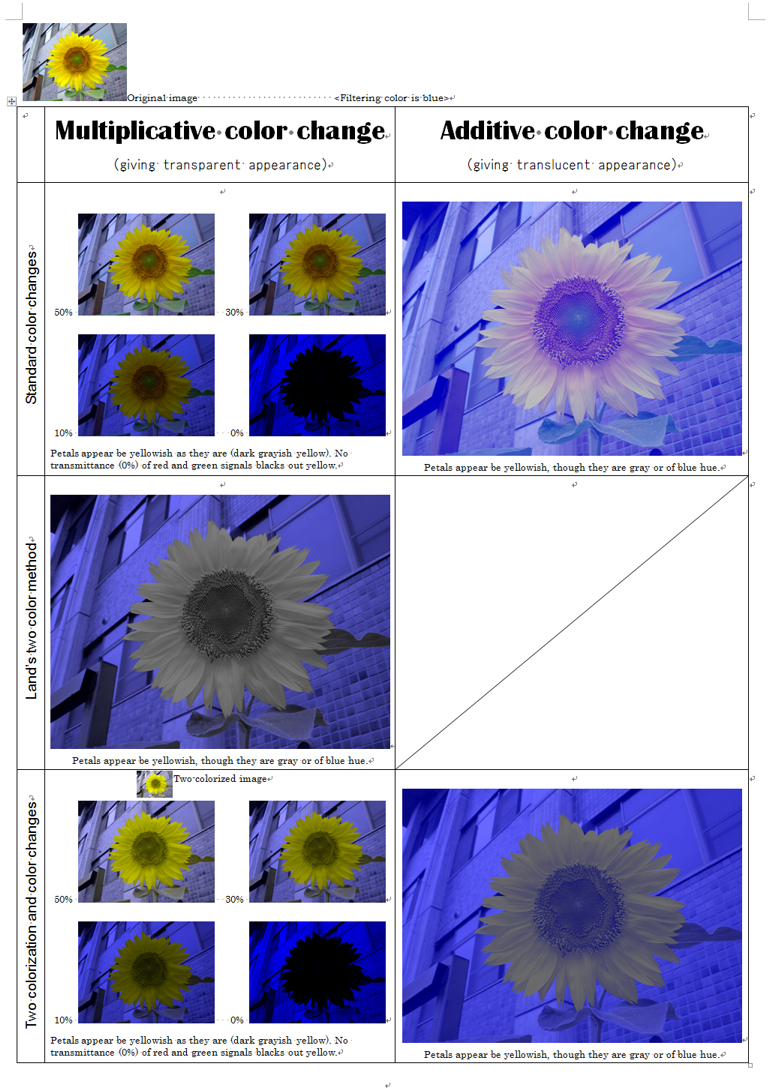
Kitaoka, A. (2015). Color Illusions Accompanied by Color Constancy Phenomena. Demoes at the Exhibition, International Symposium on Psychological vs Mathematical Approaches to Optical Illusion (Tokyo Symposium on Optical Illusion 2015), Meiji University, Nakano Campus, Tokyo, Japan, March 5-7, 2015. Demo (PDF)
静脈が青く見える錯視
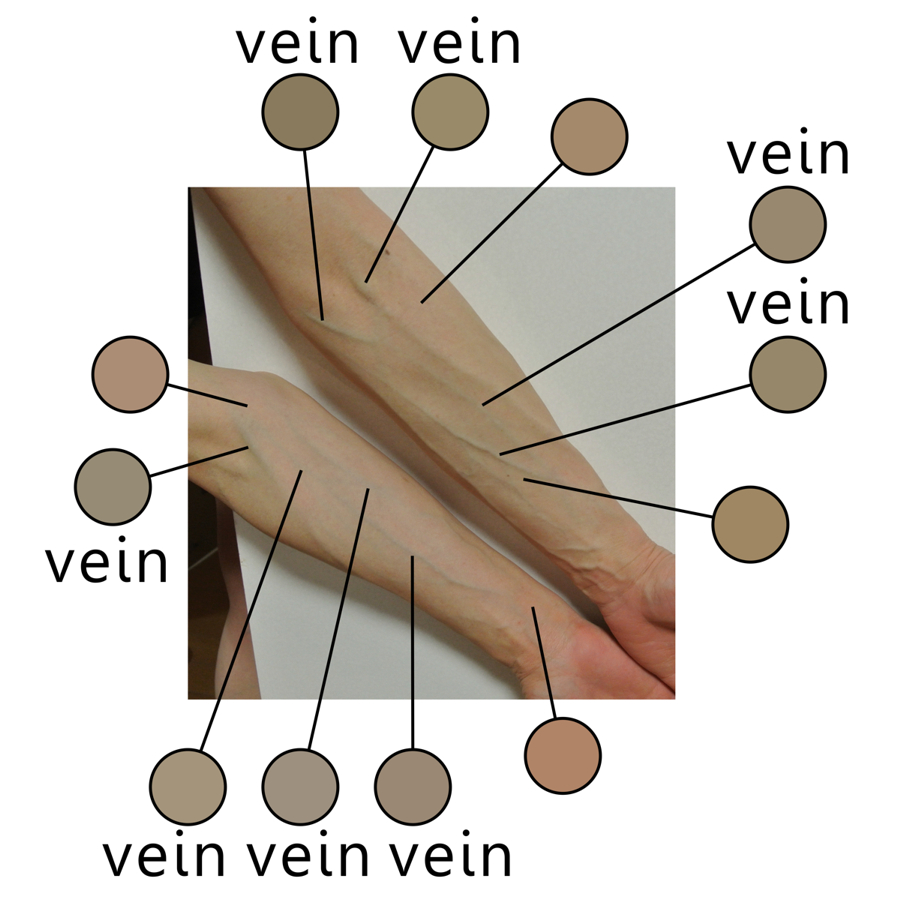
「静脈錯視:腕」
この手の青く浮き出て見える静脈は物理的には青くなく、彩度の低いオレンジ色であった。
Copyright Akiyoshi Kitaoka 2014 (April 24)
Thanks to MK for your tremendous contribution!
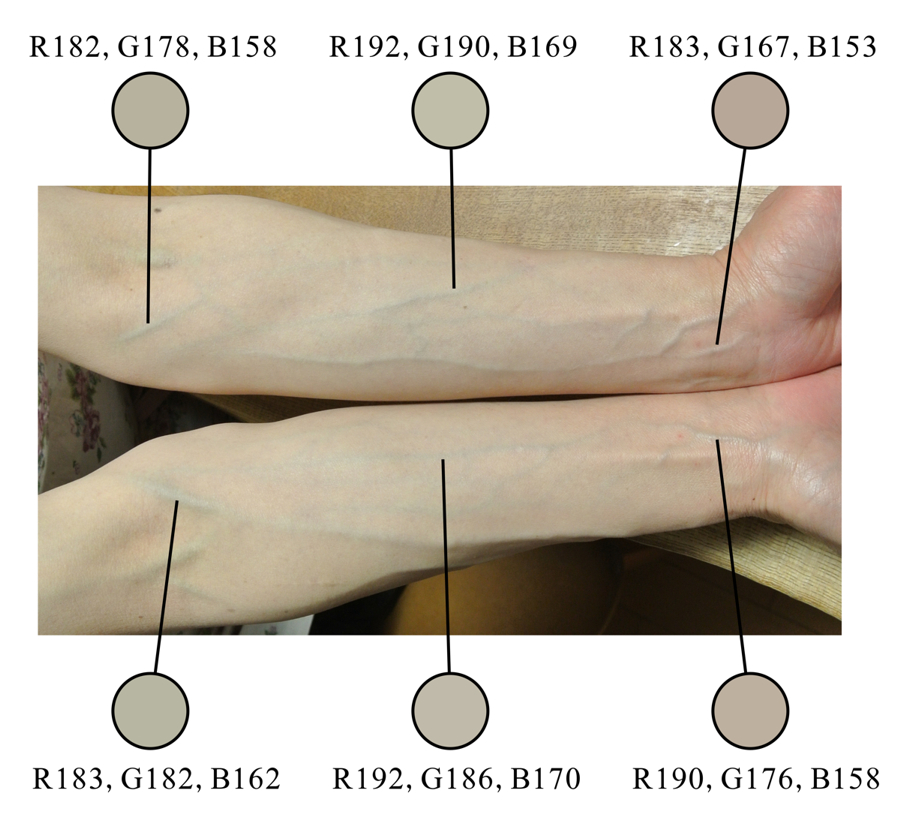
「静脈錯視:腕 2」
青白く撮れた写真の場合でも、この手の青く浮き出て見える静脈は物理的には青くなく、彩度の低い黄色かオレンジ色であった。
Copyright Akiyoshi Kitaoka 2014 (April 24)
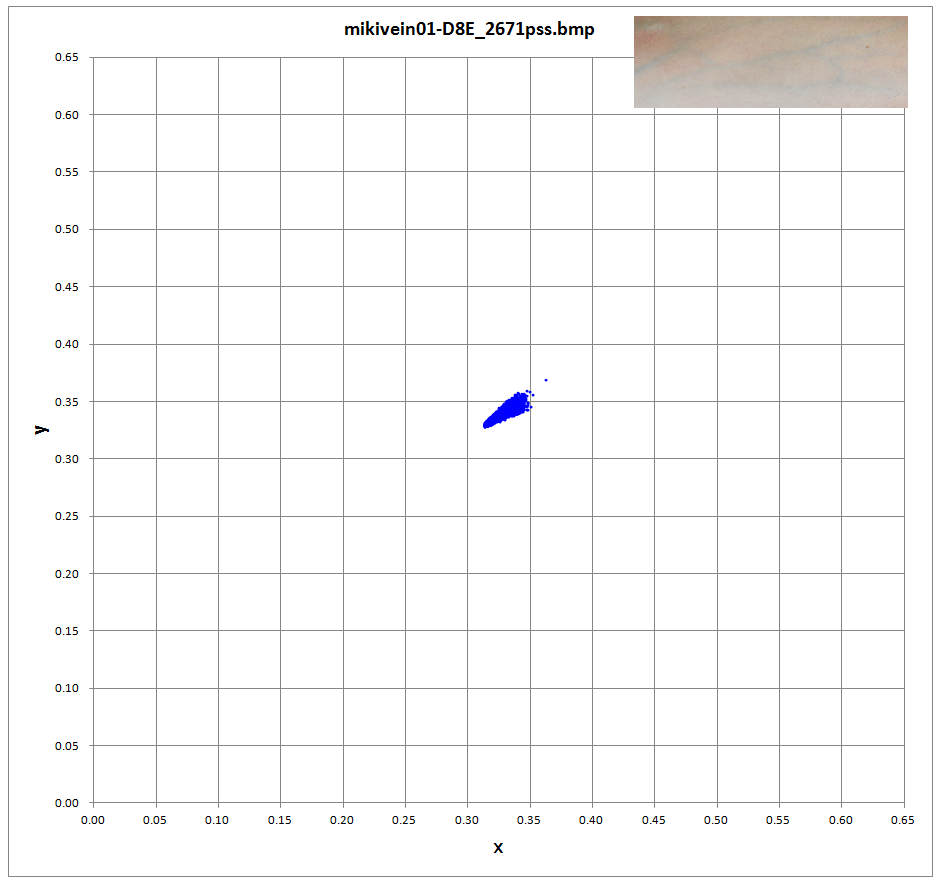
上図を 「逆変換」 すると下図となる。
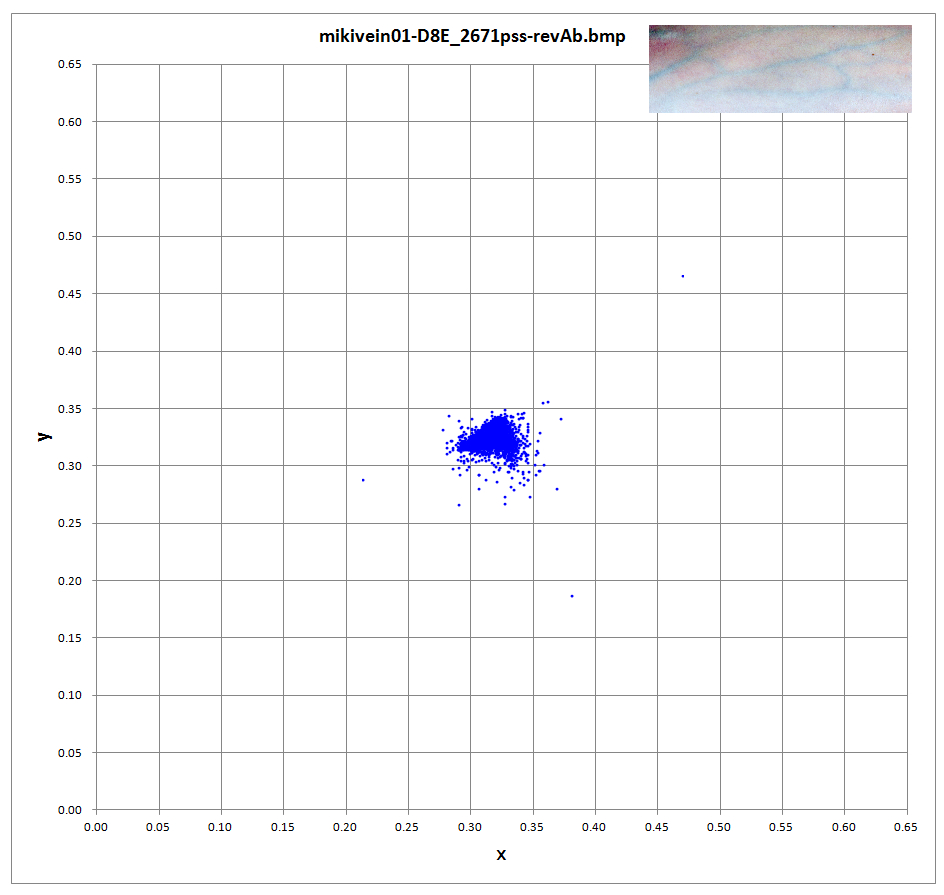

Kitaoka, A. (2015). Color constancy and the vein color illusion. 38th European Conference on Visual Perception (ECVP) (Liverpool), Poster 2P1M060, August 25, 2015. Presentation (html) --- Poster (doc)
北岡明佳 (2015) 「乗算的および加算的色変換による色の錯視」 (錯覚と数理の融合研究ワークショップ(第9回錯覚ワークショップ・2015年9月7日(月) 16:10-17:00・明治大学中野キャンパス) 発表に使用したウェブページ
同じ色配列が白と黒に見える錯視
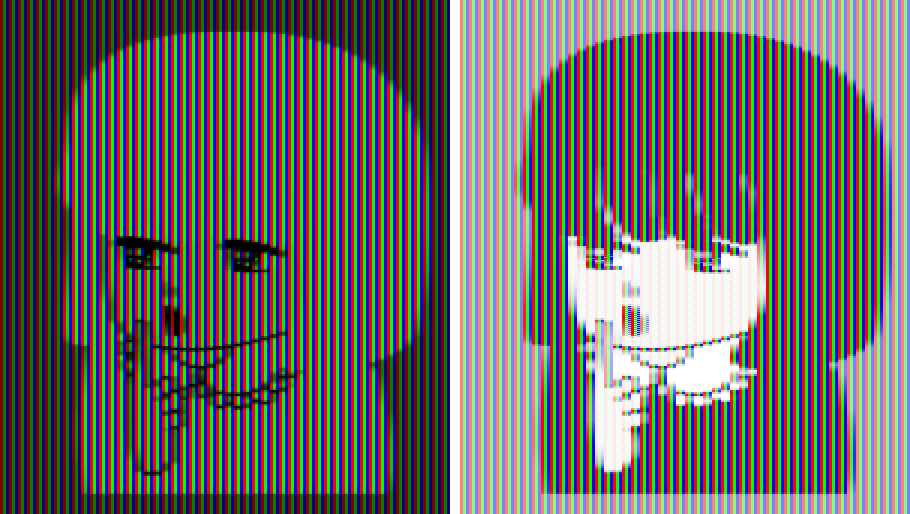
「RGBで白と黒」
左の絵の髪と服は白く見え、右の絵では黒く見えるが、同じRGBの縞模様である。
Copyright Akiyoshi Kitaoka 2016 (August 15)
拡大画像
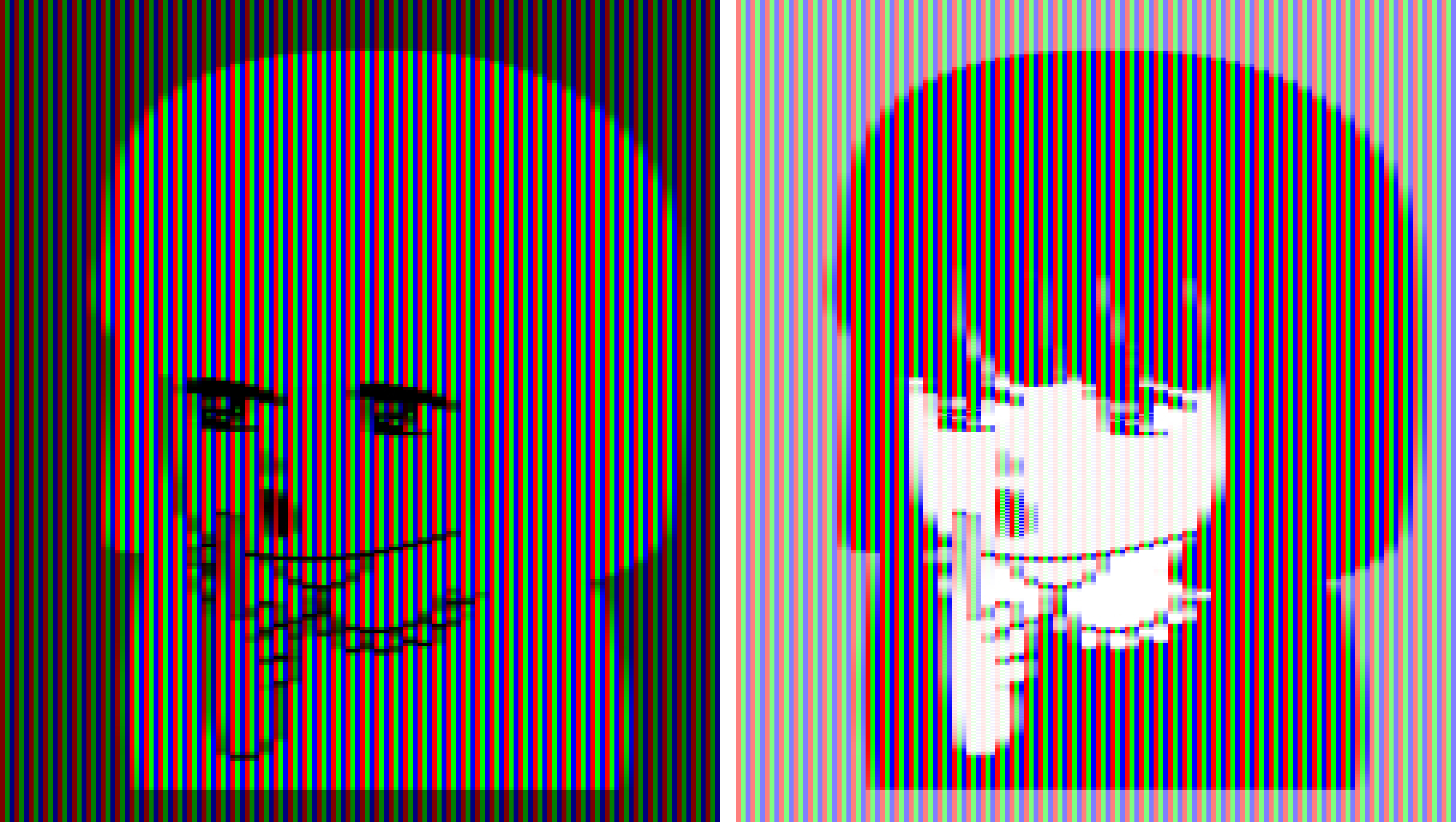
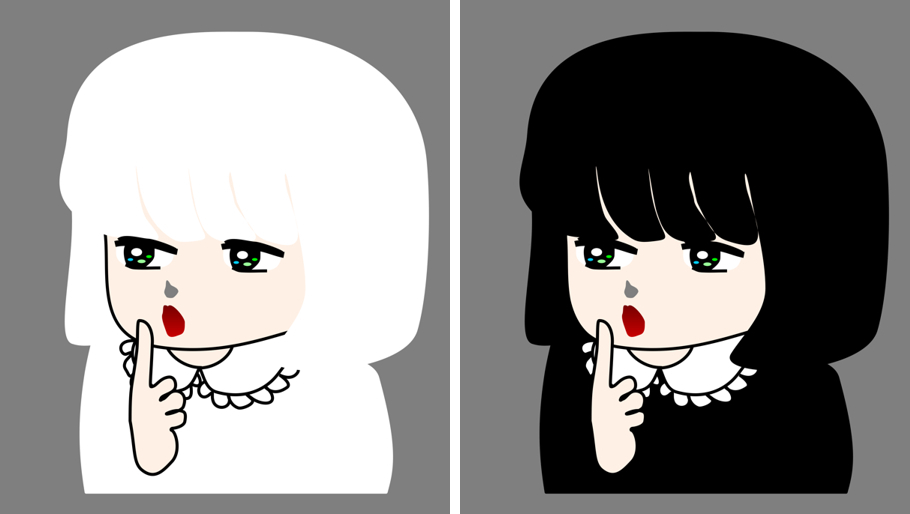
原図
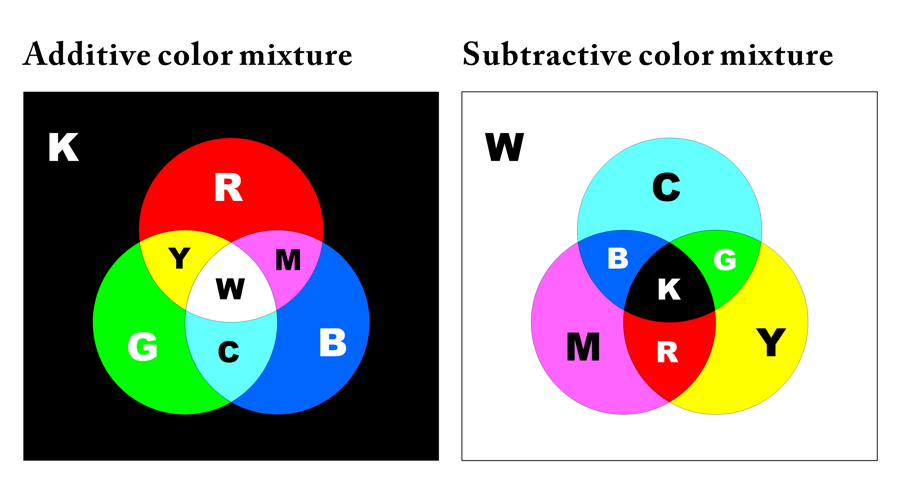
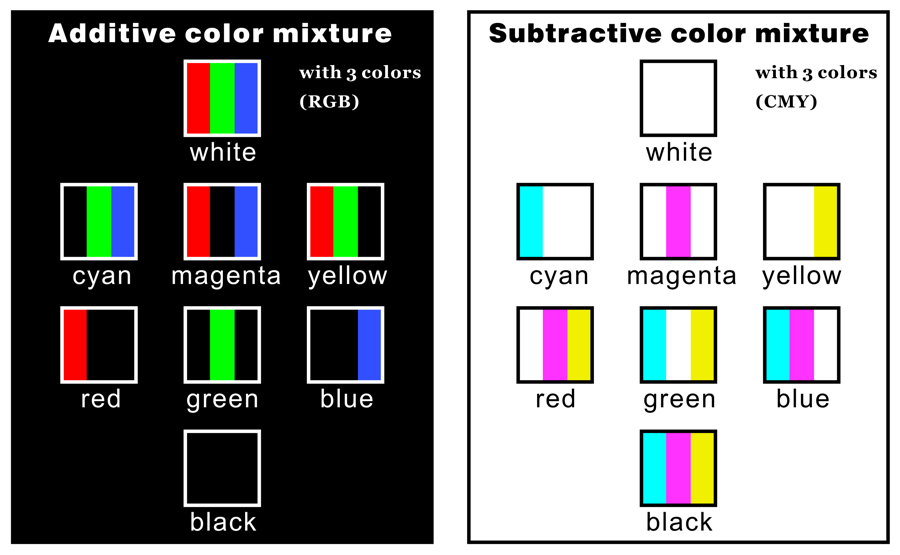
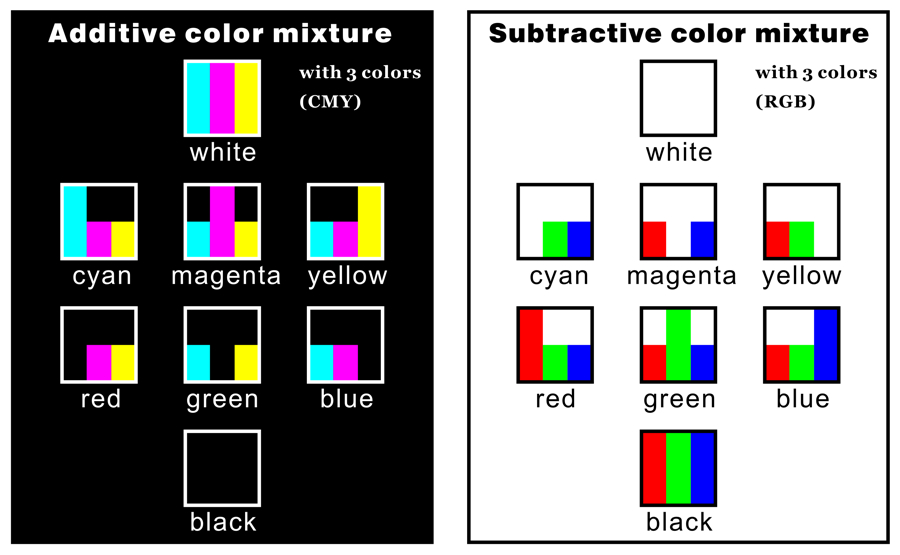
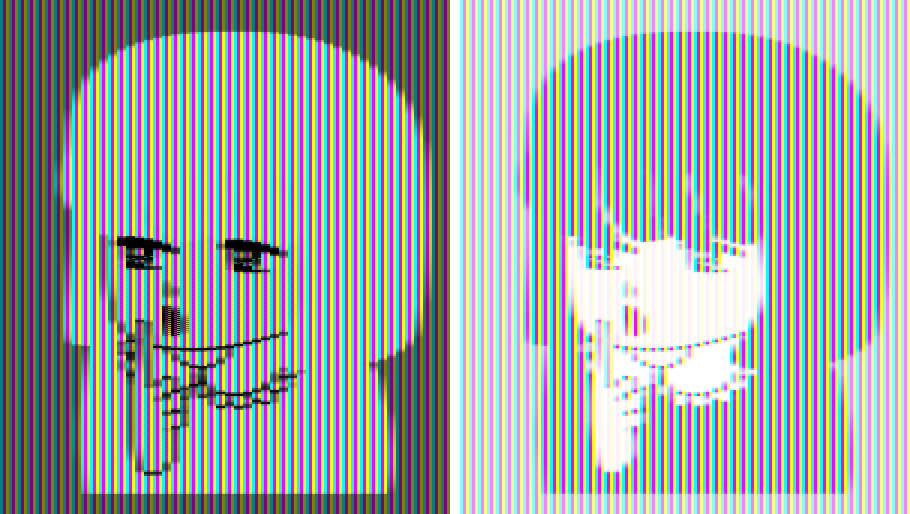
「CMYで白と黒」
左の絵の髪と服は白く見え、右の絵では黒く見えるが、同じCMYの縞模様である。
Copyright Akiyoshi Kitaoka 2016 (August 15)
北岡明佳 (2016) RGBを原色とする減法混色の並置混色のアルゴリズムとその応用 日本視覚学会2016年夏季大会 朱鷺メッセ(新潟コンベンションセンター)(新潟市)・2016年8月18日(木) Poster --- Visiome
並置混色とムンカー錯視の関係
左のハートと物理的に同じ色は(1)(2)(3)のうちどれでしょう。
問1
問2
問3
問4 
2012/8/17
ムンカー錯視を用いた作品「赤の渦巻き」↓
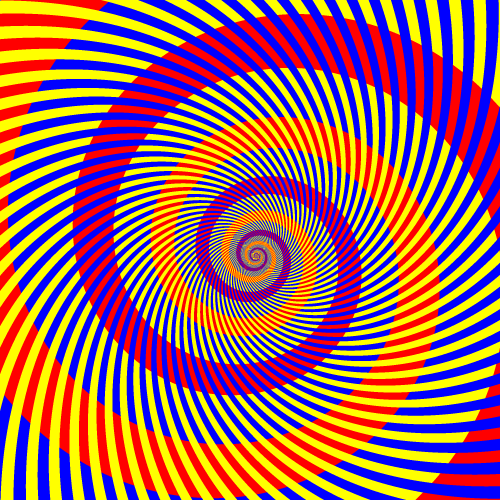
赤紫がかった赤い螺旋とオレンジ色がっかった赤い螺旋があるように見えるが、どちらも同じ赤である。
Copyright A.Kitaoka 2002
ムンカー錯視を用いた作品「緑の渦巻き」↓
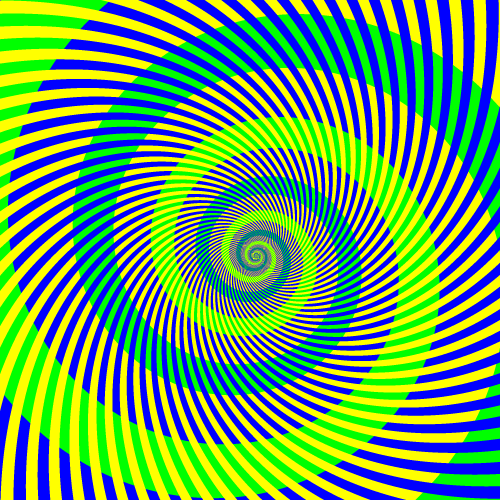
黄緑の螺旋と青緑の螺旋があるように見えるが、どちらも同じ緑である。
Copyright A.Kitaoka 2002
ムンカー錯視を用いた作品「水色と黄緑の渦巻き」↓
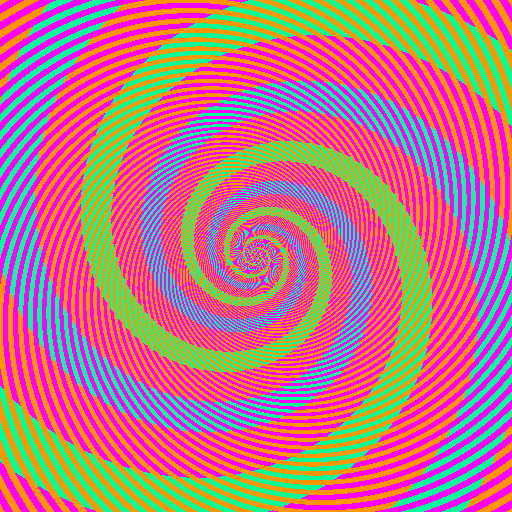
水色の螺旋と黄緑の螺旋があるように見えるが、どちらも同じ色(r = 0, g = 255, b = 150)である。この色の錯視はモニエ・シェベル錯視に近いと思うが、彼らの理論には合わないのかもしれない。
Copyright A.Kitaoka 2003
ムンカー錯視(Munker illusion)
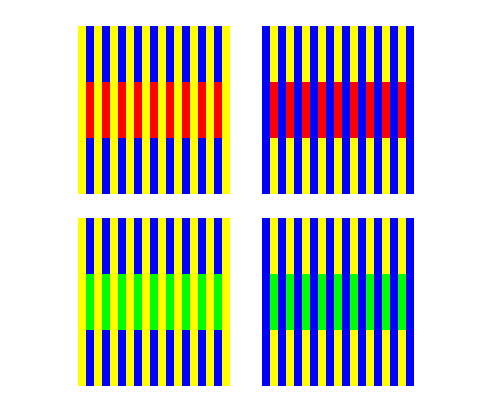
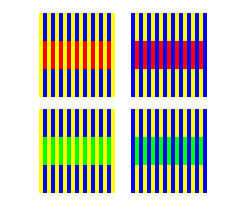
黄と青の縞の青部分に赤を乗せるとオレンジ色に見え、黄部分に赤を乗せると赤紫がかって見える。緑を乗せるとそれぞれ黄緑と青緑に見える。高空間周波数図形で錯視量が多い。
Munker, H. (1970) Farbige Gitter, Abbildung auf der Netzhaut und übertragungstheoretische Beschreibung der Farbwahrnehmung. München: Habilitationsschrift.
ムンカー錯視の作り方
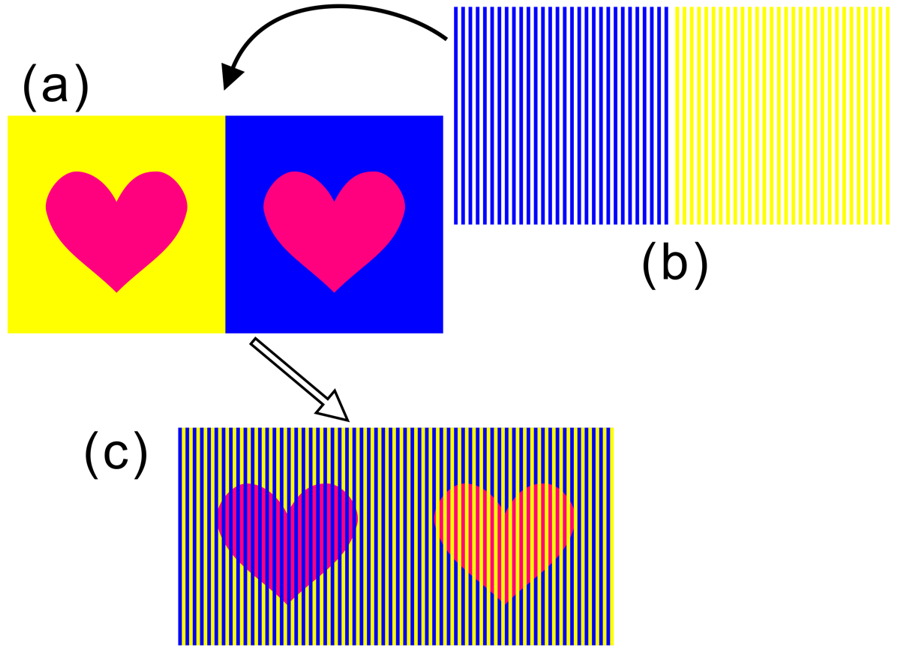
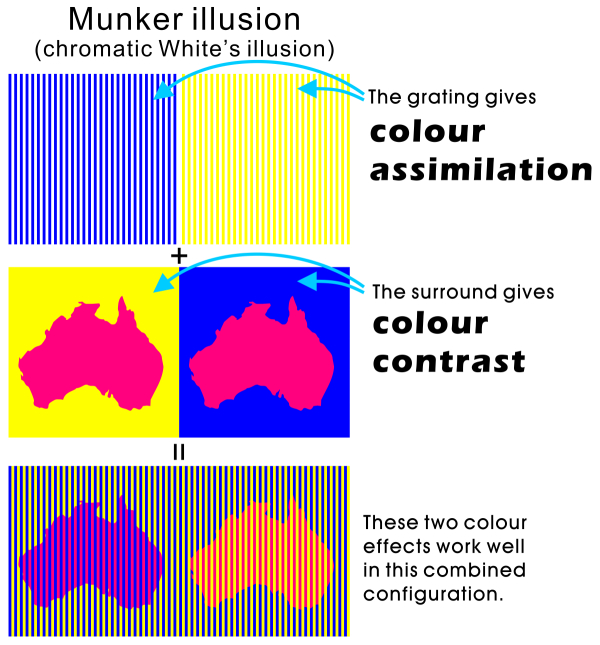
Left: Blue (assimilation) + Blue (contrast of yellow) = Blue induction; Right: Yellow (assimilation) + Yellow (contrast of blue) = Yellow induction
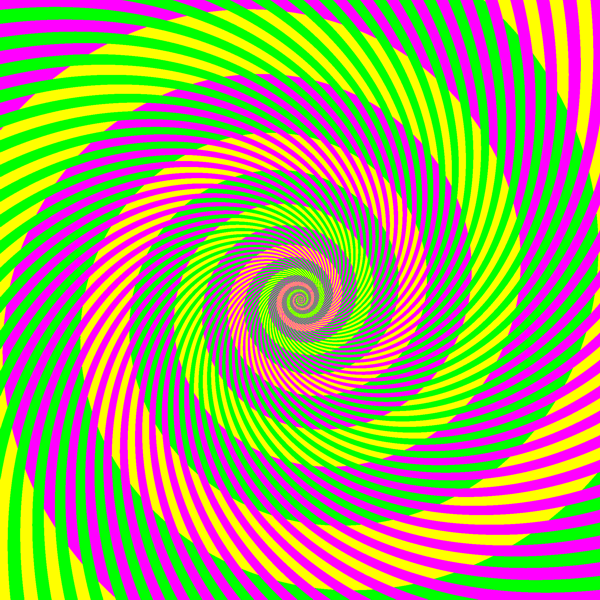
「レモン色の渦巻きとクリーム色の渦巻き」
渦巻きにはレモン色のとクリーム色のと2種類あるように見えるが、どちらも同じ黄色(R255, G255, B0)である。
Copyright A.Kitaoka 2005 (May 22)
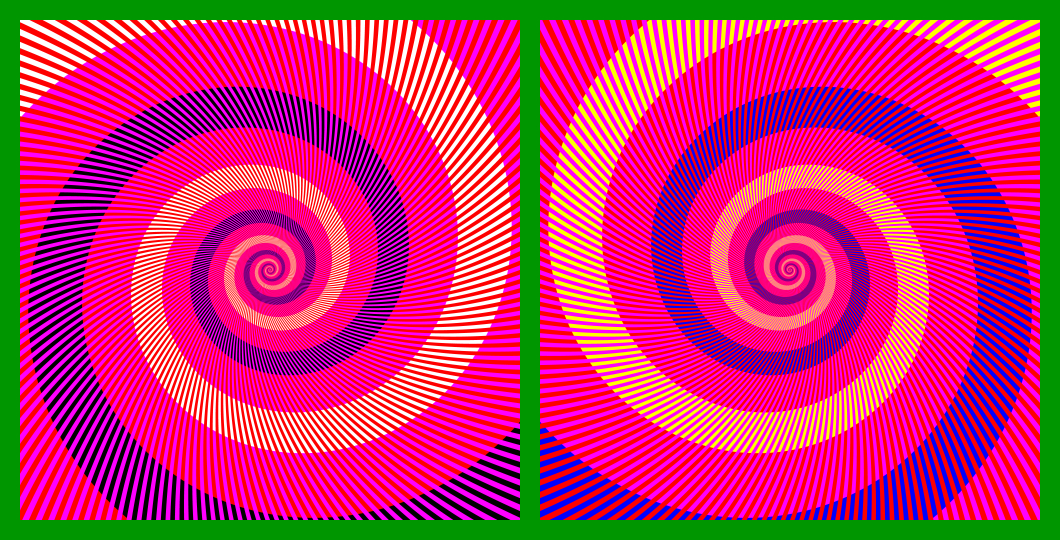
「武田信玄」
薄い黄色と濃い青色の渦巻きがあるように見えるが、左半分は白(R=255, G=255, B=255)と黒(R=0, G=0, B=0)であるのに対し、右半分は黄(R=255, G=255, B=0)と青(R=0, G=0, B=255)である。
Copyright Akiyoshi .Kitaoka 2007 (March 12)
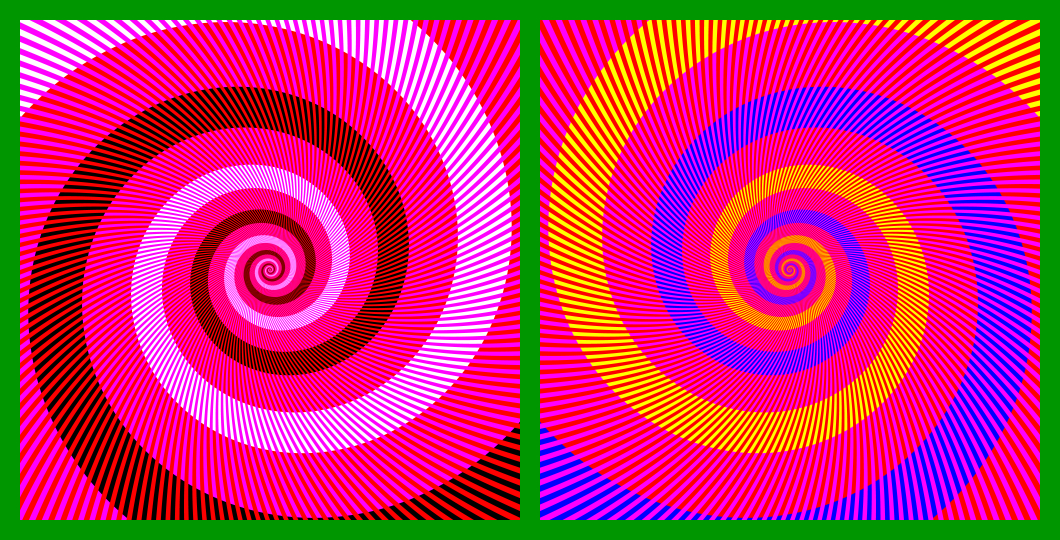
「風林火山」
「武田信玄」の白黒黄青と同じであるが、この図では違いがはっきりわかる。
Copyright Akiyoshi .Kitaoka 2007 (March 12)
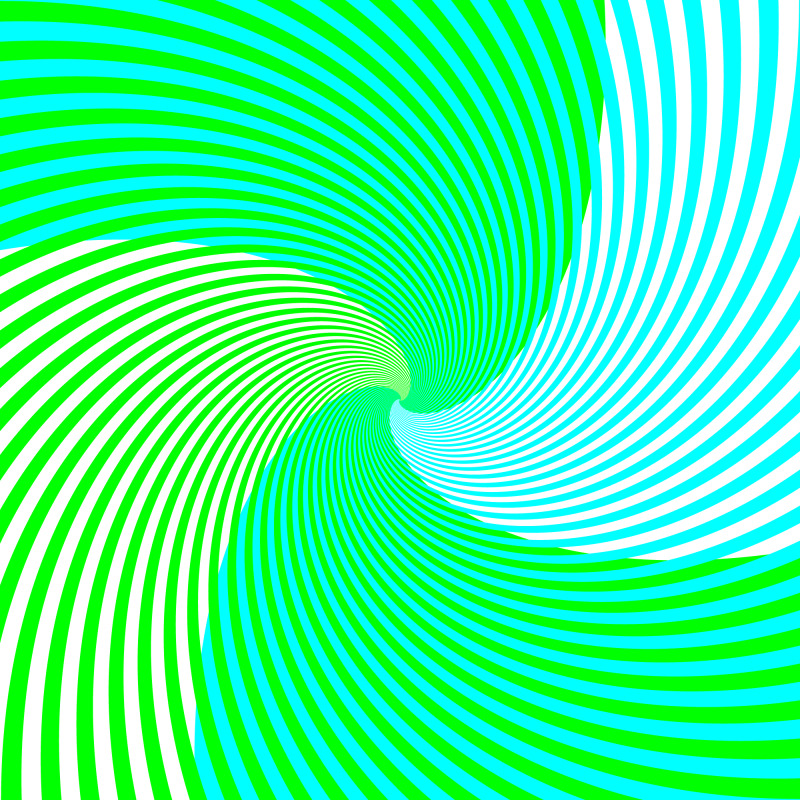
「小家族」
左の鳩も右の鳩も同じ色なのだが、左の方は黄味がかって見える。
Copyright Akiyoshi .Kitaoka 2007 (March 12)
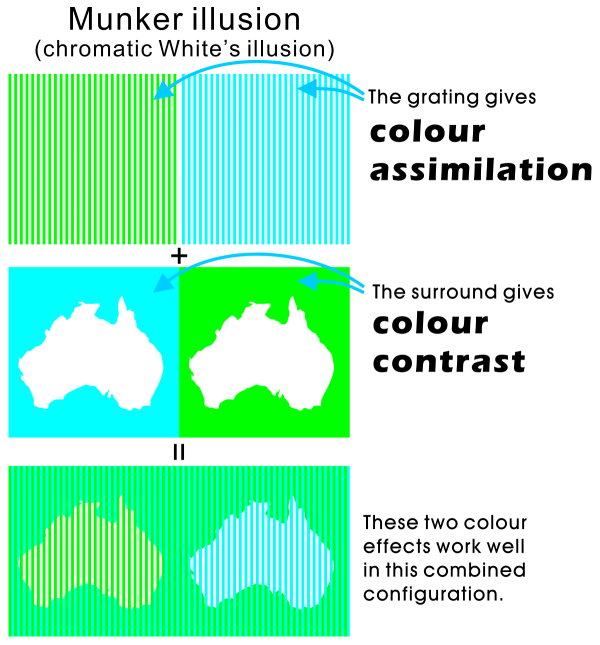
Left: Green (assimilation) + Red (contrast of cyan) = Yellow induction; Right: Cyan (assimilation) + Magenta (contrast of Green) = Blue induction
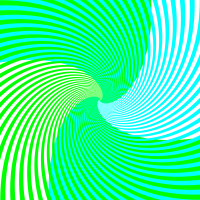 OK?
OK?
色の土牢錯視 (Chromatic dungeon illusion)
「犬」
赤い犬は2種類、緑の犬も2種類いるように見えるが、それぞれ同じ赤と緑である。色の土牢錯視である。
別バージョン 別バージョン2
Copyright Akiyoshi .Kitaoka 2007 (January 5)
土牢錯視(dungeon illusion)(Bressan, 2001)とは?
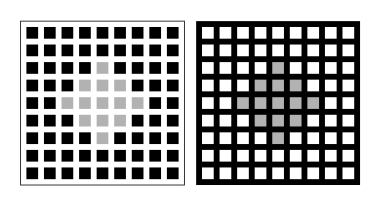
左の「牢屋」の灰色のダイヤモンド形は右のよりも明るく見えるが、物理的には同じ明るさである。
Bressan, P. (2001) Explaining lightness illusions. Perception, 30, 1031-1046.
色の土牢錯視とは?
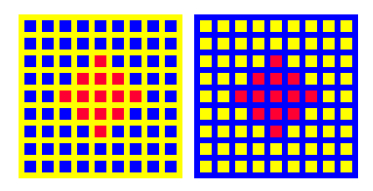
左の「牢屋」のダイヤモンド形はオレンジ色に、右のは少し紫がかった赤に見えるが、物理的には同じ色である。
引用文献は調査中(ないかもしれない)
色の土牢錯視は雰囲気はムンカー錯視だが、普通に色の同化で説明することも可能だし、ゲシュタルト要因を考えて色の対比というのもあるのかもしれない。
「四色の犬」
上から1番目と3番目の列の犬は2種類、2番目と4番目の列の犬も2種類いるように見えるが、それぞれ同じ色である。色の土牢錯視である。
Copyright Akiyoshi .Kitaoka 2007 (January 5)
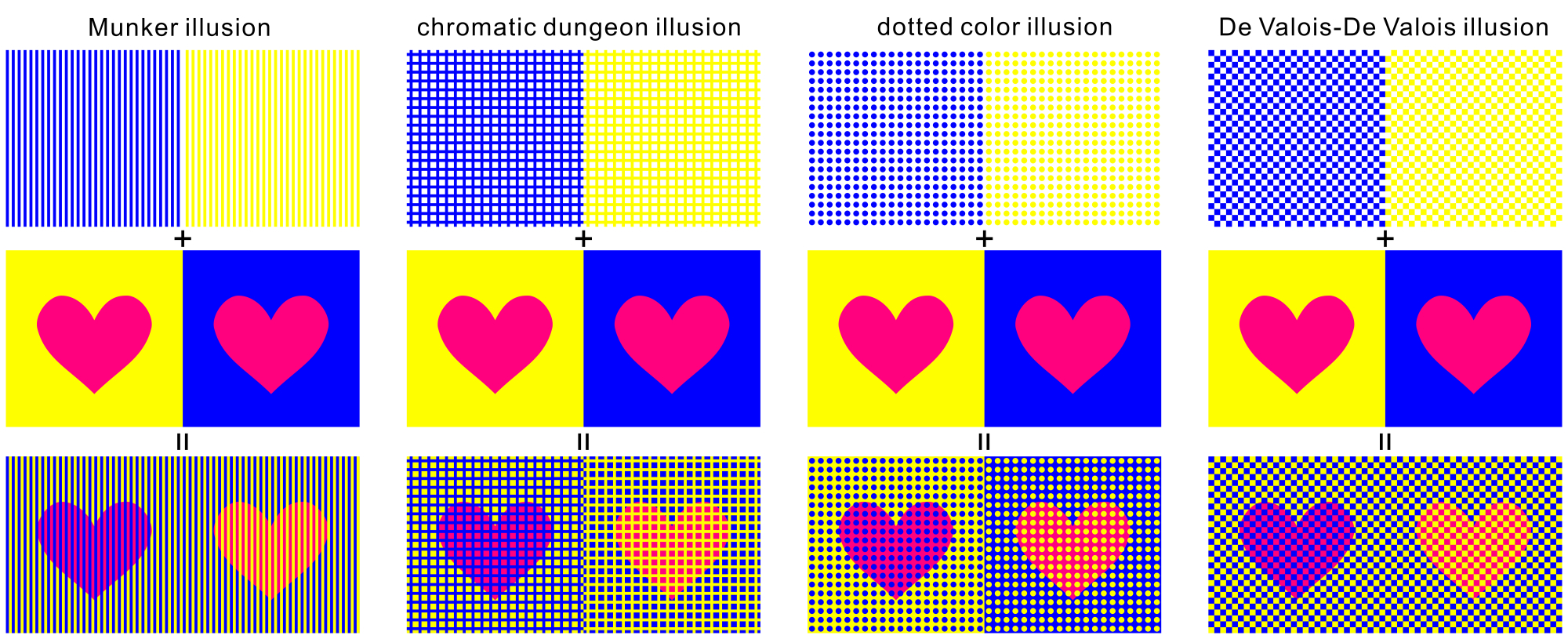
「4種類の色の錯視の作り方」
物理的に同じ色(R=255, G=0, B=127)のハートが錯視によってピンクとオレンジのハートに見える。左から、ムンカー錯視(Munker illusion)、色の土牢錯視(chromatic dungeon illusion)、ドット色錯視(dotted color illusion)、デヴァロイス・デヴァロイス錯視(De Valois-De Valois illusion)である。 上図の高解像度ファイルはこちら(8000 x 3262 pixel, 10MB)。
Copyright Akiyoshi Kitaoka 2009 (June 1)
References
| Munker illusion | Munker, H. (1970) Farbige Gitter, Abbildung auf der Netzhaut und übertragungstheoretische Beschreibung der Farbwahrnehmung. Habilitationsschrift, Ludwig-Maximilians-Universität, München. |
| chromatic dungeon illusion | For the dungeon illusion: Bressan, P. (2001) Explaining lightness illusions.
Perception, 30, 1031-1046. Kitaoka (2007) http://www.psy.ritsumei.ac.jp/~akitaoka/saishin22e.html |
| dotted color illusion | For the dotted brightness illusion: White, M. (1982) The assimilation-enhancing effect of a dotted surround upon a dotted test region. Perception, 11, 103-106. Kitaoka (2008) http://www.psy.ritsumei.ac.jp/~akitaoka/color10e.html |
| De Valois-De Valois illusion | De Valois, R. L. and De Valois, K. K. (1988) Spatial Vision. New York: Oxford University Press. |
北岡明佳 (2012) 色の錯視いろいろ (4) 簡単で錯視量の多い色相の錯視図形の作り方 日本色彩学会誌, 36(1), 45-46. PDF(スキャンコピー) <配布資料>
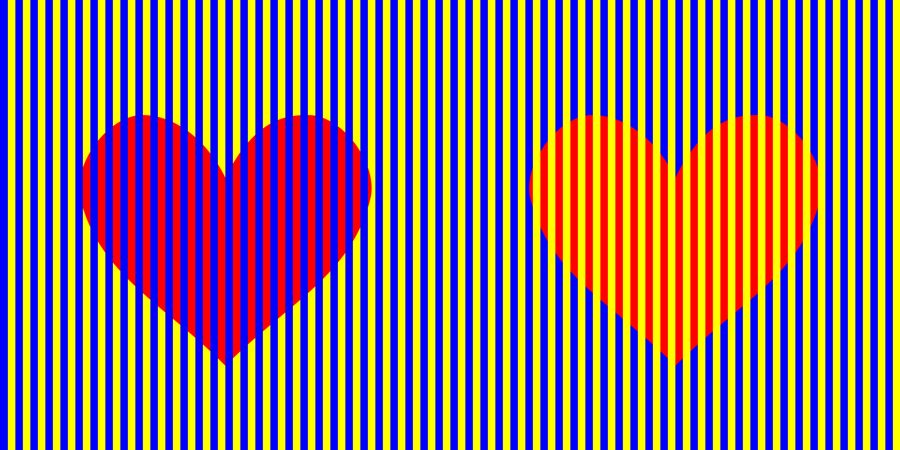
「標準的なムンカー錯視」
左のハートは赤紫に見え、右のハートはオレンジ色に見えるが、同じ赤である。
Copyright Akiyoshi Kitaoka 2015 (June 2)
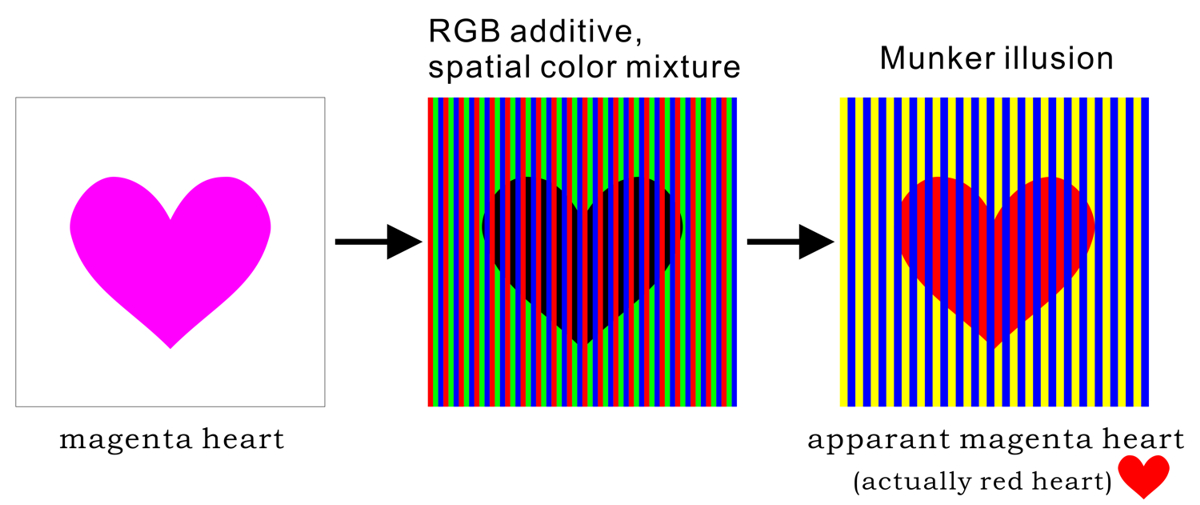
下図は拡大画像
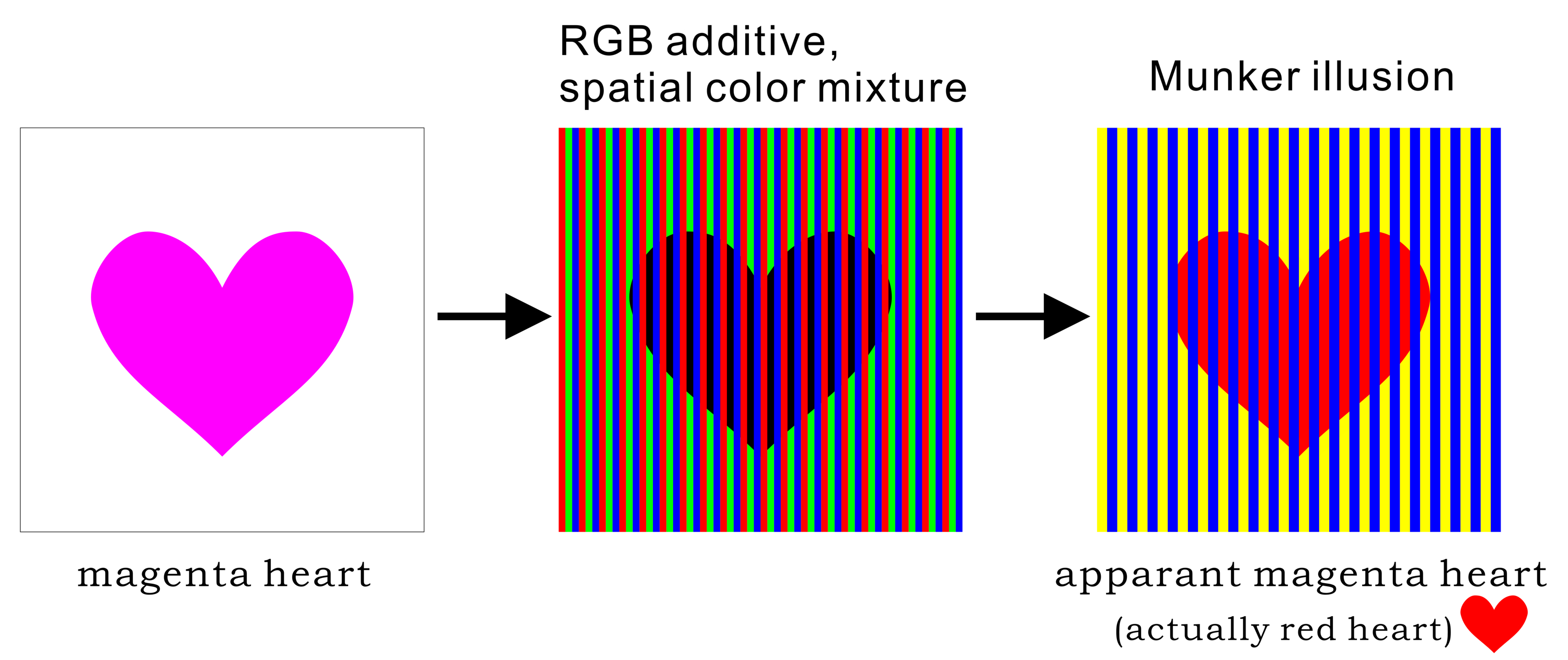
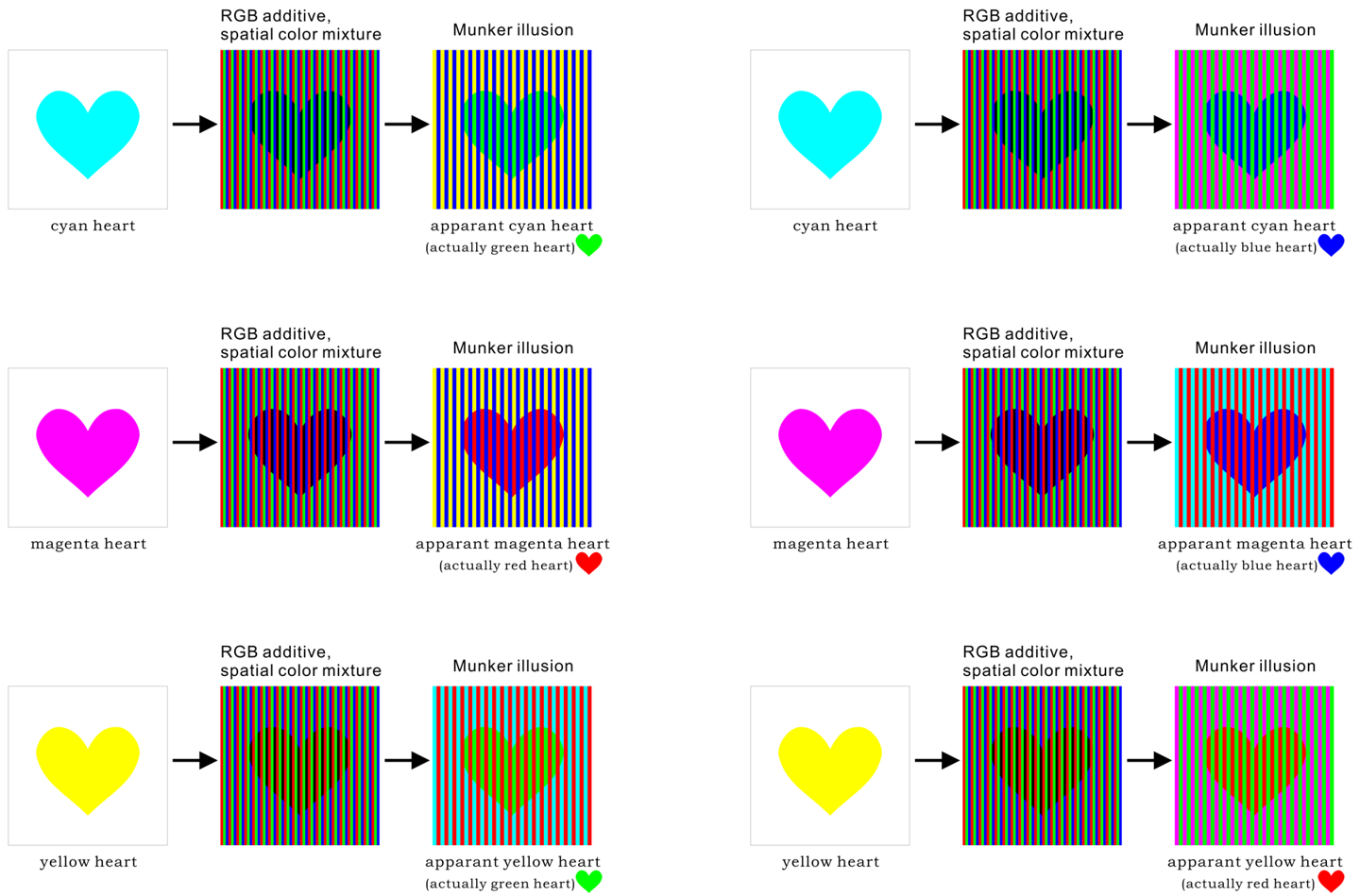
「加法混色の並置混色によるムンカー錯視の説明図」
Copyright Akiyoshi Kitaoka 2016 (March 22)
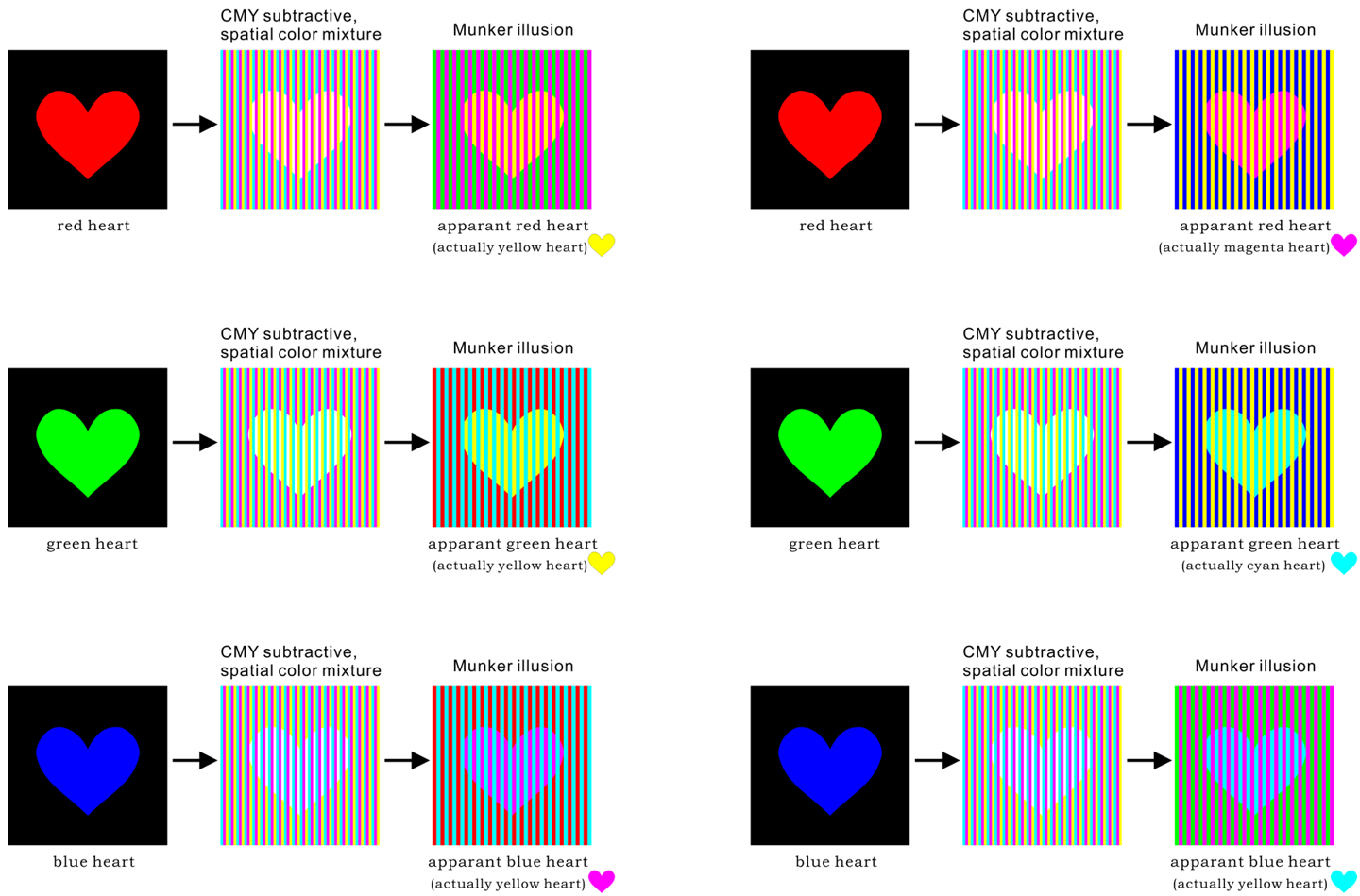
「減法混色の並置混色によるムンカー錯視の説明図」
Copyright Akiyoshi Kitaoka 2016 (March 22)

「標準的なムンカー錯視」
左のハートは赤紫に見え、右のハートはオレンジ色に見えるが、同じ赤である。
Copyright Akiyoshi Kitaoka 2015 (June 2)
オレンジ色に見える錯視の方はこのモデルにぴったり当てはまらない。
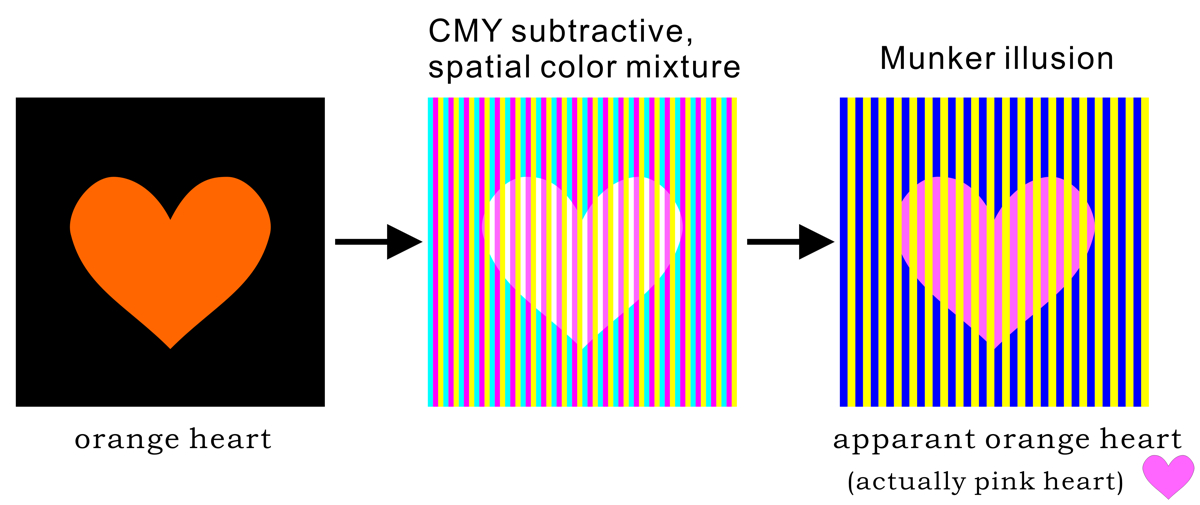
Copyright Akiyoshi Kitaoka 2017 (March 4)
図地分離との関係
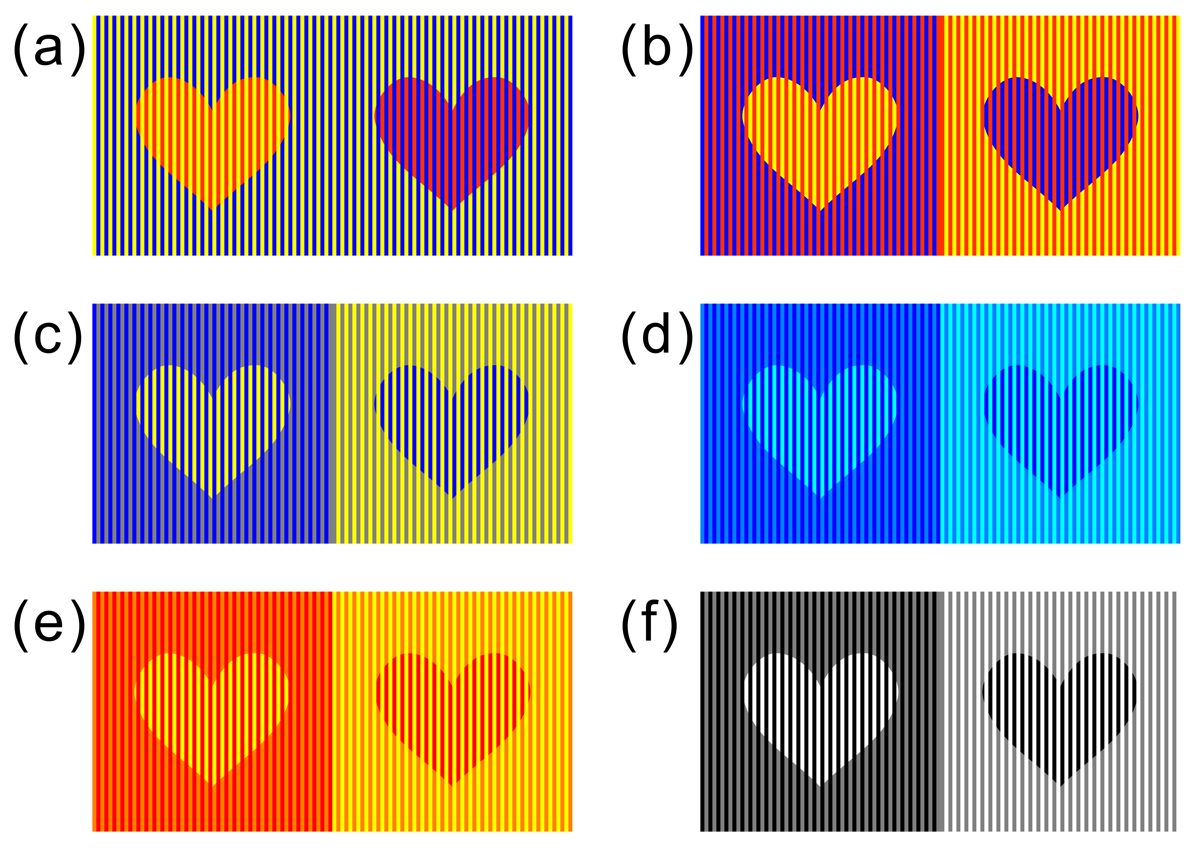
北岡明佳 (2012) 色の錯視いろいろ (6) 図地分離による錯視 日本色彩学会誌, 36(3), 237-238. PDF(スキャンコピー)
色依存のフレーザー・ウィルコックス錯視でシステム視覚科学する試み
There are so many motion illusions in stationary images. First, I talk
about the Fraser-Wilcox illusion group, which is characterized by 'automatical'
illusory motion in the direction along special arrangements of visual stimuli.
Kitaoka, A. (2014). Color-dependent motion illusions in stationary images and their phenomenal dimorphism. Perception, 43(9), 914-925.
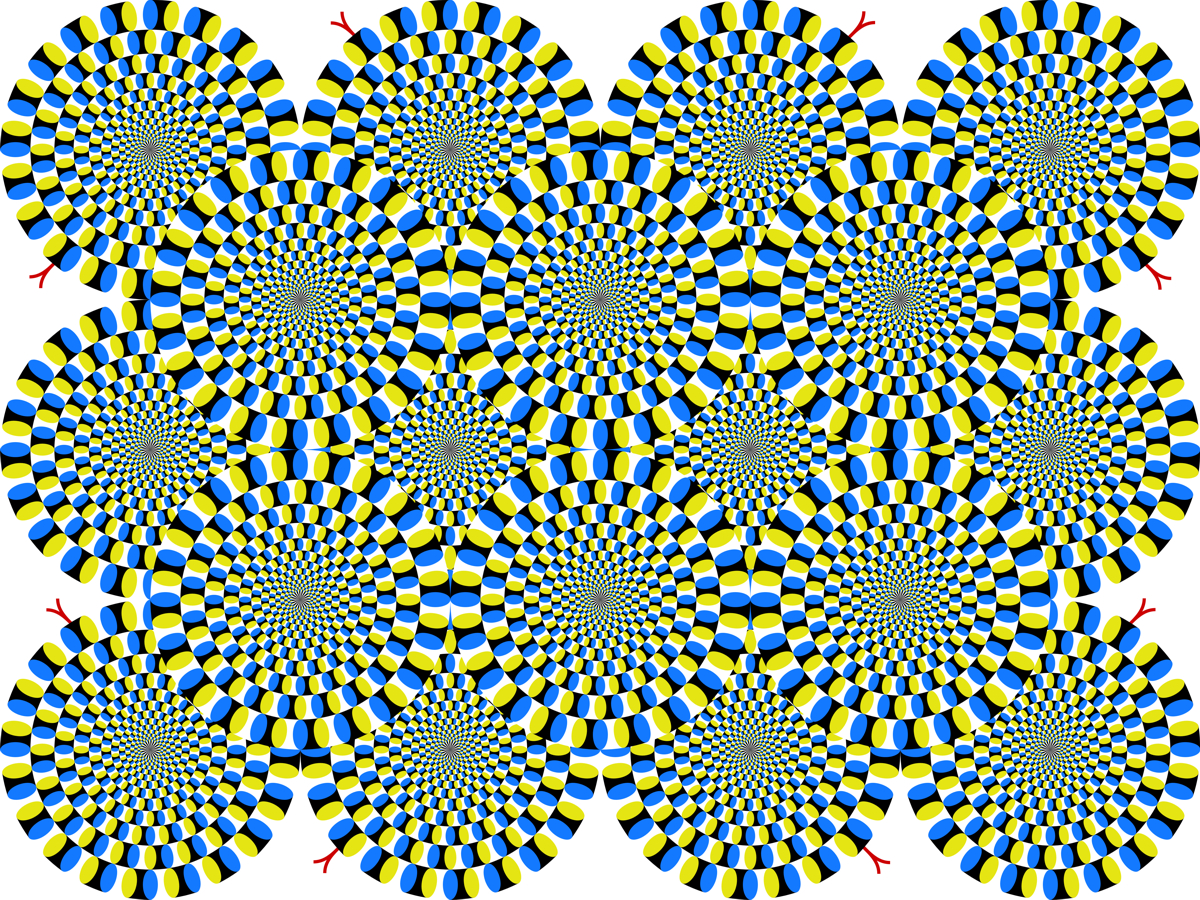
"Rotating snakes"
Each disk appears to rotate 'spontaneously' in the constant direction, from black to blue, white, yellow, back to black.
Copyright Akiyoshi Kitaoka 2003 (September 2) (updated February 16, 2013)
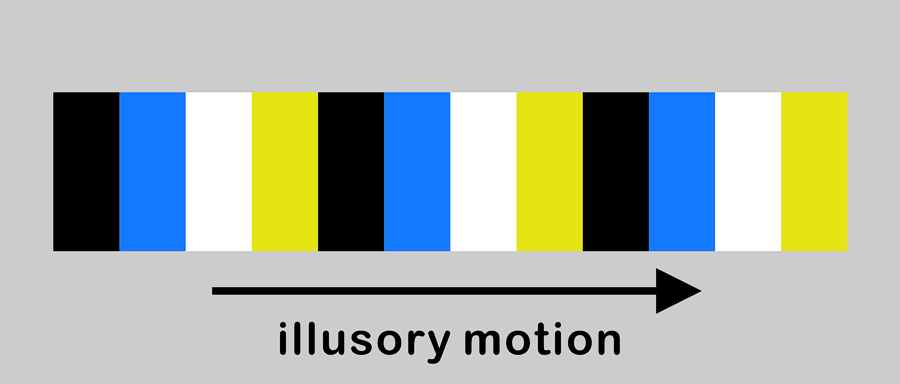
Color is not indispensable. Gray-scale images also work.
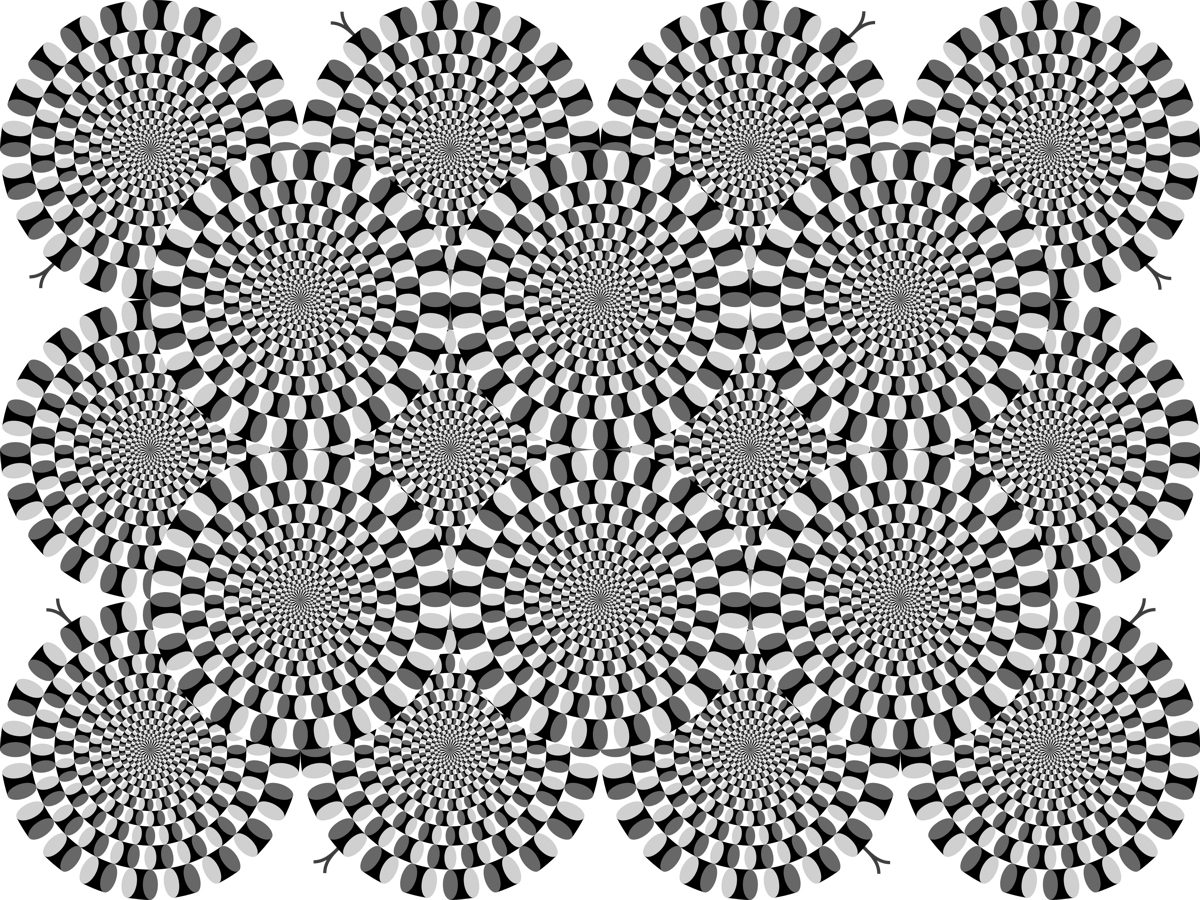
"Rotating snakes: a gray scale version"
Each disk appears to rotate 'spontaneously' in the constant direction, from black to dark gray, white, light gray, back to black.
Copyright Akiyoshi Kitaoka 2013 (May 27)
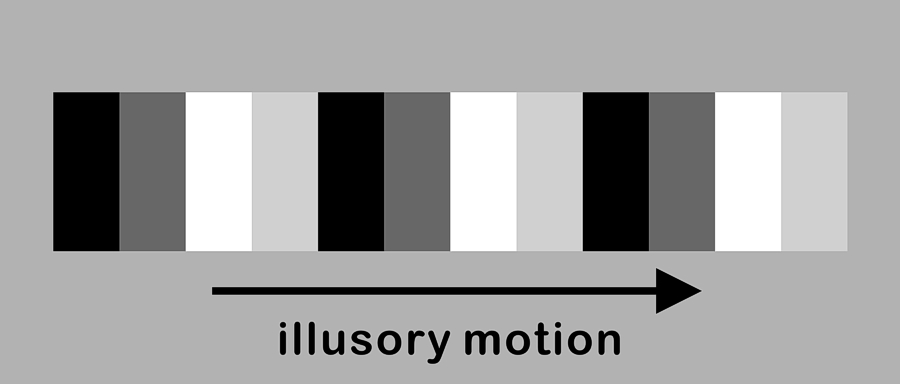
A few years ago I discovered the color-dependent motion illusion.
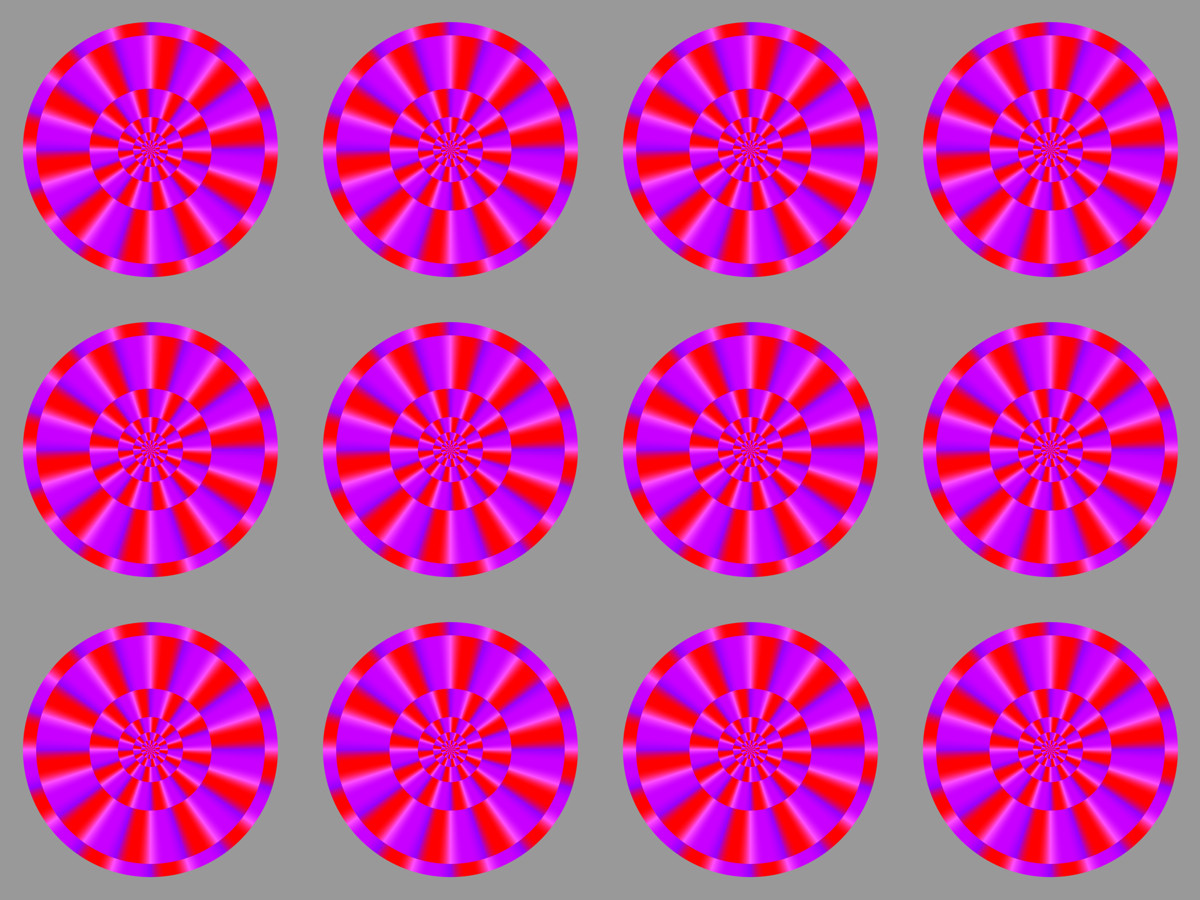
Copyright Akiyoshi Kitaoka 2013 (February 6)
Figure 6 of Kitaoka, A. (2014). Color-dependent motion illusions in stationary images and their phenomenal dimorphism. Perception, 43(9), 914-925.
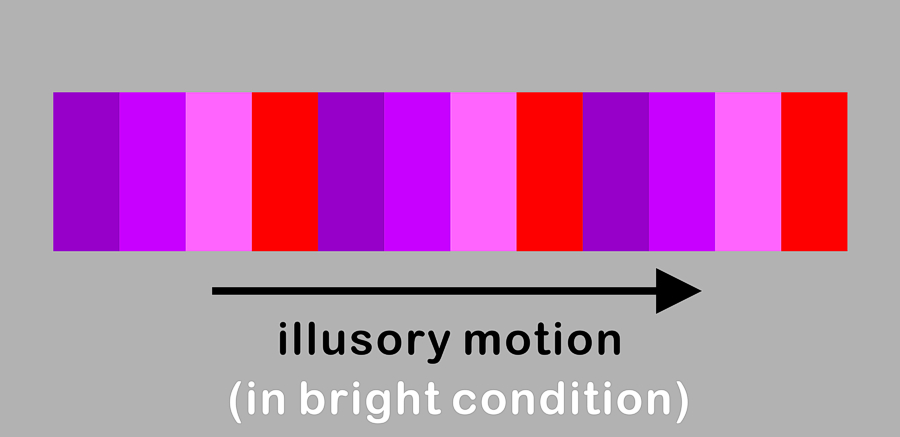
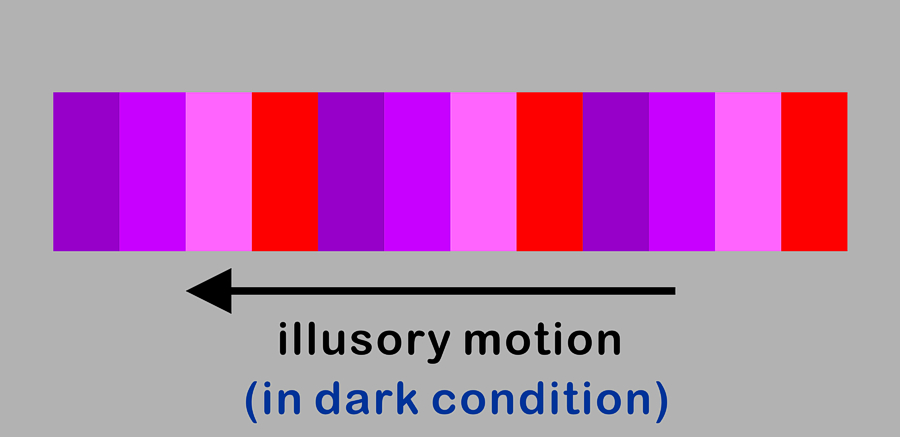
Fraser and Wilcox showed a new phenomenon that stationary disks appear to rotate. They reported bimorphism or bistability of this illusion.
1. Fraser and Wilcox (1979)
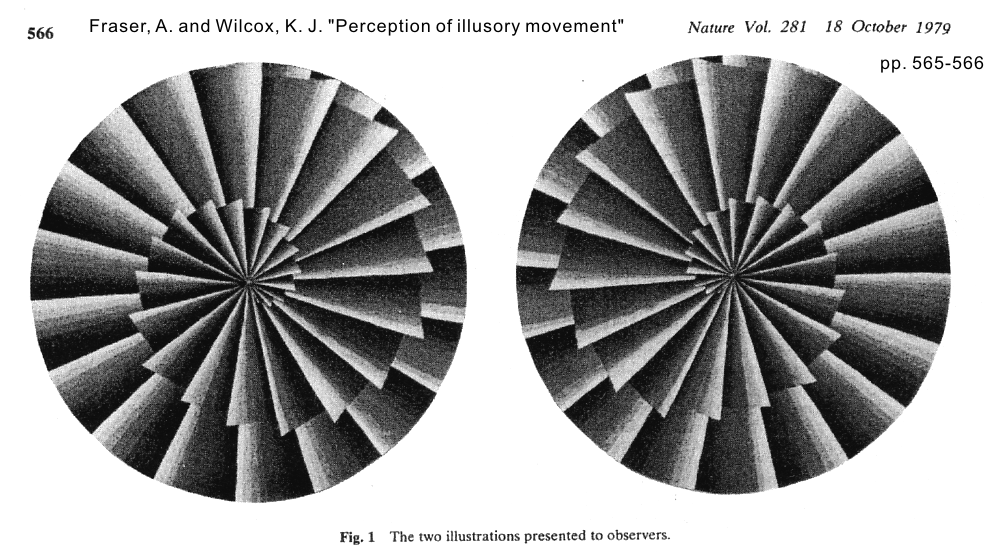
Fraser, A. and Wilcox, K. J. (1979) Perception of illusory movement. Nature, 281, 565-566.
Ambiguity in the direction of illusory rotation
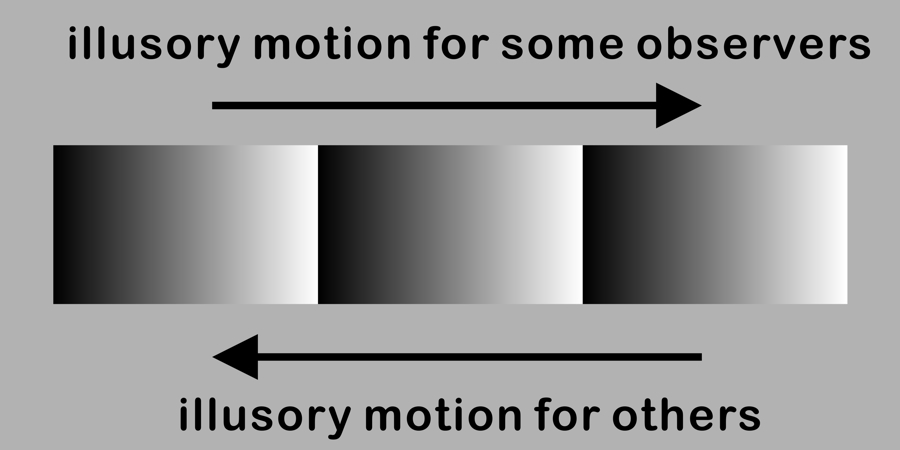
Alex Fraser was a professor of genetics and a painter!
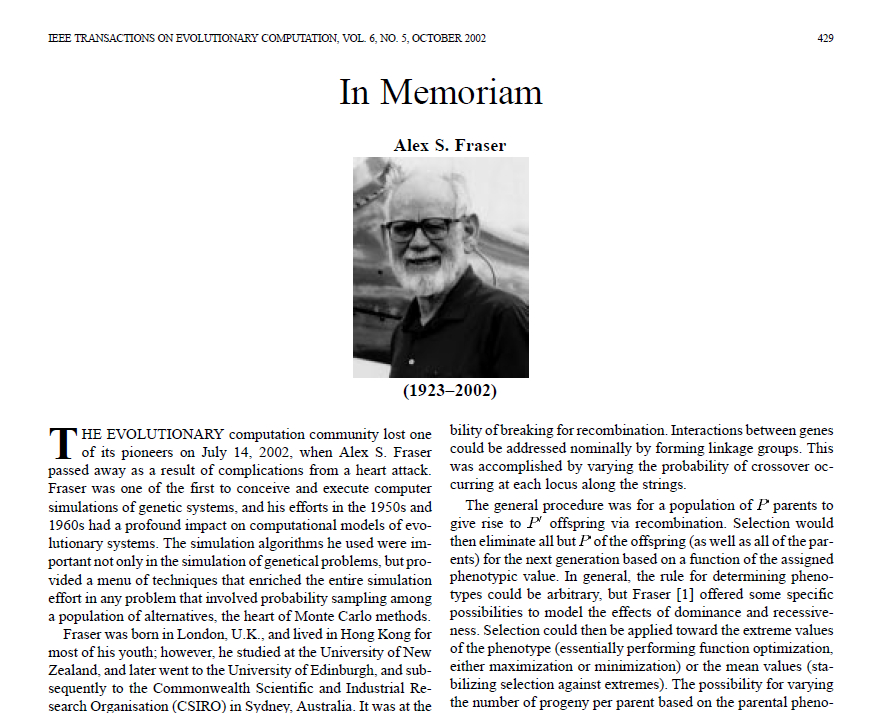
Fogel, D. B. (2002). In Memoriam: Alex S. Fraser (1923–2002). IEEE Transactions on Evolutionary Computation, 6(5), 429-430.
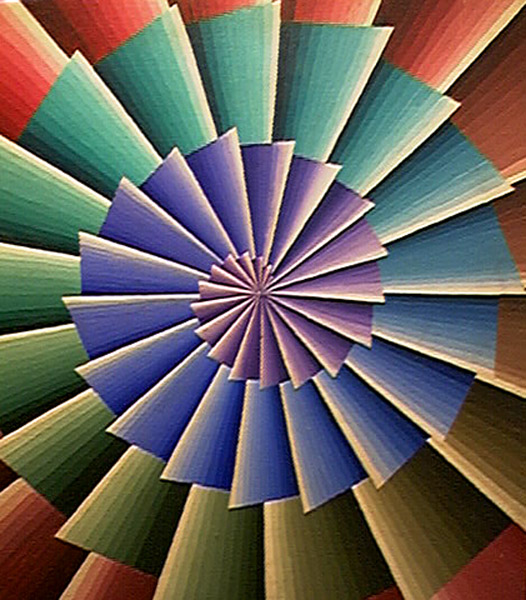
Alex Fraser's original work
Adopted with permission from Alan Fraser (2006) "Alex Fraser, Geneticist and Painter" http://doctoralexfraser.blogspot.jp/
The perceptual bimorphism proposed by Fraser and Wilcox (1979) was not replicated for subsequent two decades.
2. Faubert and Herbert (1999)
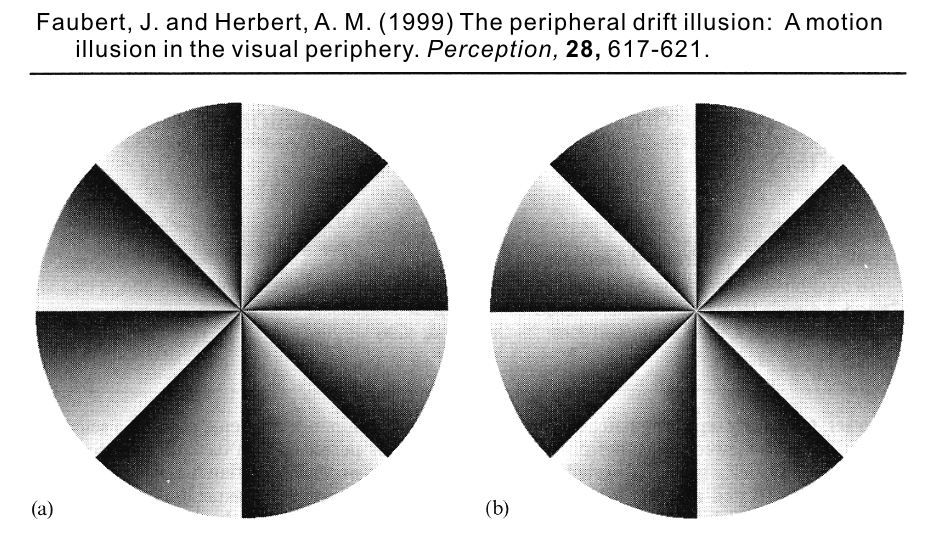
Faubert, J. and Herbert, A. M. (1999) The peripheral drift illusion: A motion illusion in the visual periphery. Perception, 28, 617-621.
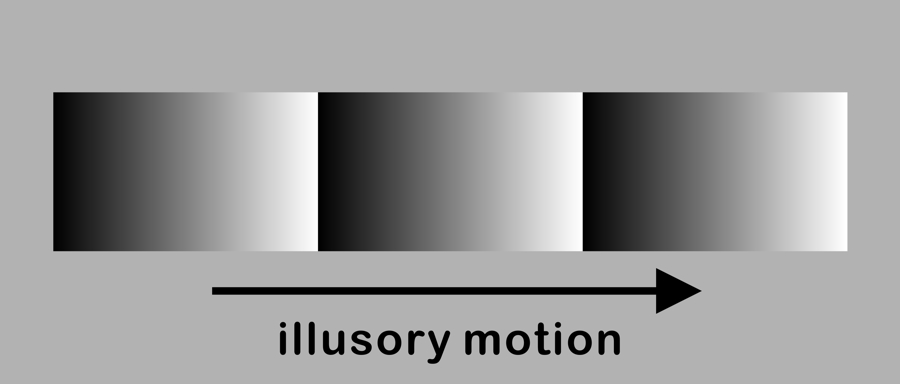
3. Naor-Raz and Sekuler (2000)
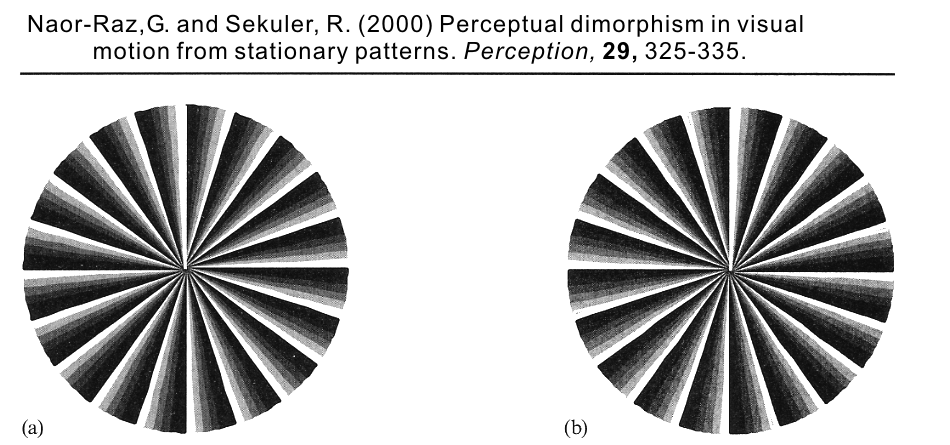
Naor-Raz, G. and Sekuler, R. (2000) Perceptual dimorphism in visual motion from stationary patterns. Perception, 29, 325-335.
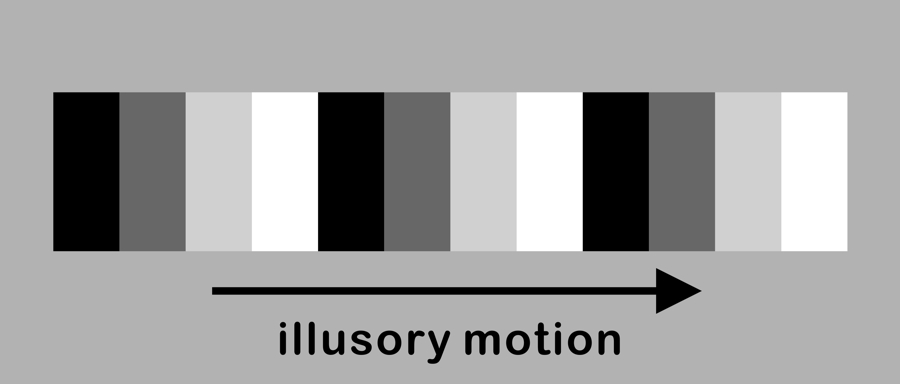
We separated two illusions that cancel each other and proposed the optimized Fraser-Wilcox illusion.
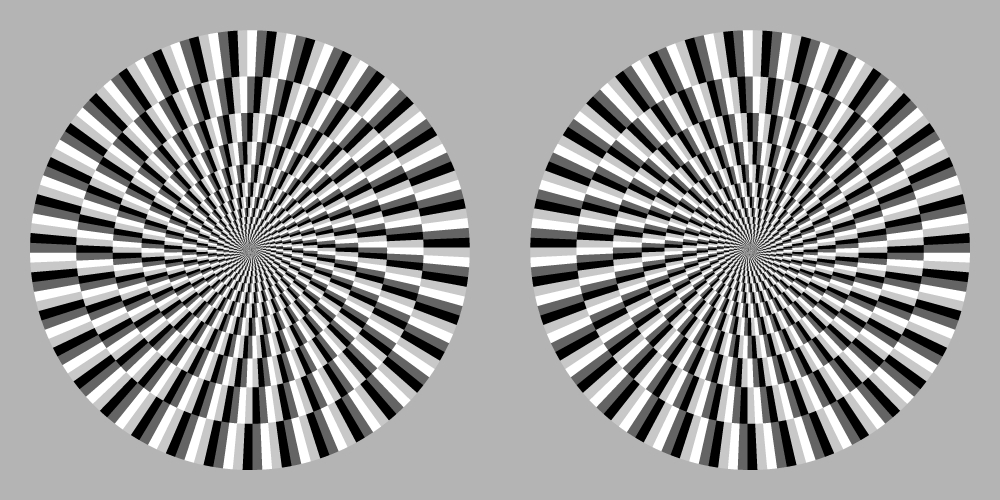
Kitaoka, A. and Ashida, H. (2003) Phenomenal characteristics of the peripheral drift illusion. VISION (Journal of the Vision Society of Japan), 15, 261-262. PDF

Two illusion are cooperatively combined.
There are a few types of the optimized Fraser-Wilcox illusion.
Luminance gradient type (Type I)

The left disk appears to rotate counterclockwise while the right one clockwise.
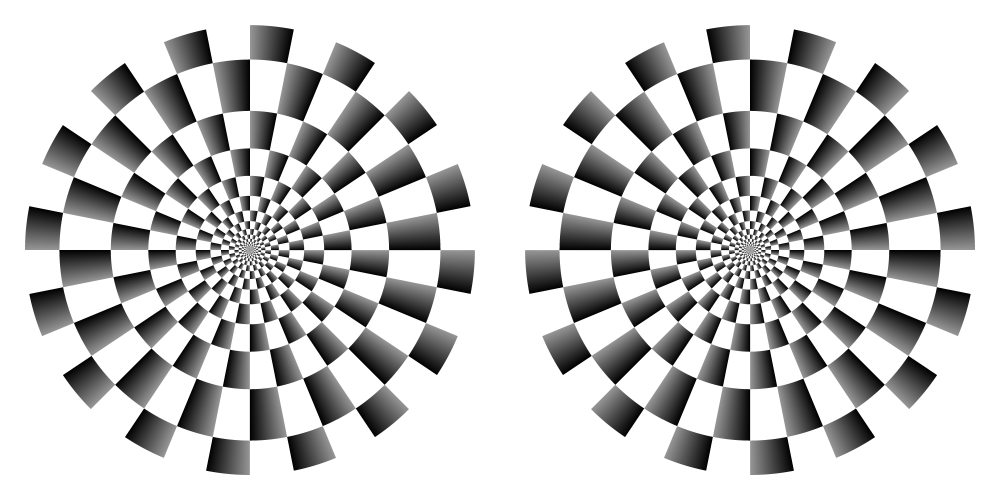
"Dark to light"
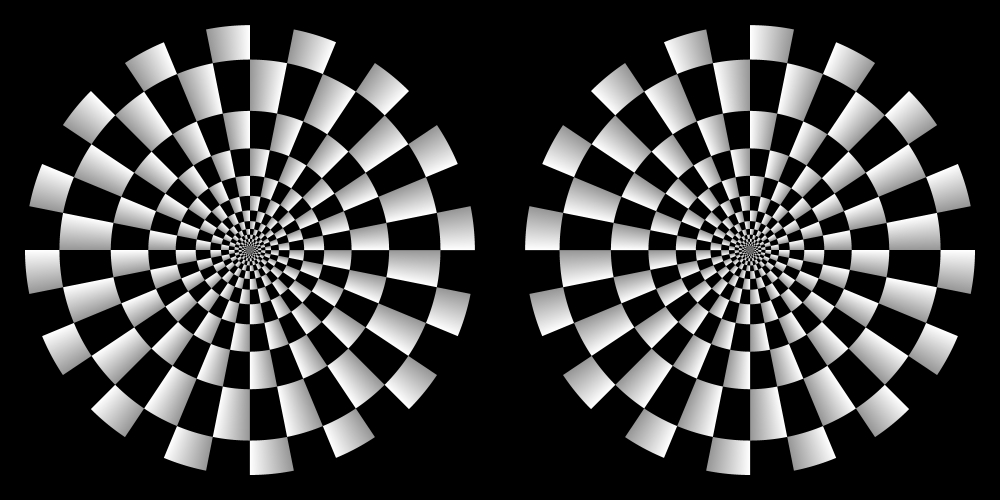
"Light to dark"
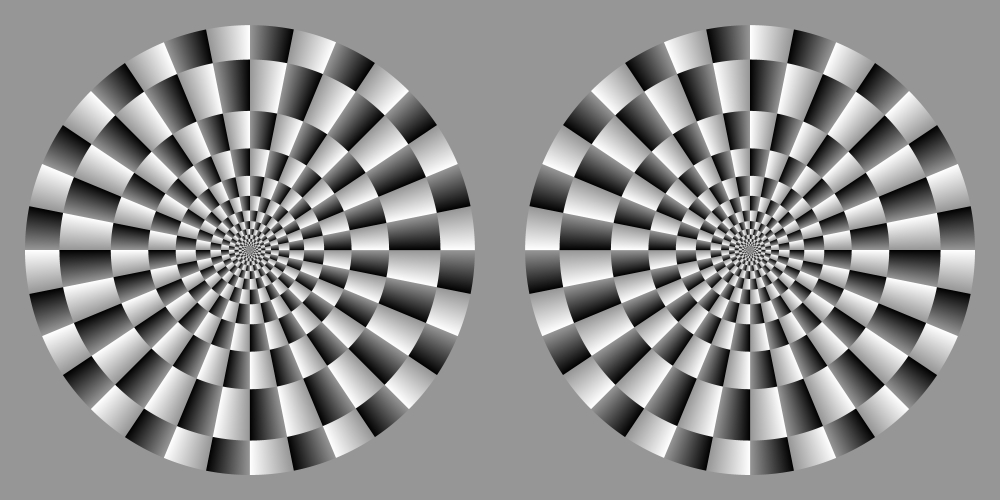
"Dark to light" and "Light to dark"
are combined, giving a stronger illusion
Color enhances illusion.
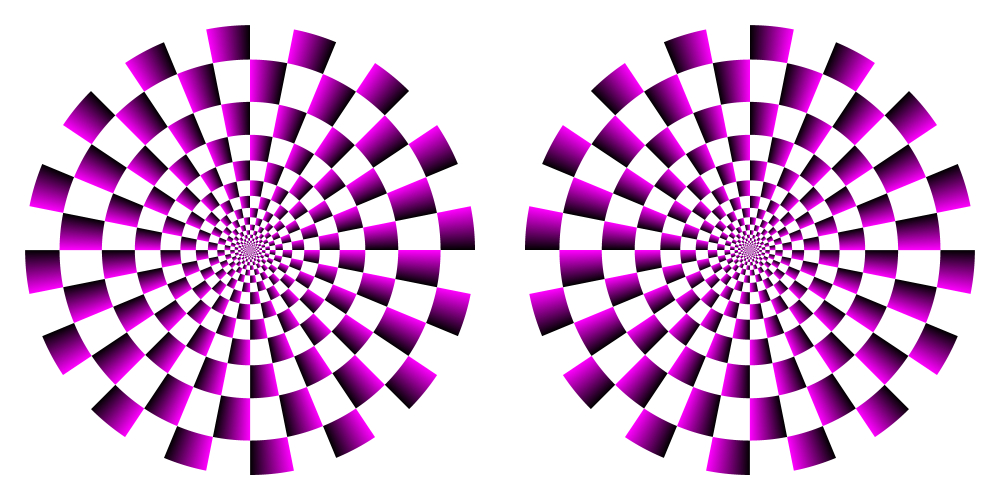
The illusion from dark to light is enhanced by red or blue.
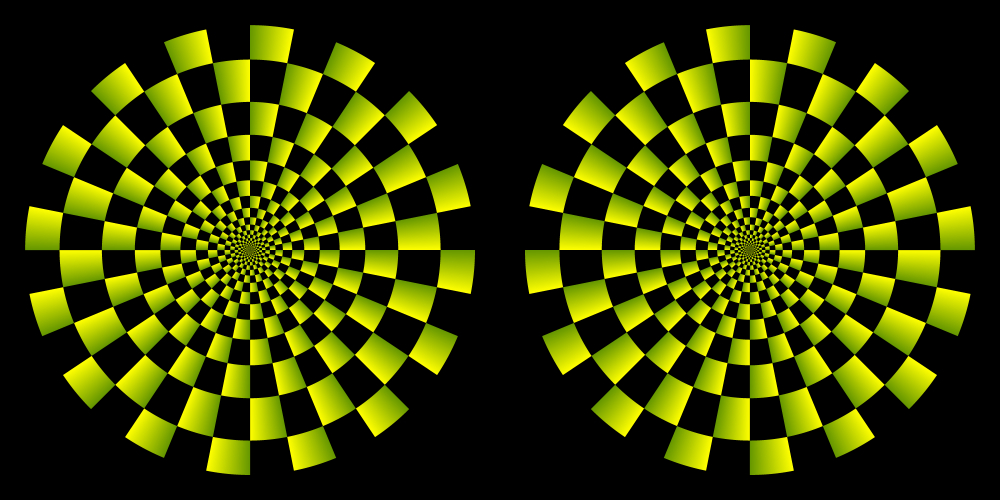
The illusion
from light to dark is enhanced by yellow or green.
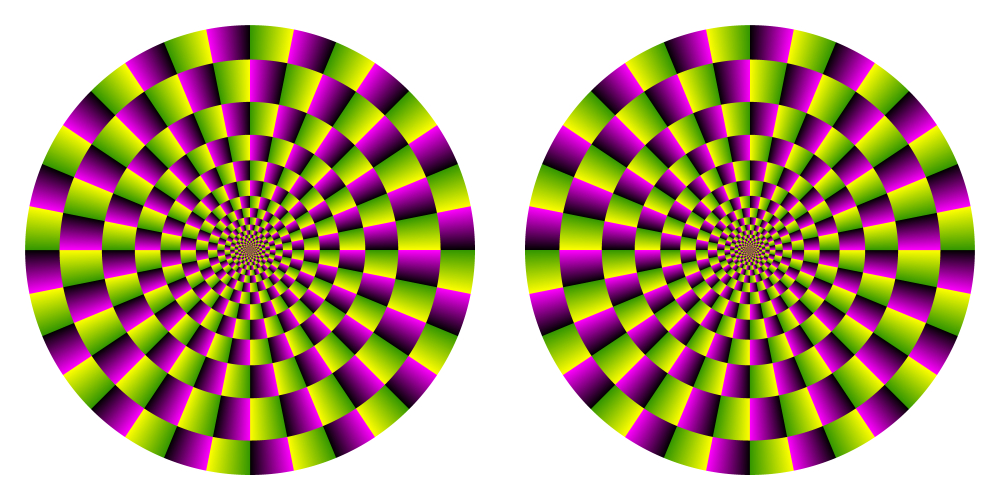
Both illusions work additively.
<Example> The upper-left, upper-right, and lower-middle disks appear
to rotate counterclockwise while the rest clockwise.
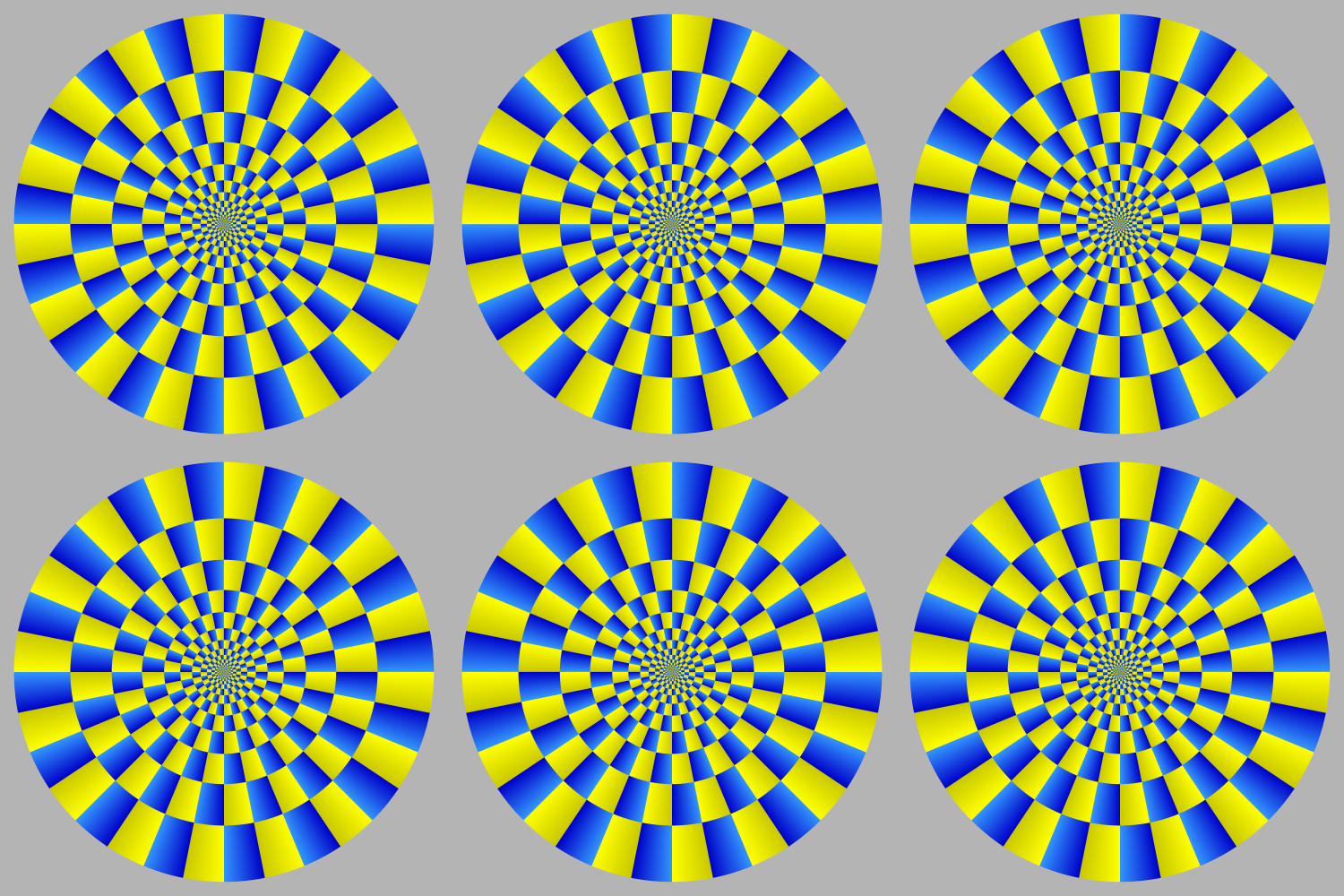
Luminance step type (Type II)
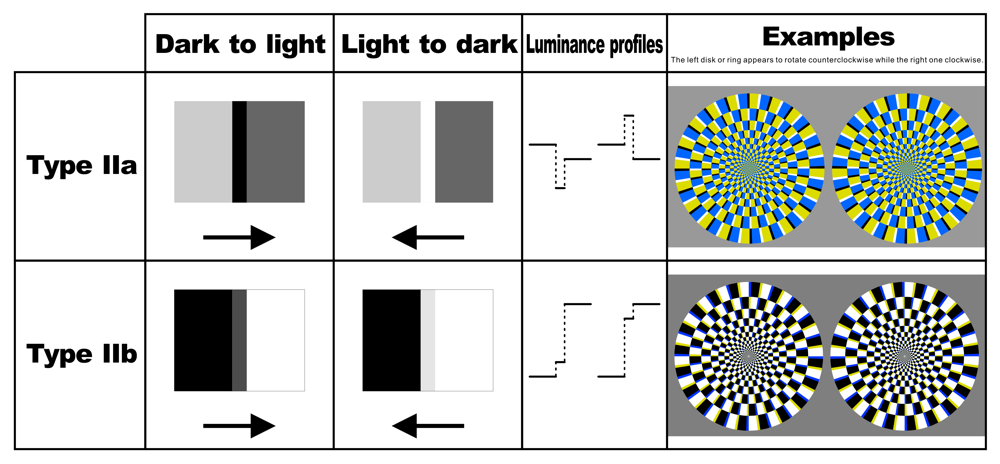
<Example> The upper-left, upper-right, and lower-middle disks appear
to rotate counterclockwise while the rest clockwise.
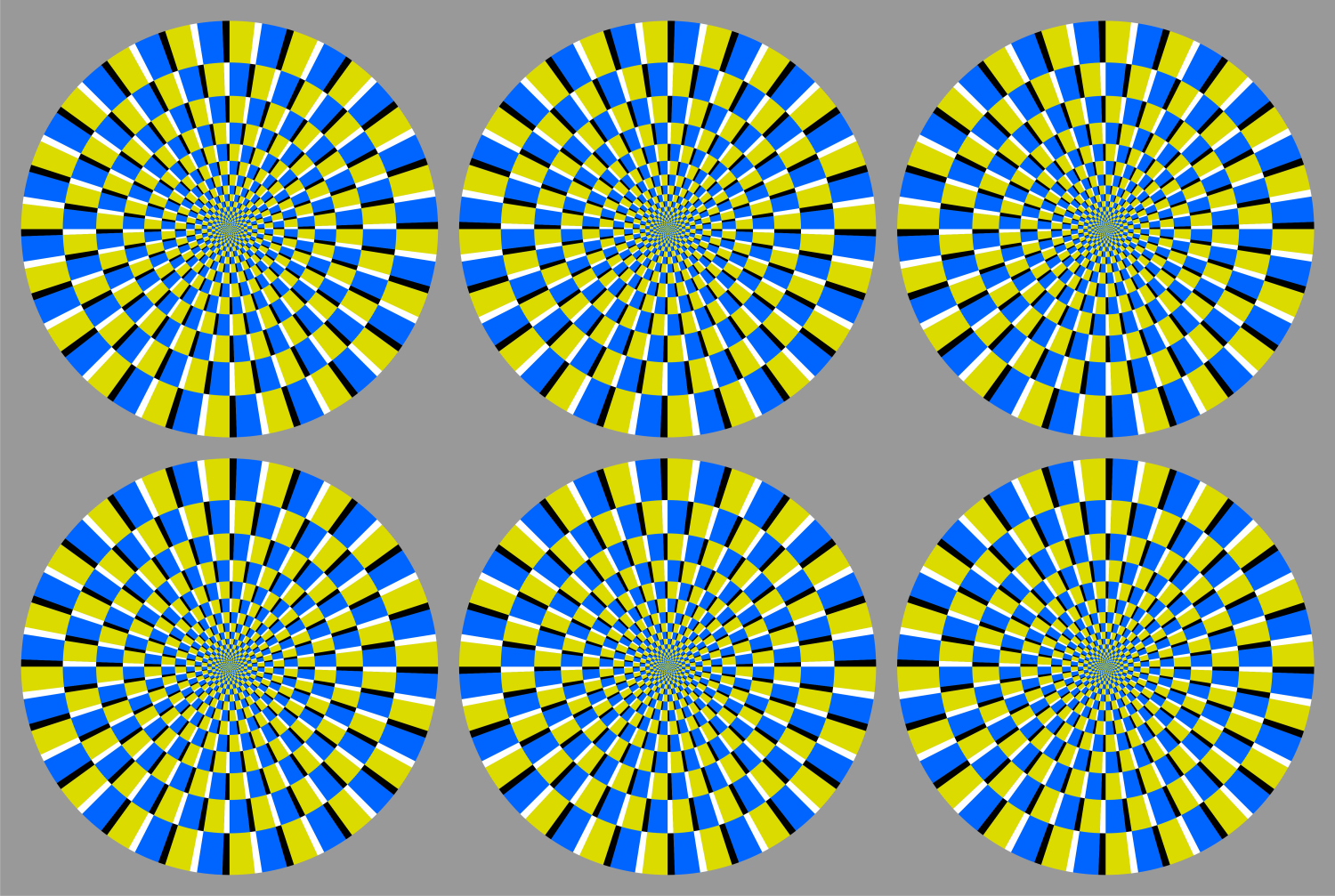
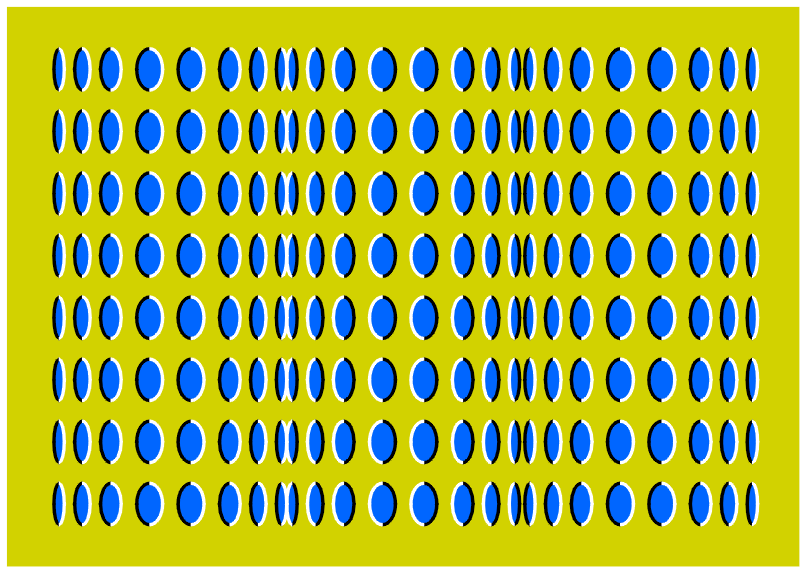
"Rollers"
Rollers appear to rotate without effort. On the other hand, they appear to rotate in the opposite direction when observers see this image keeping blinking.
Copyright A.Kitaoka 2004 (April 20)
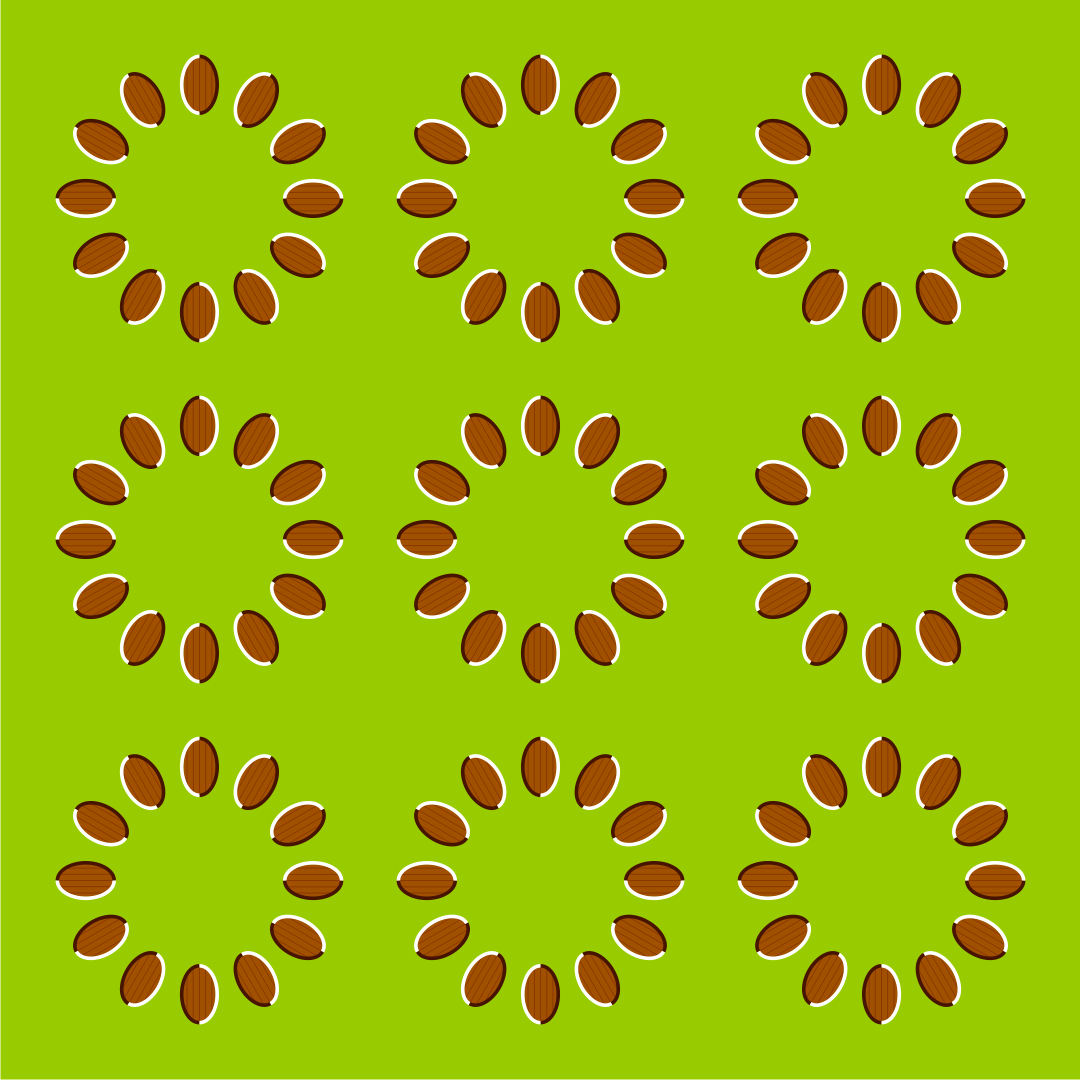
"Dongururin"*
*Rotation of donguri (acorns). "Gururin" means rotation.
Rings of donguri appear to rotate.
Copyright A.Kitaoka 2003 (July 3, 2003)

"Rotating snakes"
Each disk appears to rotate 'spontaneously' in the constant direction, from black to blue, white, yellow, back to black.
Copyright Akiyoshi Kitaoka 2003 (September 2) (updated February 16, 2013)
Age and illusion
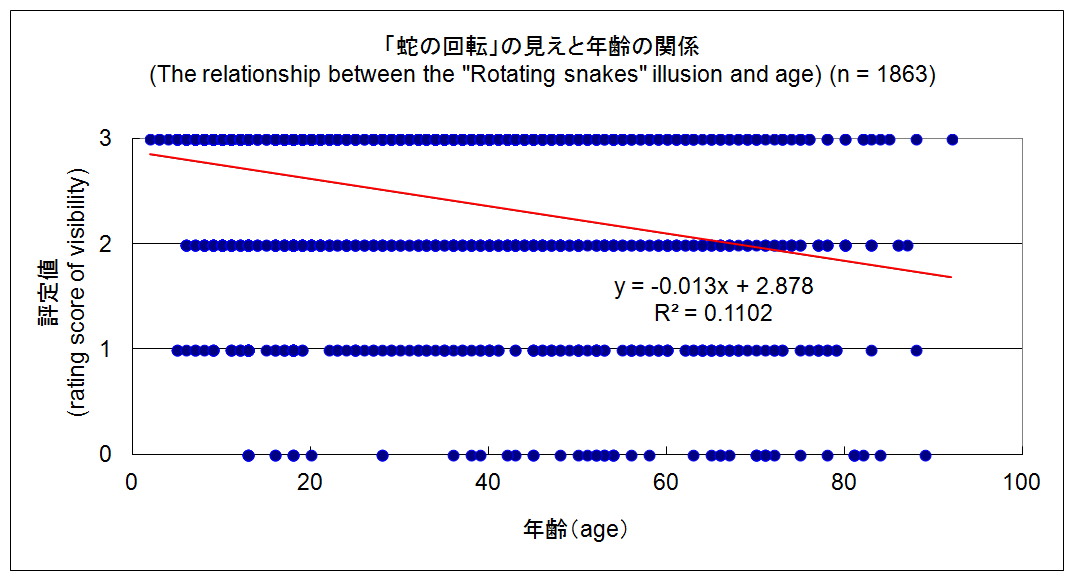
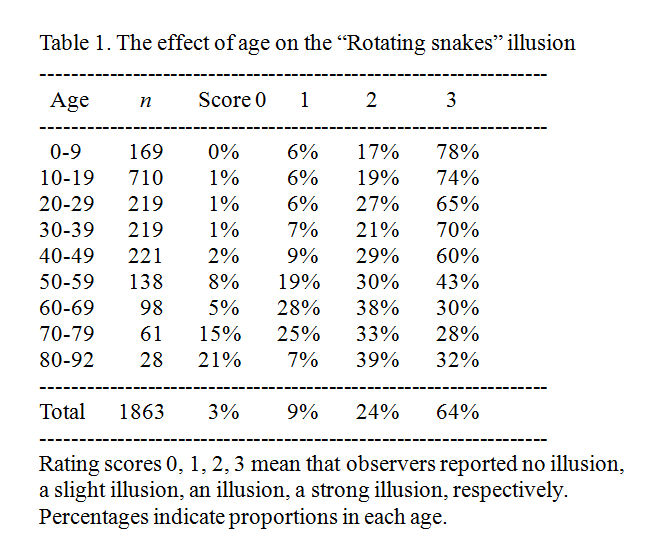
Another luminance step type (Type III)

<Example> The upper-left, upper-right, and lower-middle disks appear
to rotate counterclockwise while the rest clockwise.
.jpg)
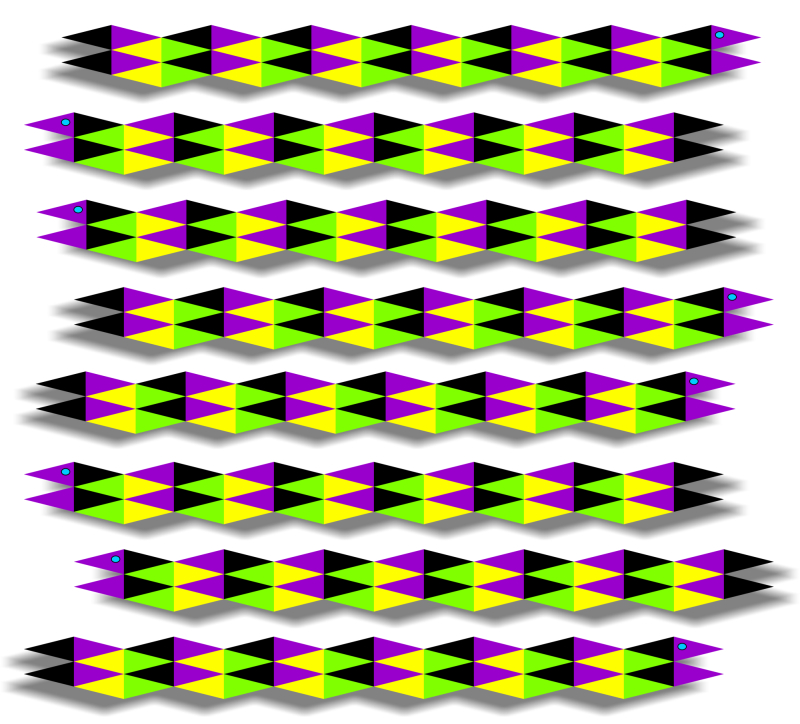
"Moving snakes with shadows"
Snakes appear to move horizontally.
Copyright Akiyoshi Kitaoka 2009 (June 7)
Highlight and shadow type (Type IV)

<Example> The upper-left, upper-right, and lower-middle disks appear
to rotate counterclockwise while the rest clockwise.
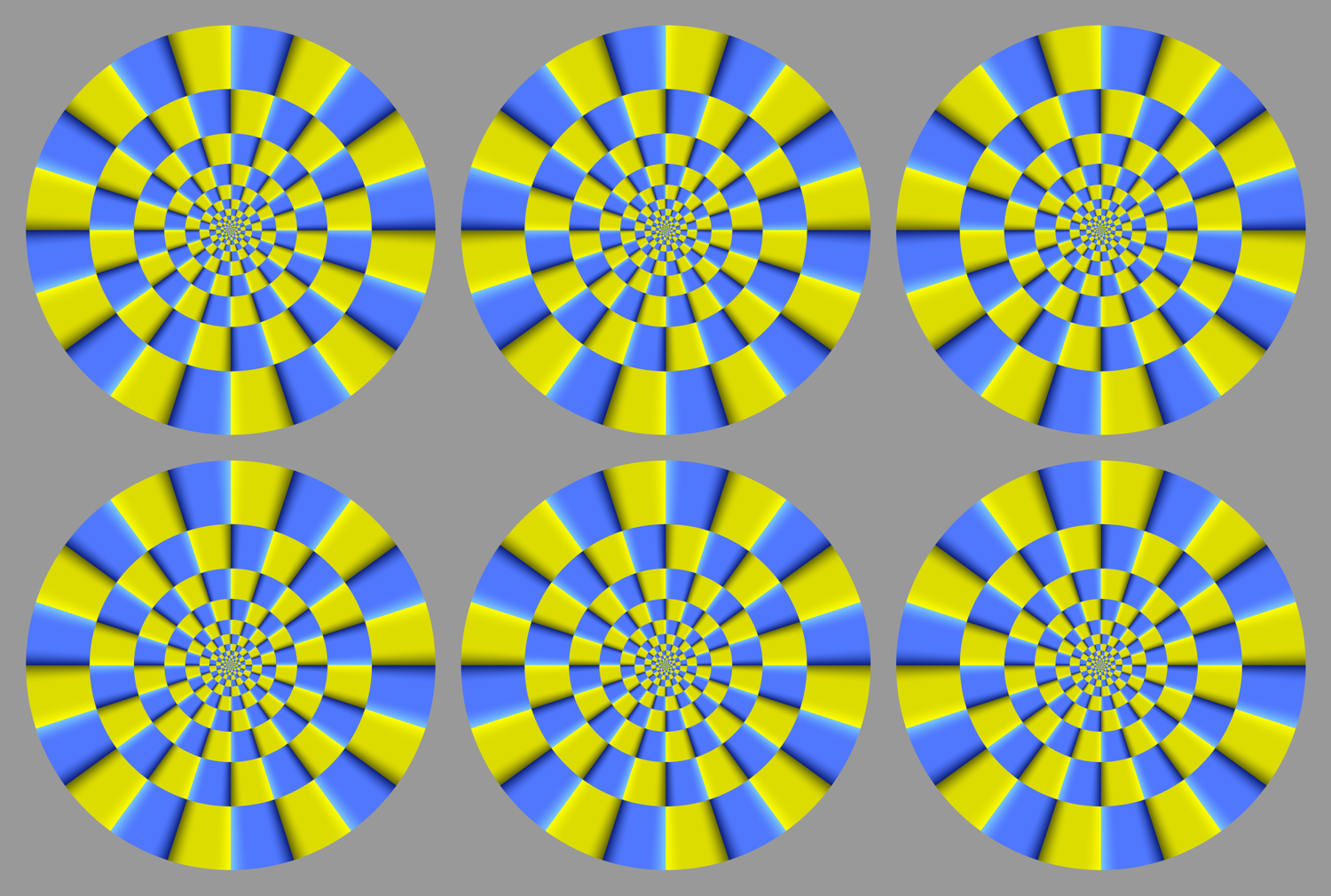
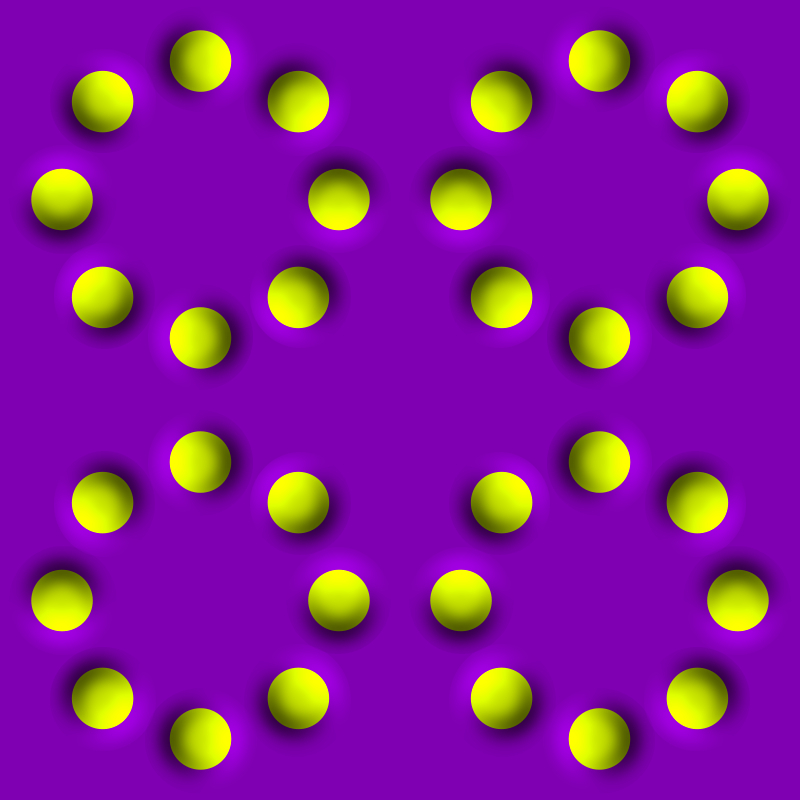
"Rotating tablets"
Rings appear to rotate.
Copyright Akiyoshi Kitaoka 2011 (July 14)
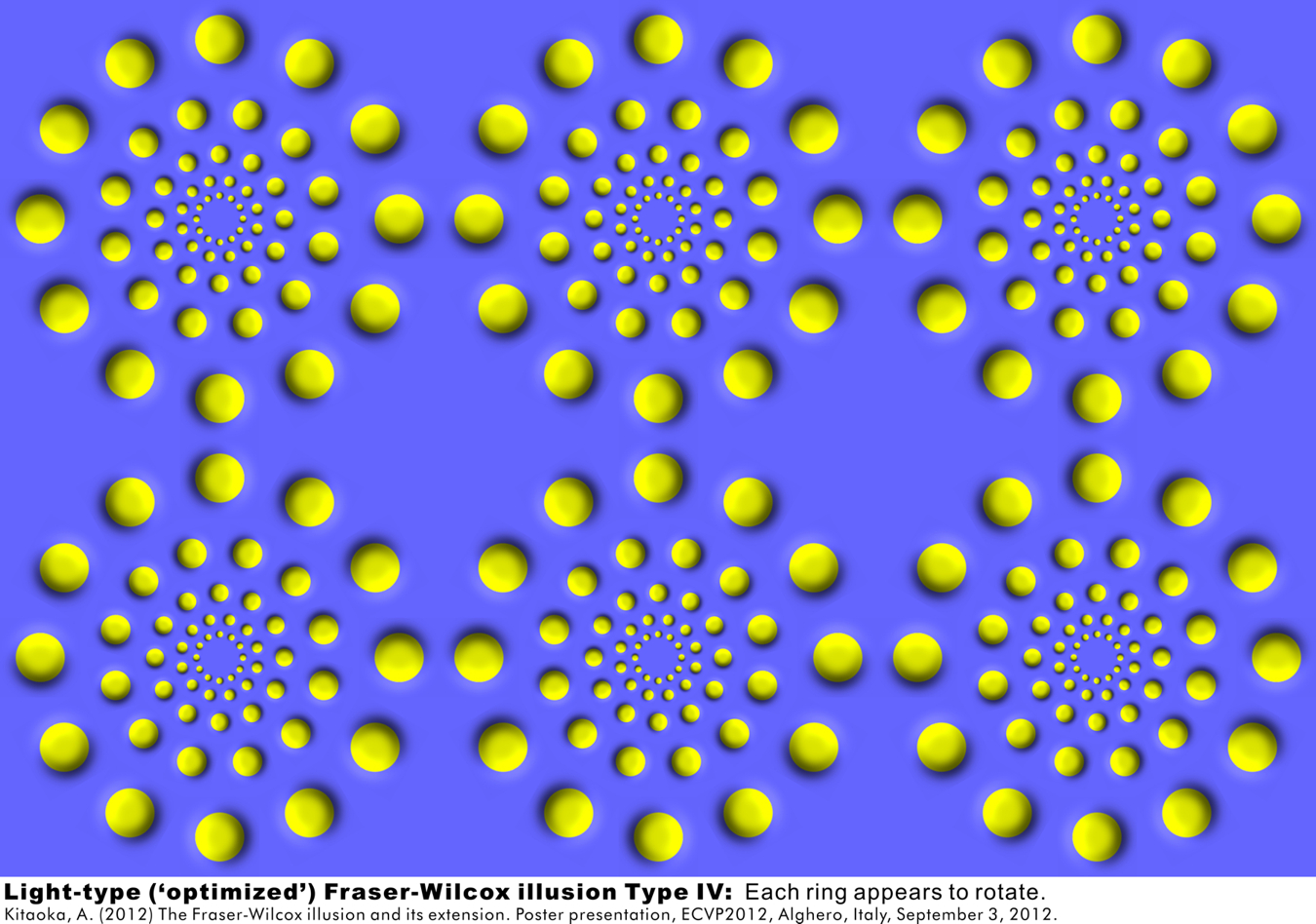
Dark type
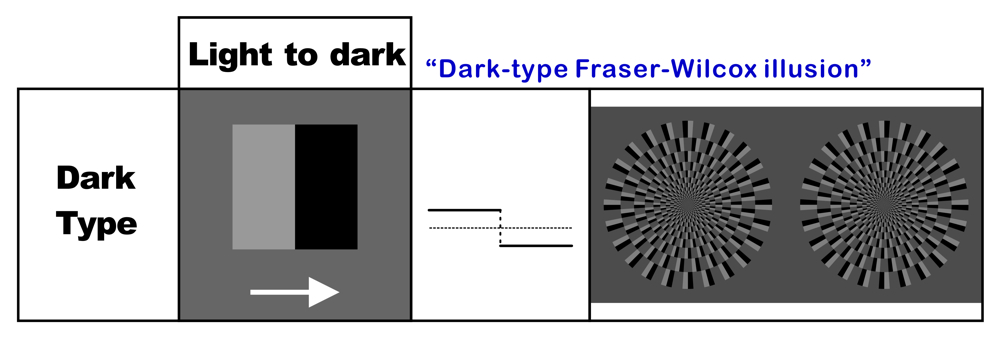
<Example> The upper-left, upper-right, and lower-middle disks appear
to rotate counterclockwise while the rest clockwise.
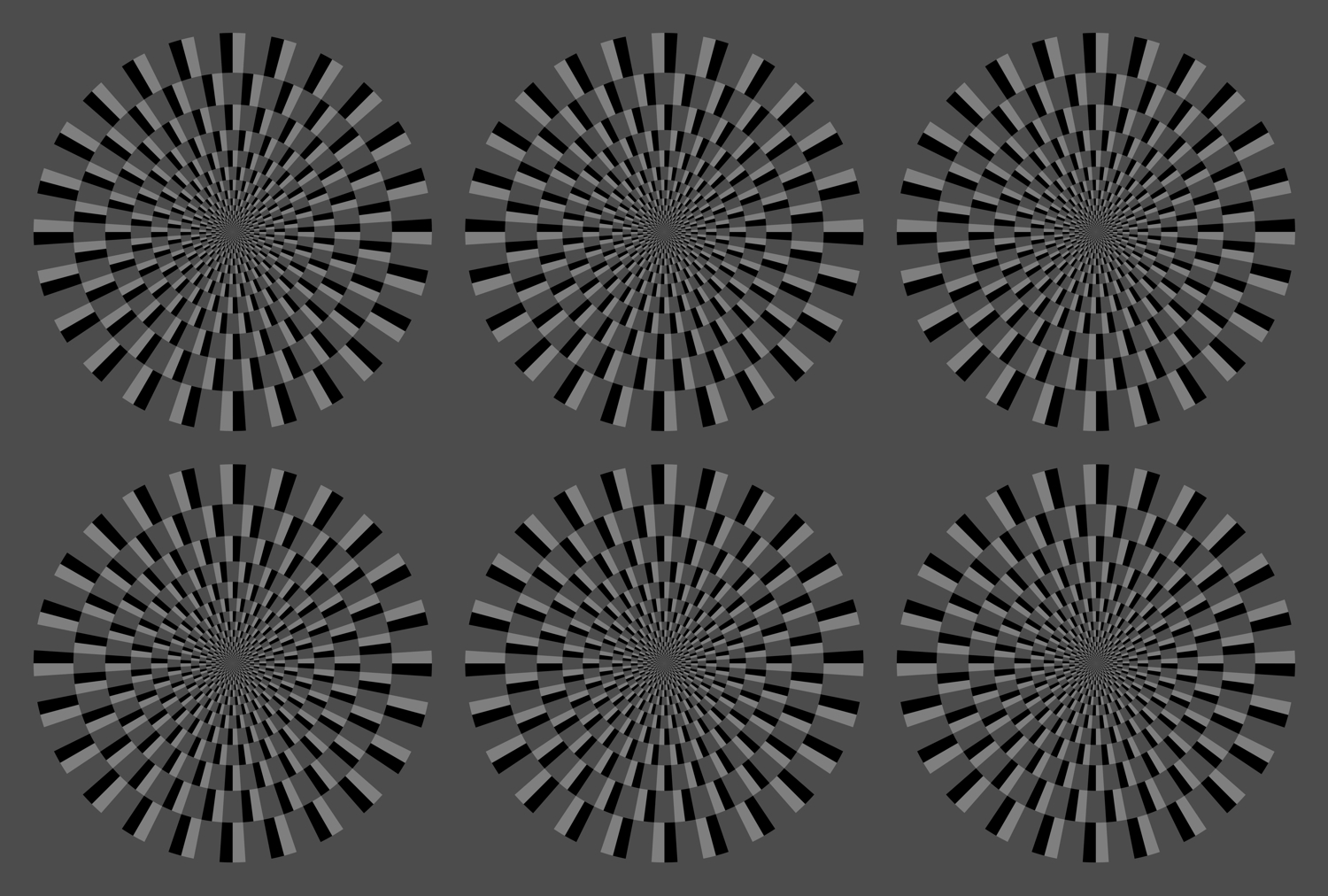
Kitaoka, A. (2012). The Fraser-Wilcox illusion and its extension. Perception 41 ECVP Abstract Supplement, page 91 (Poster September 3, 2012). Poster PDF
Copyright Robert Sekuler
Exception of the dark type
(kind of color-dependent type)
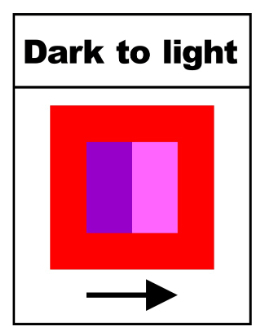
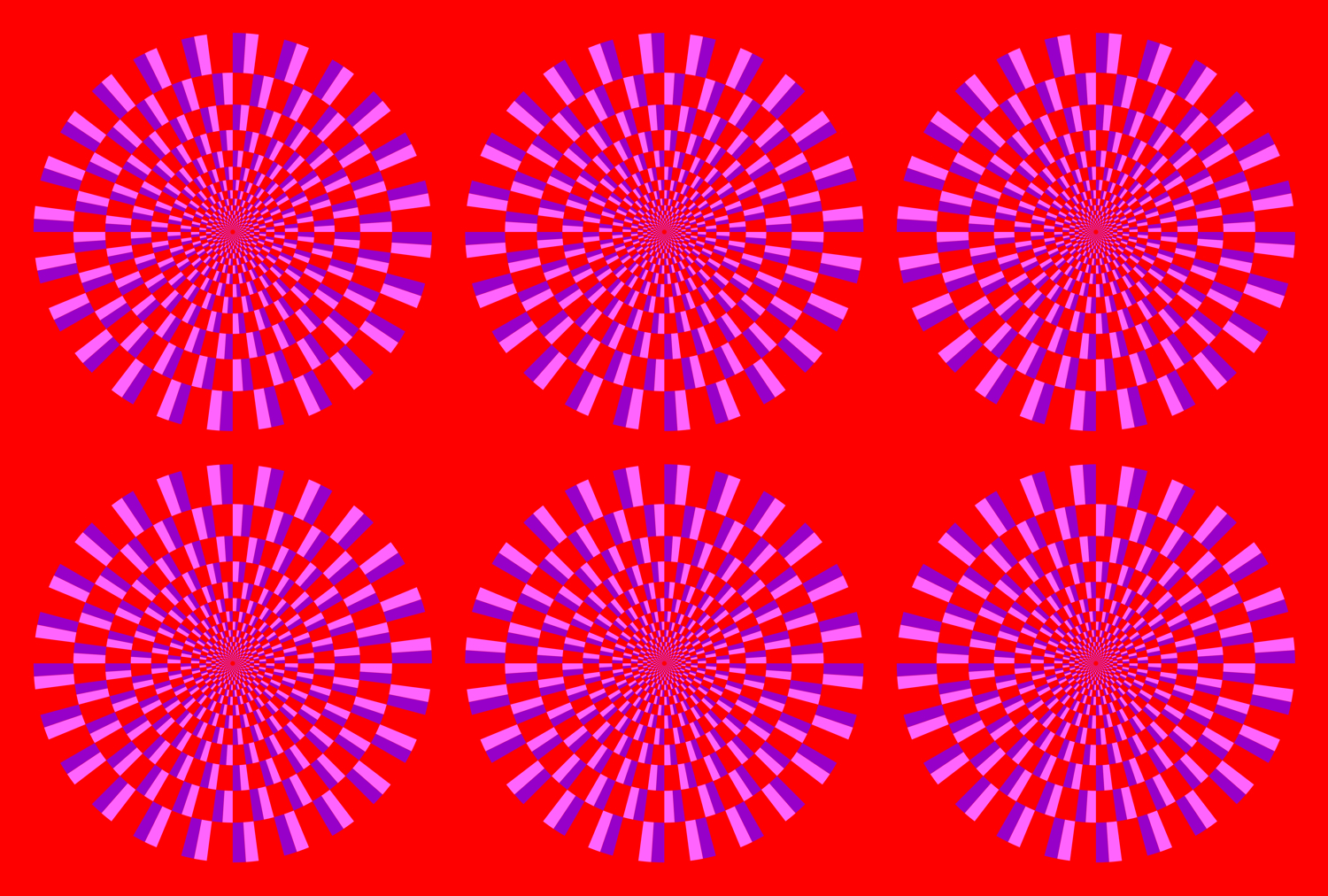
Kitaoka, A. (2012). The Fraser-Wilcox illusion and its extension. Perception 41 ECVP Abstract Supplement, page 91 (Poster September 3, 2012). Poster PDF
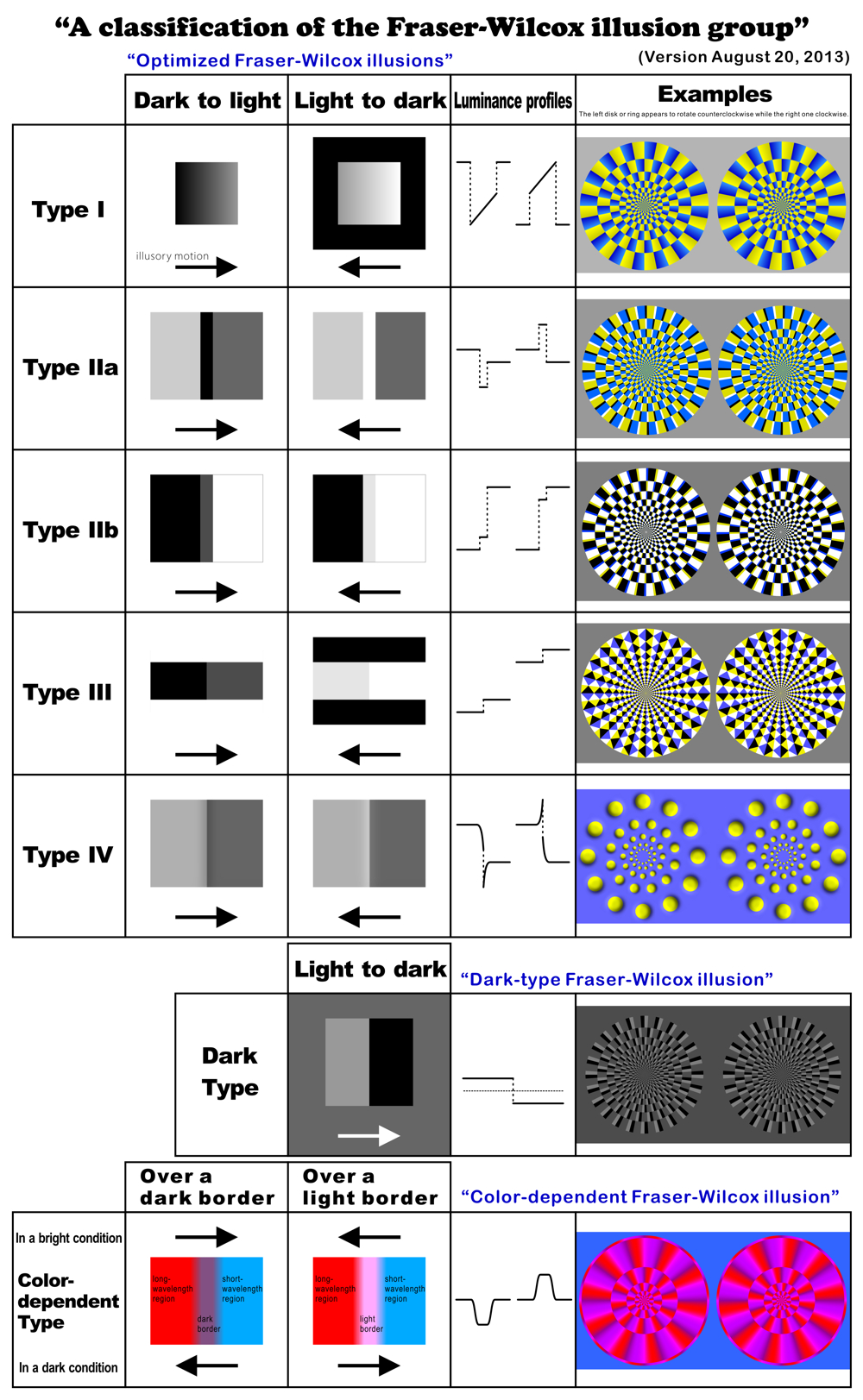
Color-dependent type

Kitaoka, A. (2014). Color-dependent motion illusions in stationary images and their phenomenal dimorphism. Perception, 43(9), 914-925.
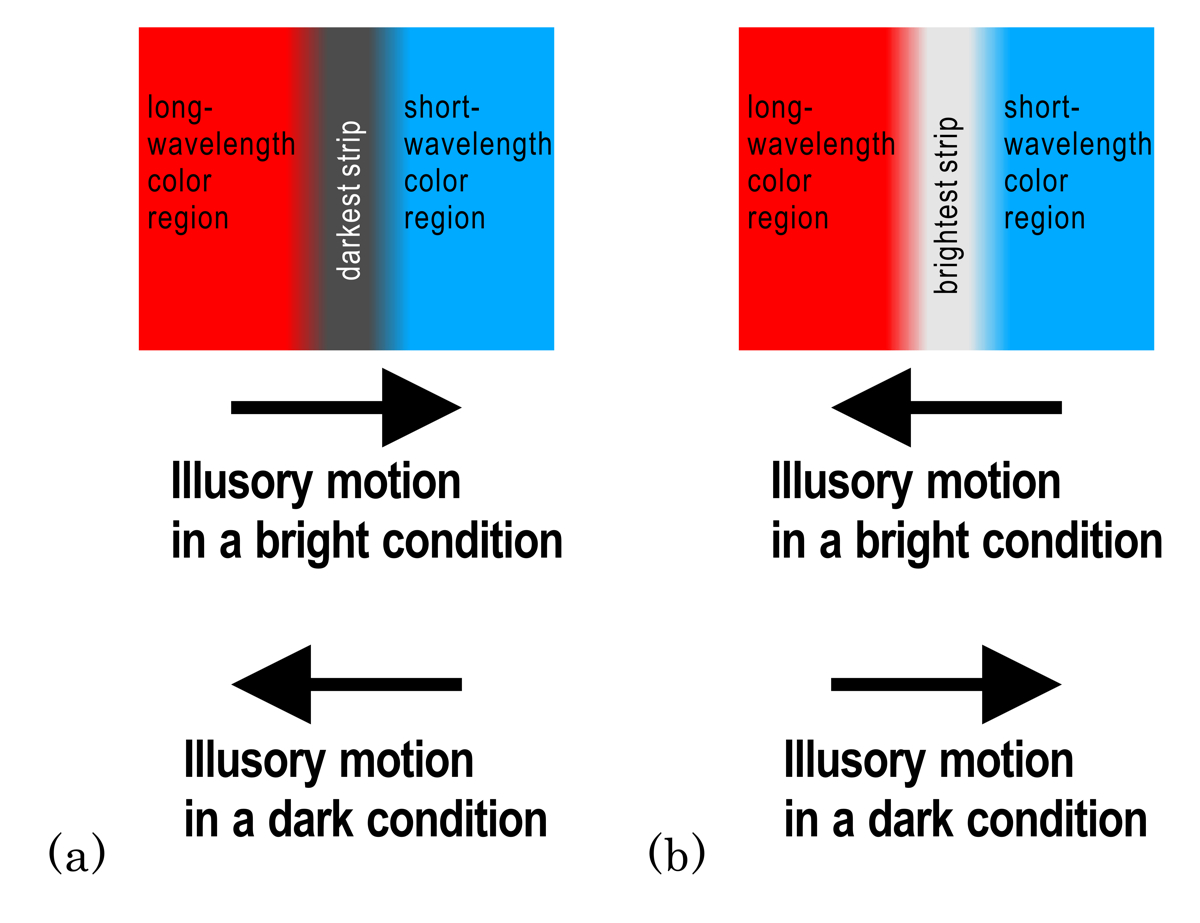
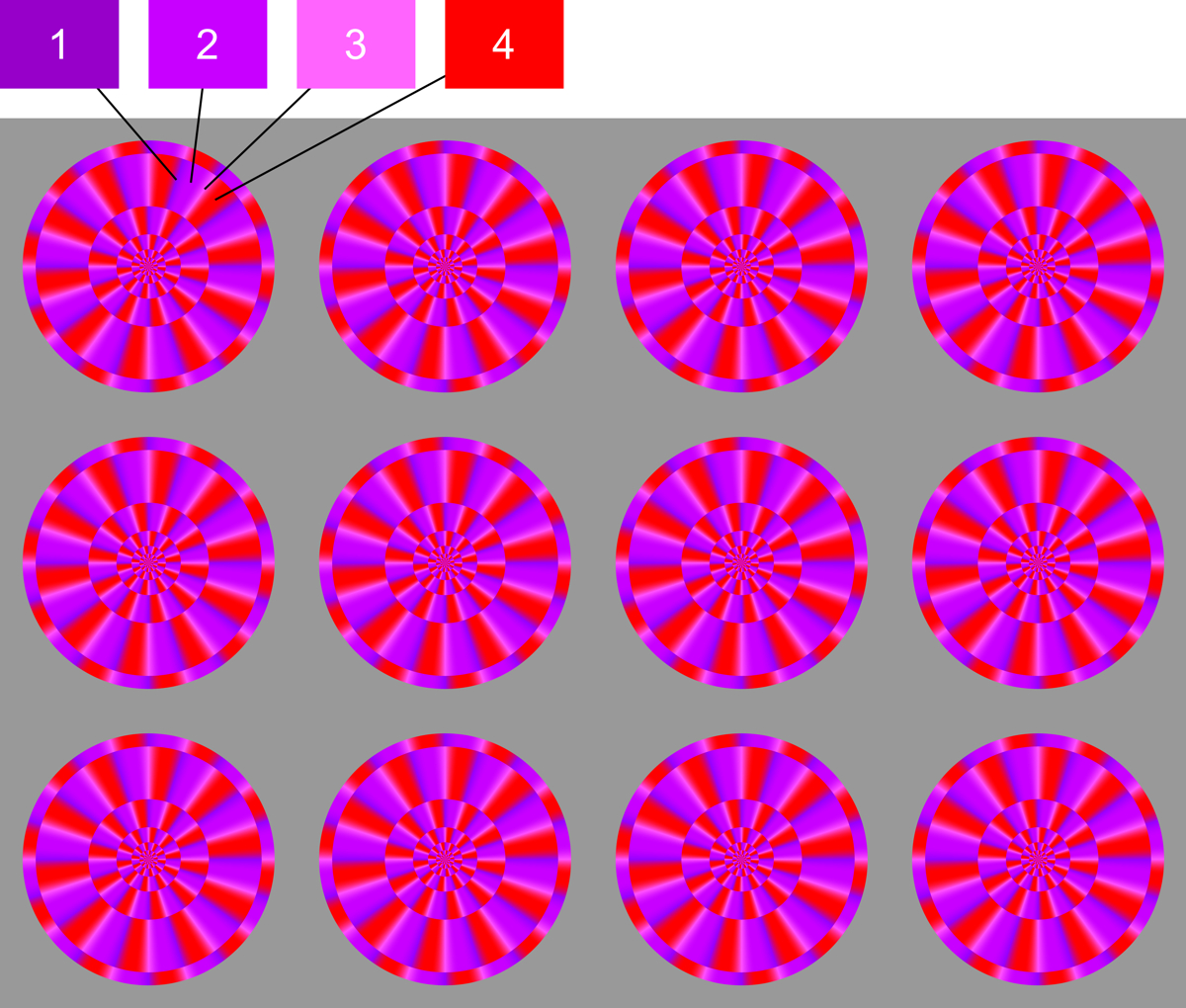
Figure 6 of Kitaoka, A. (2014). Color-dependent motion illusions in stationary
images and their phenomenal dimorphism. Perception, 43(9), 914-925.
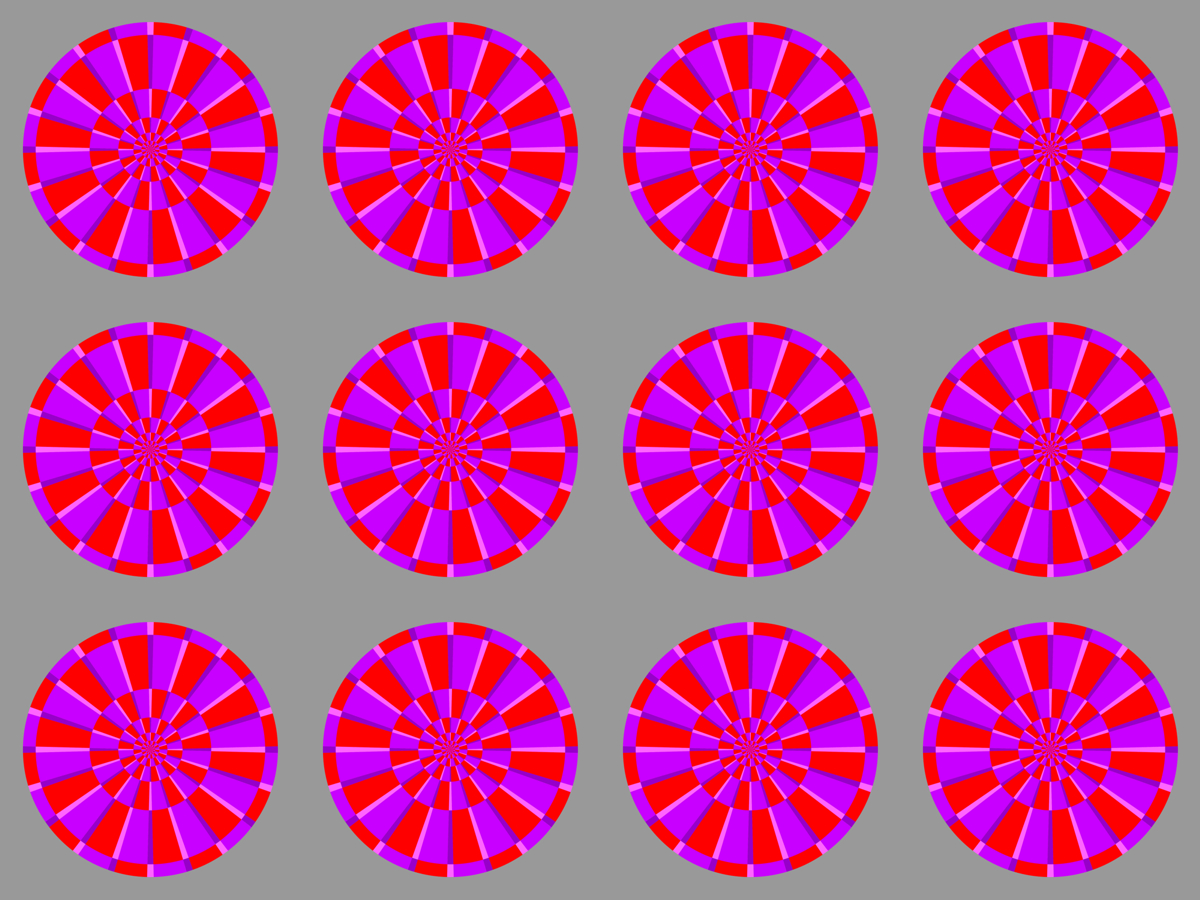
Illusion remains when the image is not blurred.
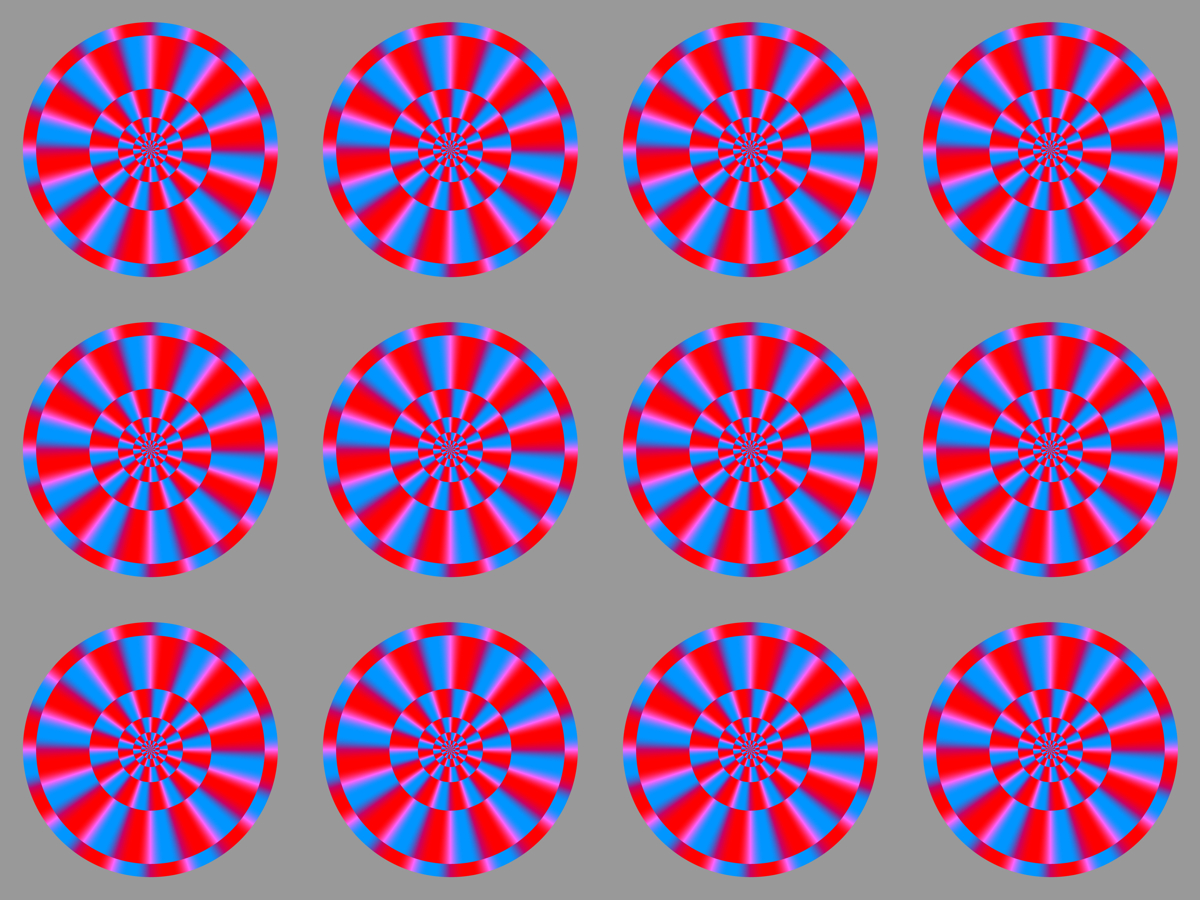
Illusion occurs with red and blue.
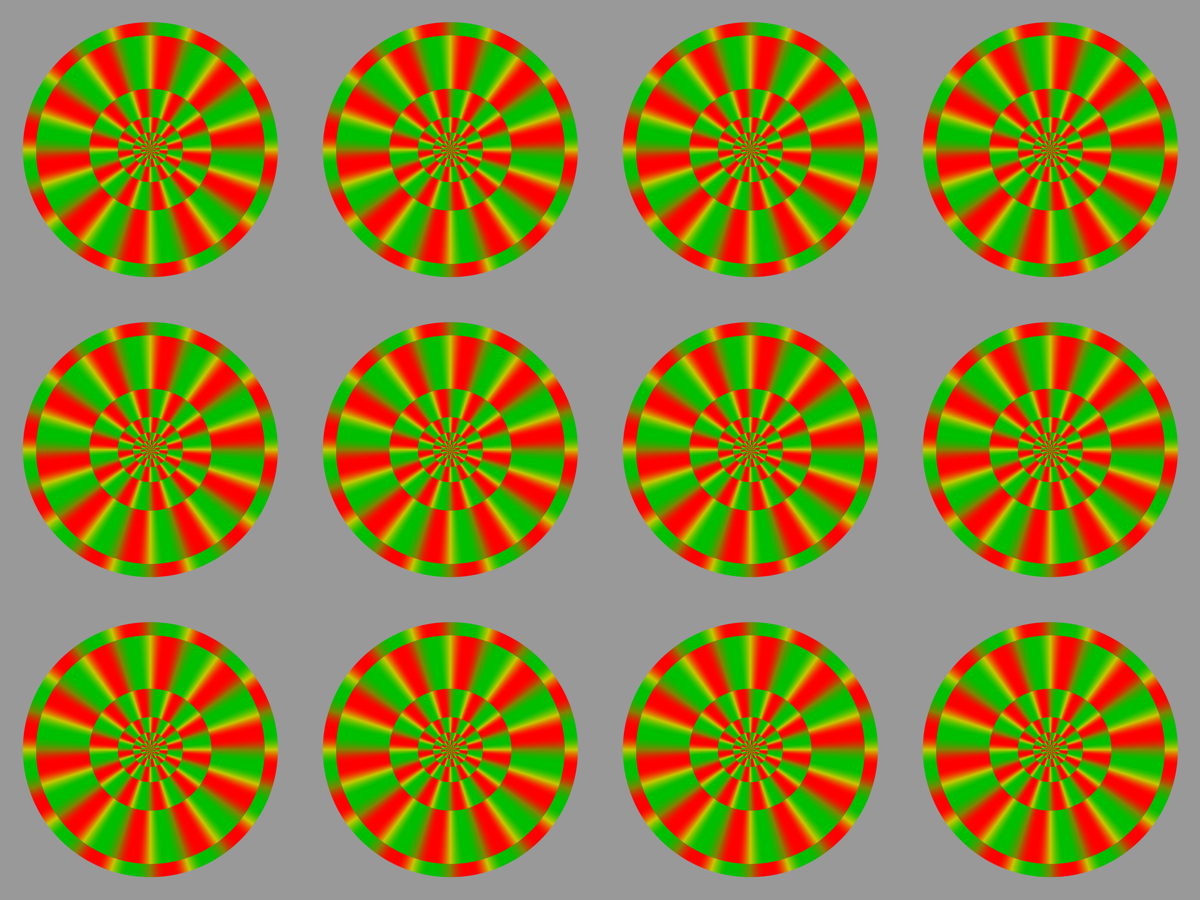
Illusion occurs with red and green.
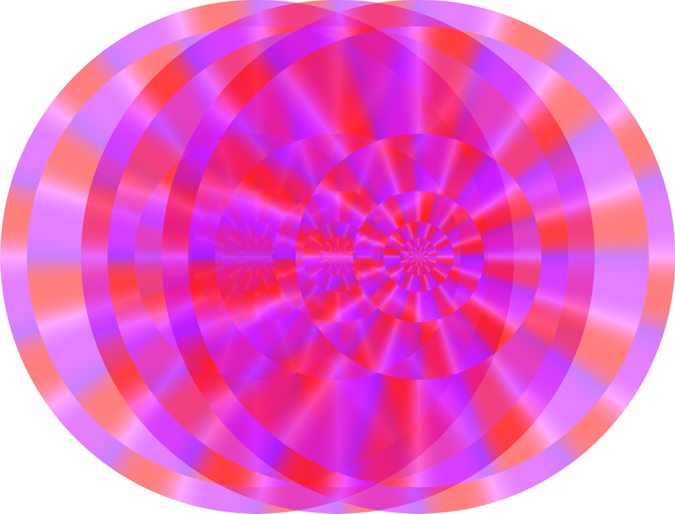
Illusion is triggered by moving images, blinks or eye movements.
Yanaka, K. and Hilano, T. (2011). Mechanical shaking system to enhance "Optimized Fraser–Wilcox Illusion Type V". Perception, 40, ECVP Abstract Supplement, page 171.
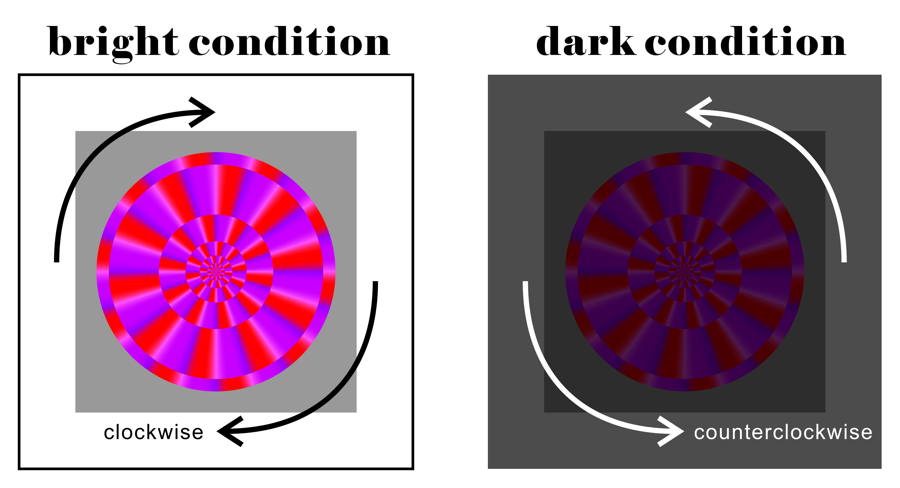
Illusion is reversed depending on luminance or light/dark adaptation.
Kitaoka, A. and Yanaka, H. (2013). Reversal of the color-dependent Fraser-Wilcox illusion under a dark condition. Perception 42 (36th) ECVP (Bremen) Abstract Supplement, page 97 (Poster August 27, 2013). Poster PDF
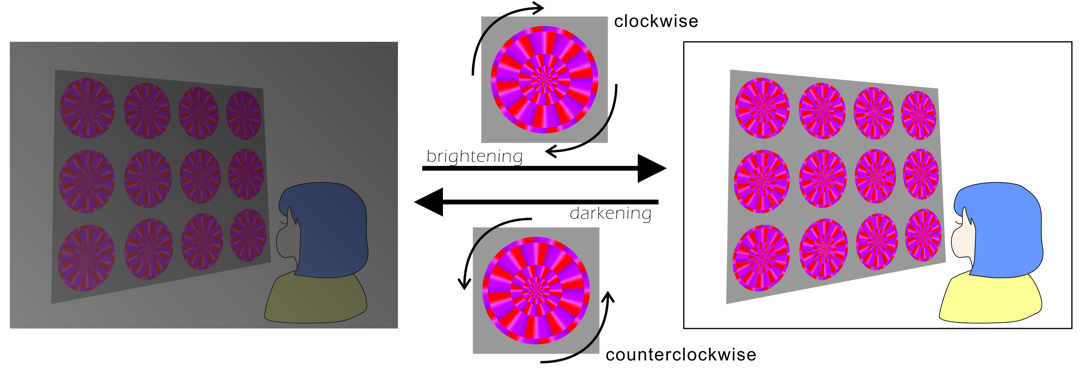
Illusion is reversed depending on the change of luminance.
Kitaoka, A. and Yanaka, H. (2013). Reversal of the color-dependent Fraser-Wilcox illusion under a dark condition. Perception 42 (36th) ECVP (Bremen) Abstract Supplement, page 97 (Poster August 27, 2013). Poster PDF
Directions of illusory motion depending on changes of luminance in each
area
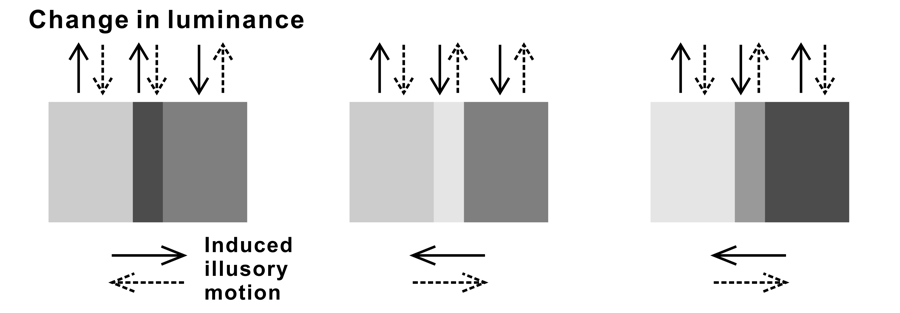

14. Kitaoka (2013)
It is suggested that this ‘luminance change-induced’ motion* might generate
the color-dependent Fraser-Wilcox illusion, being triggered by saccades,
blinks, flickering or shaking the images.
*The luminance change-induced’ motion includes the reverse phi phenomenon
(Anstis, 1970; Anstis and Rogers, 1975) and the phenomenal phenomena (Gregory
and Heard, 1983). Directions of illusory motion depending on the changes
of luminance are shown in the right (Kitaoka, 2006).
References
Anstis S M, 1970 “Phi movement as a subtraction process” Vision Research 10 1411-1430
Anstis S M, Rogers B J, 1975 “Illusory reversal of visual depth and movement
during changes of contrast” Vision Research 15 957-961
Gregory R L, Heard P F, 1983 “Visual dissociations of movement, position,
and stereo depth: some phenomenal phenomena” Quarterly Journal of Experimental
Psychology 35A 217-237
Kitaoka, A. (2006). Configurational coincidence among six phenomena: A
comment on van Lier and Csathó (2006). Perception,
35, 799-806. animations --- PDF
"Rotating gray-scale disks (movie)"
Disks appear to rotate clockwise or counterclockwise.
Copyright Akiyoshi Kitaoka 2013 (February 15)
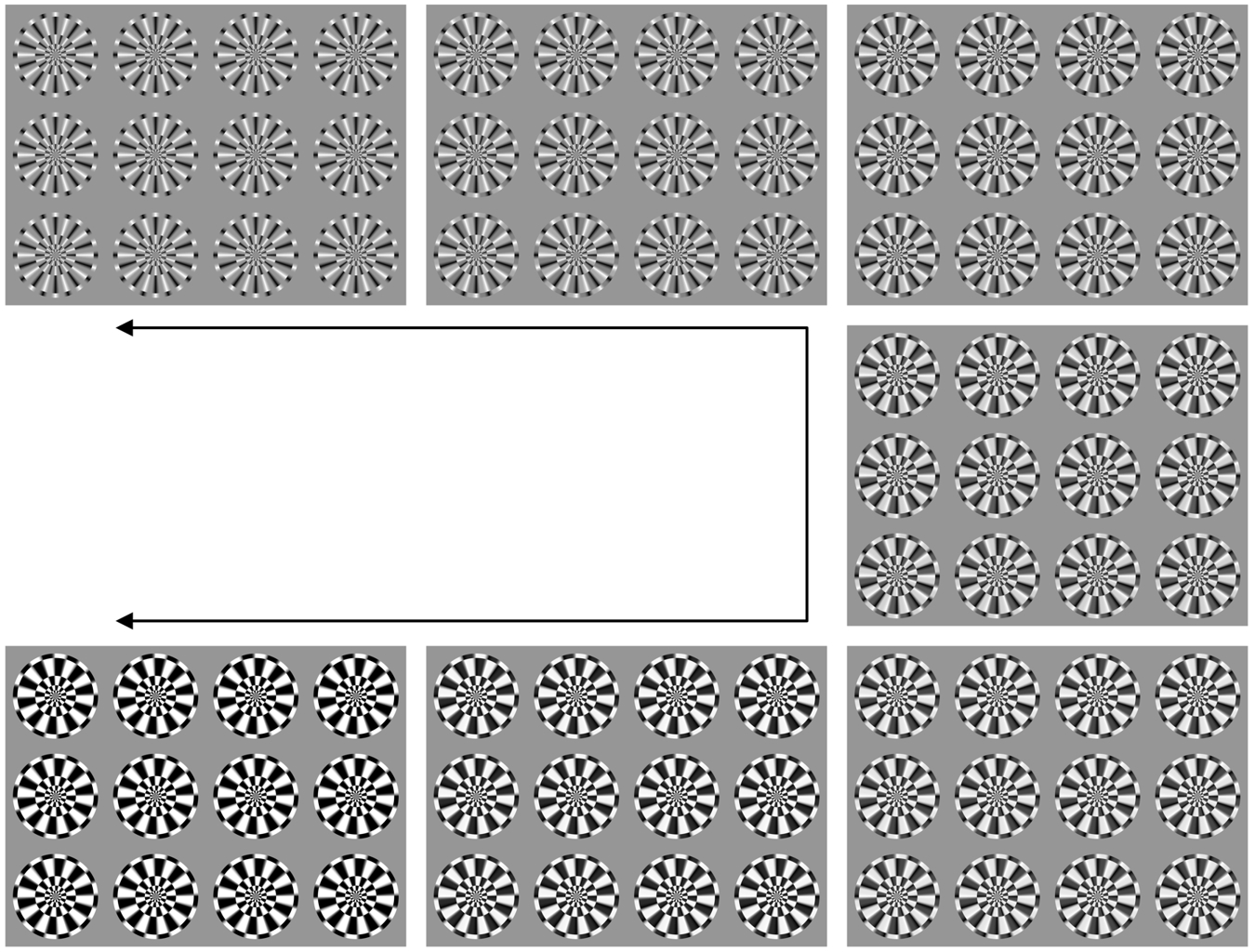
輝度変調誘導性の運動錯視
luminance change-induced motion illusion
Configurational coincidence among six phenomena: A comment to van Lier
and Csathó (2006)
Kitaoka, A. (2006). Configurational coincidence among six phenomena: A comment on van Lier and Csathó (2006). Perception, 35, 799-806. animations --- PDF
Adobe Flash Player is necessary to play animations on this page.
Animation 1
Reversed phi movement (Anstis and Rogers 1975). There are four rectangles, each of which is flanked by thin lines that are dark or light. When the luminance of the rectangles decreases and that of the background increases accordingly, the upper two appear to converge in motion while the lower two appear to go apart in motion. On the other hand, when the luminance of the rectangles increases and that of the background decreases accordingly, the upper two appear to go apart in motion while the lower two appear to approach each other in motion. In sum, the direction of apparent motion is from the dark flank to the neighboring part that goes darkening or from the light flank to the neighboring part that goes brightening. Although the rectangles are aligned vertically, the apparent positional displacement occurs in the opposite direction to motion. If observers cross-fuse (uncross-fuse) the right and left rectangles, the upper rectangle appears to be in front of (behind) the lower one when they are dark.
Animation 2
The illusory motion investigated by Gregory and Heard (1983). This appearance is quite similar to Animation 1. The only configurational difference from the reversed phi movement is that the luminance of the rectangles is constant.
Animation 3
The illusory motion mentioned by Gregory and Heard (1983), in which the luminance of the rectangles dynamically changes while that of the surround is constant. This appearance is quite similar to Animations 1 and 2.
Animation 4
Phi movement (Anstis and Rogers 1975). For panel (a), dark stationary rectangles are placed on a bright stationary background. When the luminance of the right flank of each rectangle increases and that of the left flank decreases, the rectangle appears to shift leftward in motion as well as in position. Conversely, the luminance of the right flank decreases and that of the left flank increases, the rectangle appears to shift rightward in motion and position. If observers cross-fuse (uncross-fuse) the right and left rectangles, the fused rectangle appears to be in front (behind) when the right flank of the right rectangle are dark and the left flank of the left rectangle are dark. For panel (b), bright rectangles are placed on a dark background. In this case, phenomena are the reversal of panel (a).
(a) (b)
(a) Flash(swf) --- QuickTime(mov)
(b) Flash(swf) --- QuickTime(mov)
Animation 5
Consistency between the reversed phi movement and stereopsis (Anstis and Rogers 1975). In this animation, there are two phases in motion, in which the upper-left and the lower-right rectangles are one eighth phase in advance of the upper-right and the lower-left rectangles. For example, when the luminance of the rectangles increases, the upper-left rectangle appear to go leftward followed by the upper-right one, while the lower-right rectangle appear to go leftward followed by the lower-left one. In this period, the cross-fused (uncross-fused) upper rectangle appears to be in front (behind) as compared with the cross-fused (uncross-fused) lower rectangle.
Animation 6
Consistency between the apparent motion and Café-Wall-like tilt illusions (van Lier and Csathó 2005). According to dynamic changes in luminance gradient, the flanks of the rectangle appears to tilt dynamically. (a) The luminance gradient given to both flanks is dynamically changed while the dark-gray rectangle and the light-gray background are stationary. The dark part of the gradient appears to shift outward in motion and position while the bright part appears to shift inward in motion and position. This distortion agrees with the tilt illusion. (b) The luminance gradient given to the rectangle is dynamically changed while the dark flanks and the gray background are stationary. At the dark part of the gradient, the neighboring part of flanks appears to shift inward in motion and position, while at the bright part of the gradient, the neighboring part of flanks appears to shift outward in motion and position. This distortion agrees with the tilt illusion.
(a) (b)
(a) Flash(swf) --- QuickTime(mov)
(b) Flash(swf) --- QuickTime(mov)
Animation 7
Inconsistency between the apparent motion and Café-Wall-like tilt illusions. According to dynamic changes in homogenous areas, the flanks of the rectangle appears to tilt dynamically. (a) The luminance of the homogeneous rectangle is dynamically changed while the flanks with luminance gradient and the gray background are stationary. The darkening rectangle appears to attract the dark parts of the flanks inward in motion while the brightening rectangles appears to attract the light parts of the flanks inward in motion. This distortion disagrees with the tilt illusion. (b) The luminance of the homogeneous flanks is dynamically changed while the rectangle with luminance gradient and the gray background are stationary. At the dark part of the gradient, brightening flanks appears to shift inward in motion, while at the bright part of the gradient, darkening flanks appears to shift inward in motion. This distortion disagrees with the tilt illusion
(a) (b)
(a) Flash(swf) --- QuickTime(mov)
(b) Flash(swf) --- QuickTime(mov)
Animation 8
Demonstration of the apparent motion in the three elemental spatio-temporal configurations (Figure 6). The behaviors in (a), (b) and (g) are summarized in Figure 6a (off-center line-type configuration); those in (c), (d) and (h) are in Figure 6b (on-center line-type configuration); and those in (e), (f) and (i) are summarized in Figure 6c (edge-type configuration). For further explanations, see the text.
(a) (b)
(a) Flash(swf) --- Quicklime(mov)
(b) Flash(swf) --- QuickTime(mov)
(c) (d)
(c) Flash(swf) --- QuickTime(mov)
(d) Flash(swf) --- QuickTime(mov)
(e) (f)
(e) Flash(swf) --- QuickTime(mov)
(f) Flash(swf) --- QuickTime(mov)
(g) (h) (i)
(g) Flash(swf) --- QuickTime(mov)
(h) Flash(swf) --- QuickTime(mov)
(i) Flash(swf) --- QuickTime(mov)
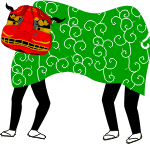 おしまい
おしまい


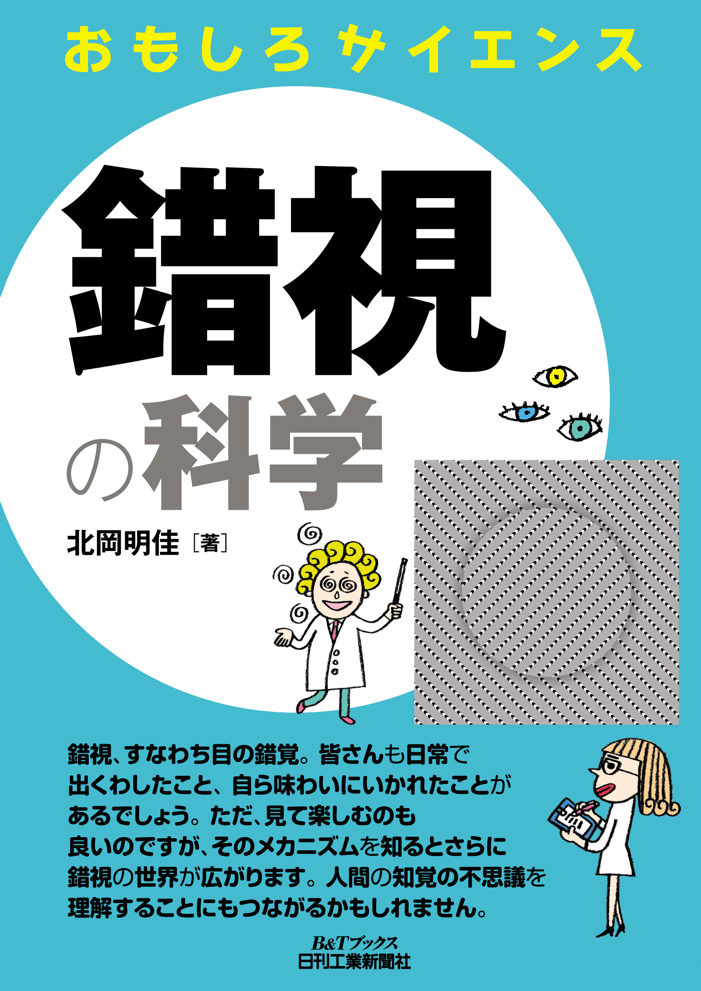
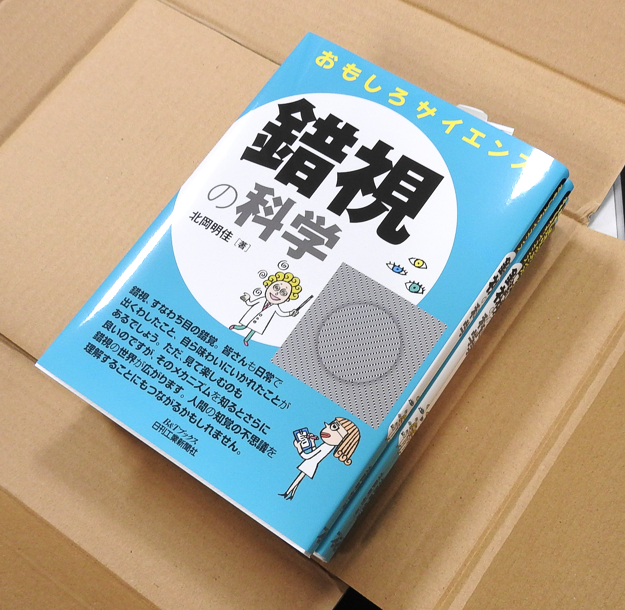
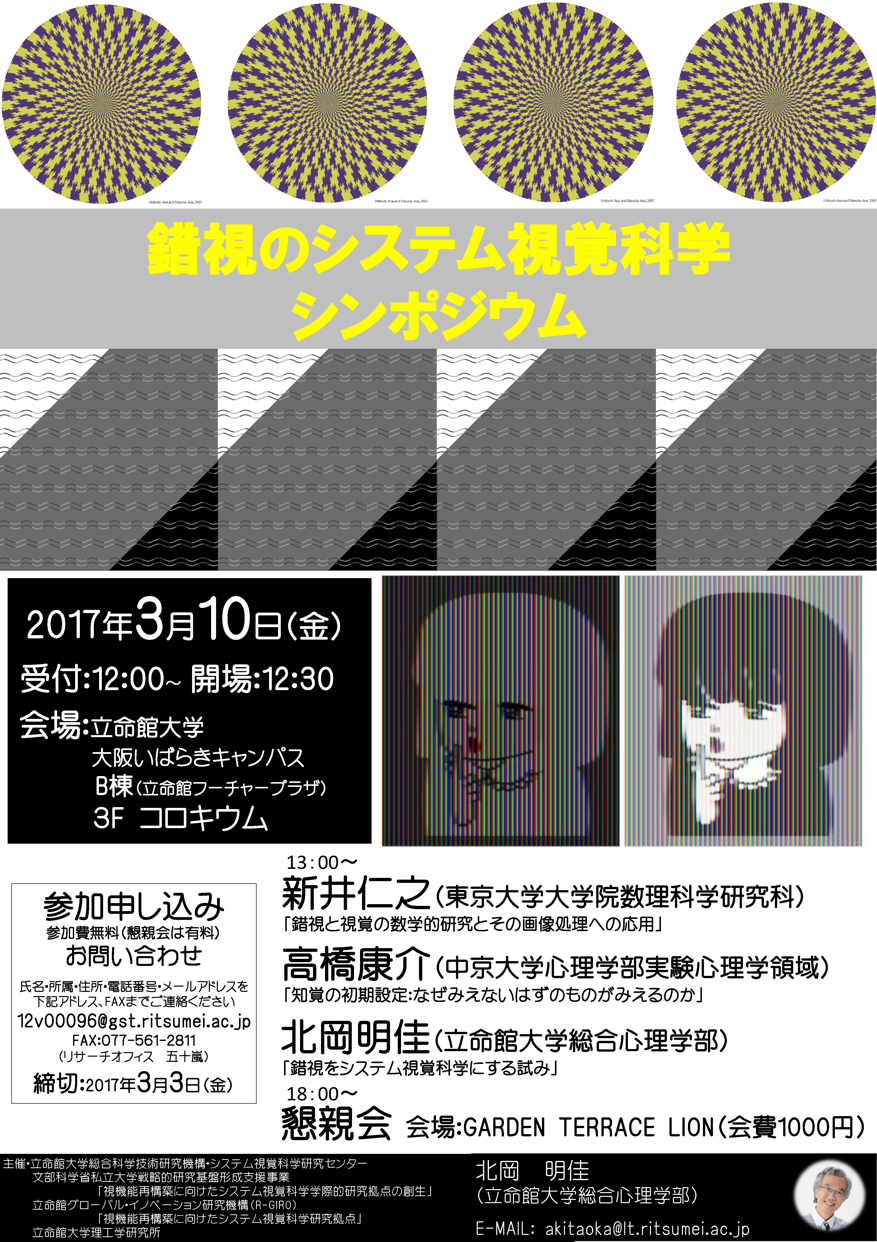
13:00-13:10 開会挨拶
13:10-14:25 新井先生
14:25-14:35 休憩
14:35-15:50 高橋先生
15:50-16:00 休憩
16:00-17:15 北岡先生
17:15-17:40 ディスカッション・閉会挨拶
18:00〜 懇親会